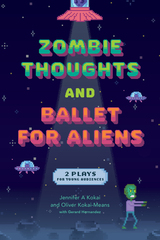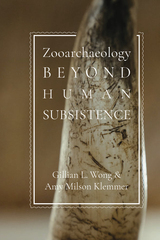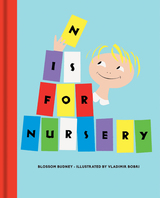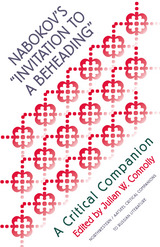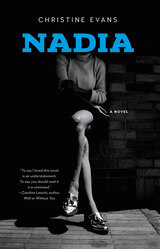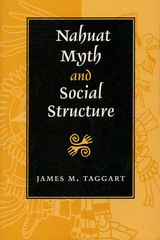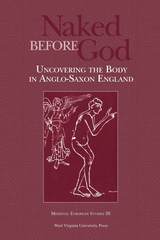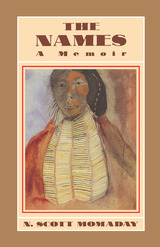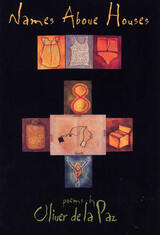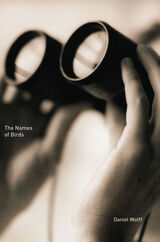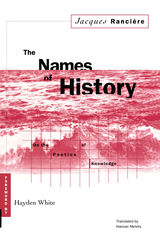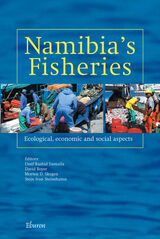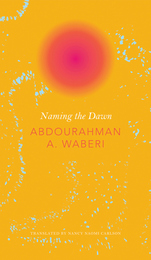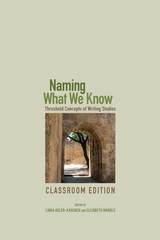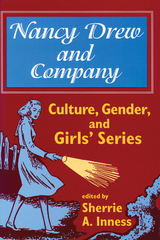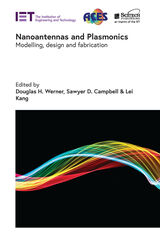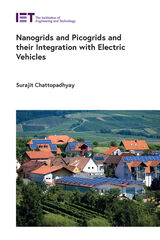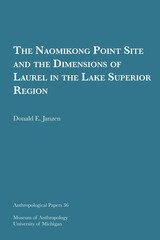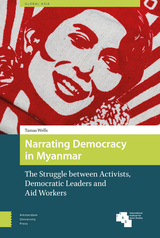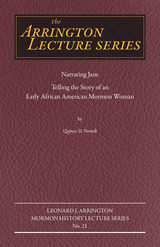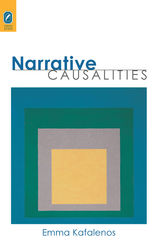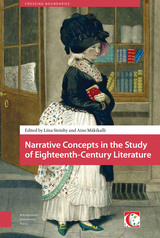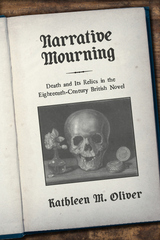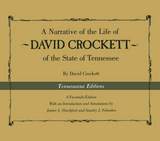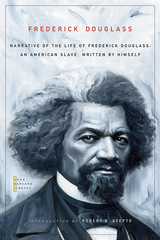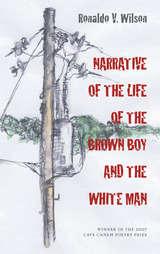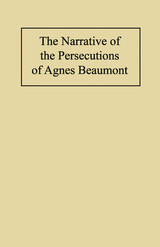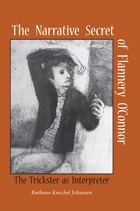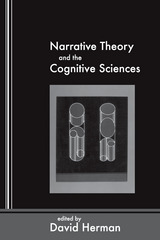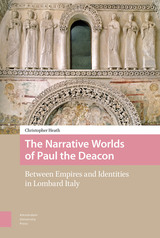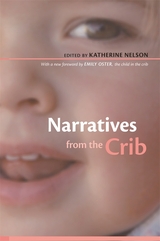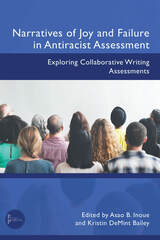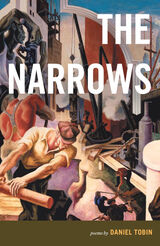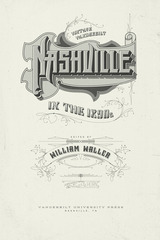N Is for Nursery
Blossom Budney
Bodleian Library Publishing, 2017 A is for all of us—everyone. Playing, learning, having fun.
The letters of the alphabet are brilliantly brought to life in a bright nursery school, where the children learn and play. B is for building blocks . . . but also for blowing out the candles on a birthday cake! C is for the colorful chairs the children take when the teacher rings a chime. Lively pictures designed around each letter show the children dancing, singing, listening to stories, tickling one another, and even engaging in an exciting game of tug-of-war. The fun rhymes and imaginative words for each letter make N is for Nursery a great book for children just learning to read and to recognize letters and letter sounds.
Originally published in 1956, N is for Nursery is the most recent addition to the Bodleian Library’s children’s book imprint and the perfect book for children to take with them on a new adventure like starting school.
 Na Kua`aina: Living Hawaiian Culture
Davianna Pomaika`i McGregor
University of Hawaii Press, 2007 The word kua‘âina translates literally as "back land" or "back country." Davianna Pômaika‘i McGregor grew up hearing it as a reference to an awkward or unsophisticated person from the country. However, in the context of the Native Hawaiian cultural renaissance of the late twentieth century, kua‘âina came to refer to those who actively lived Hawaiian culture and kept the spirit of the land alive. The mo‘olelo (oral traditions) recounted in this book reveal how kua‘âina have enabled Native Hawaiians to endure as a unique and dignified people after more than a century of American subjugation and control. The stories are set in rural communities or cultural kîpuka—oases from which traditional Native Hawaiian culture can be regenerated and revitalized.
By focusing in turn on an island (Moloka‘i), moku (the districts of Hana, Maui, and Puna, Hawai‘i), and an ahupua‘a (Waipi‘io, Hawai‘i), McGregor examines kua‘âina life ways within distinct traditional land use regimes. The ‘òlelo no‘eau (descriptive proverbs and poetical sayings) for which each area is famous are interpreted, offering valuable insights into the place and its overall role in the cultural practices of Native Hawaiians. Discussion of the landscape and its settlement, the deities who dwelt there, and its rulers is followed by a review of the effects of westernization on kua‘âina in the nineteenth century. McGregor then provides an overview of social and economic changes through the end of the twentieth century and of the elements of continuity still evident in the lives of kua‘âina. The final chapter on Kaho‘olawe demonstrates how kua‘âina from the cultural kîpuka under study have been instrumental in restoring the natural and cultural resources of the island.
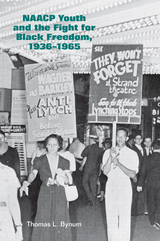 NAACP Youth and the Fight for Black Freedom, 1936–1965
Thomas Bynum
University of Tennessee Press, 2014 Historical studies of black youth activism have until now focused almost exclusively on the activities of the Congress of Racial Equality (CORE) and the Student Nonviolent Coordinating Committee (SNCC). However, the NAACP youth councils and college chapters predate both of those organizations. They initiated grassroots organizing efforts and nonviolent direct-action tactics as early as the 1930s and, in doing so, made significant contributions to the struggle for racial equality in the United States.
This deeply researched book breaks new ground in an important and compelling area of study. Thomas Bynum carefully examines the activism of the NAACP youth and effectively refutes the perception of the NAACP as working strictly through the courts. His research illuminates the many direct-action activities undertaken by the young people of the NAACP — activities that helped precipitate the breakdown of racial discrimination and segregation in America. Beginning with the formal organization of the NAACP youth movement under Juanita Jackson, the author traces the group’s activities from their early anti-lynching demonstrations through their post–World War II “withholding patronage” campaigns to their participation in the sit-in protests of the 1960s. He also explores the evolution of the youth councils and college chapters, including their sometime rocky relationship with the national office, and shows how these groups actually provided a framework for the emergence of youth activism within CORE and SNCC.
The author provides a comprehensive account of the generational struggle for racial equality, capturing the successes, failures, and challenges the NAACP youth groups experienced at the national, state, and local levels. He firmly establishes the vital role they played in the history of the civil rights movement in the United States and in the burgeoning tradition of youth activism in the postwar decades.
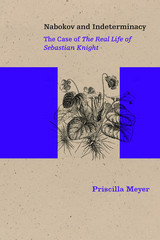 Nabokov and Indeterminacy: The Case of The Real Life of Sebastian Knight
Priscilla Meyer
Northwestern University Press, 2018 In Nabokov and Indeterminacy, Priscilla Meyer shows how Vladimir Nabokov’s early novel The Real Life of Sebastian Knight illuminates his later work. Meyer first focuses on Sebastian Knight, exploring how Nabokov associates his characters with systems of subtextual references to Russian, British, and American literary and philosophical works. She then turns to Lolita and Pale Fire, applying these insights to show that these later novels clearly differentiate the characters through subtextual references, and that Sebastian Knight’s construction models that of Pale Fire.
Meyer argues that the dialogue Nabokov constructs among subtexts explores his central concern: the continued existence of the spirit beyond bodily death. She suggests that because Nabokov’s art was a quest for an unattainable knowledge of the otherworldly, knowledge which can never be conclusive, Nabokov’s novels are never closed in plot, theme, or resolution—they take as their hidden theme the unfinalizability that Bakhtin says characterizes all novels.
The conclusions of Nabokov's novels demand a rereading, and each rereading yields a different novel. The reader can never get back to the same beginning, never attain a conclusion, and instead becomes an adept of Nabokov’s quest. Meyer emphasizes that, unlike much postmodern fiction, the contradictions created by Nabokov’s multiple paths do not imply that existence is constructed arbitrarily of pre-existing fragments, but rather that these fragments lead to an ever-deepening approach to the unknowable.
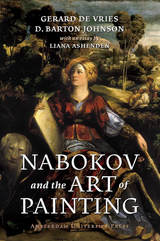 Nabokov and the Art of Painting
Gerard de Vries and D. Barton Johnson
Amsterdam University Press, 2006 “Sounds have colors and colors have smells.” This sentence in Adais only one of the many moments in Nabokov’s work where he sought to merge the visual into his rich and sensual writing. This lavishly illustrated study is the first to examine the role of the visual arts in Nabokov’s oeuvre and to explore how art deepens the potency of the prominent themes threaded throughout his work.
The authors trace the role of art in Nabokov’s life, from his alphabetic chromesthesia—a psychological condition in which letters evoke specific colors—to his training under Marc Chagall’s painting instructor to his deep admiration for Leonardo da Vinci and Hieronymus Bosch. They then examine over 150 references to specific works of art in such novels as Laughter in the Dark, The Real Life of Sebastian Knight, Pnin, Lolita, Ada, and Pale Fire and consider how such references reveal new emotional aspects of Nabokov’s fiction.
A fascinating and wholly original study, Nabokov and the Art of Painting will be invaluable reading for scholars and enthusiasts of Nabokov alike.
 Nabokov and the Novel
Ellen Pifer
Harvard University Press, 1980 Ellen Pifer challenges the widely held assumption that Nabokov is a writer more interested in literary games than in living human beings. She demonstrates how Nabokov arranges the details of his fiction to explore human psychology and moral truth, and she argues her case with style.
Focusing on the most highly wrought and aesthetically self-conscious of Nabokov’s novels, Pifer shows how he deploys artifice to bring into bold relief what is real. In her chapter on King, Queen, Knave she reveals Nabokov’s radical distinction between genuine and simulated human existence. She shows how, in Invitation to a Beheading and Bend Sinister, he contrasts “grotesque design” of collective existence with the individual’s radiant internal life. In Despair, Lolita, and Pale Fire, Nabokov’s parody of the double illuminates the unique source of human consciousness. In Ada, as in the earlier Laughter in the Dark, the inhuman nature of aesthetic bliss qualifies its delights. Making clear the moral perception of reality that lies behind Nabokov’s artistic strategies, Pifer offers a new assessment of Nabokov’s fiction and of his contribution to the tradition of the novel.
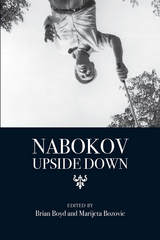 Nabokov Upside Down
Edited by Brian Boyd and Marijeta Bozovic
Northwestern University Press, 2017 Nabokov Upside Down brings together essays that explicitly diverge from conventional topics and points of reference when interpreting a writer whose influence on contemporary literature is unrivaled. Scholars from around the world here read Nabokov in terms of bodies rather than minds, belly-laughs rather than erudite wit, servants rather than master-artists, or Asian rather than Western perspectives. The first part of the volume is dedicated to surveys of Nabokov’s oeuvre that transform some long-held assumptions concerning the nature of and significance of his work.
Often thought of as among the most cerebral of artists, Nabokov comes across in these essays as profoundly aware of the physical world, as evidenced by his masterly representation of physical movement, his bawdy humor, and his attention to gustatory pleasure, among other aspects of his writing. The volume’s second half focuses on individual works or phases in Nabokov’s career, noting connections among them as well as to other fields of inquiry beyond literature. Engaged in conversation with each other and, in his editorial comments, with Brian Boyd, the essays in this volume show Nabokov scholarship continuing to renew itself.
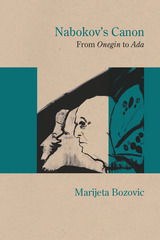 Nabokov's Canon: From "Onegin" to "Ada"
Marijeta Bozovic
Northwestern University Press, 2016 Nabokov's translation of Pushkin's Eugene Onegin (1964) and its accompanying Commentary, along with Ada, or Ardor (1969), his densely allusive late English language novel, have appeared nearly inscrutable to many interpreters of his work. If not outright failures, they are often considered relatively unsuccessful curiosities. In Bozovic's insightful study, these key texts reveal Nabokov's ambitions to reimagine a canon of nineteenth- and twentieth-century Western masterpieces with Russian literature as a central, rather than marginal, strain. Nabokov's scholarly work, translations, and lectures on literature bear resemblance to New Critical canon reformations; however, Nabokov's canon is pointedly translingual and transnational and serves to legitimize his own literary practice. The new angles and theoretical framework offered by Nabokov's Canon help us to understand why Nabokov's provocative monuments remain powerful source texts for several generations of diverse international writers, as well as richly productive material for visual, cinematic, musical, and other artistic adaptations.
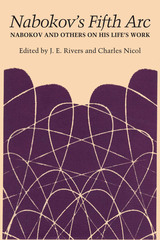 Nabokov's Fifth Arc: Nabokov and Others on His Life's Work
Edited by J. E. Rivers and Charles Nicol
University of Texas Press, 1982 In his autobiography Speak, Memory, Vladimir Nabokov compared his life to a spiral, in which “twirl follows twirl, and every synthesis is the thesis of the next series.” The first four arcs of the spiral of Nabokov’s life—his youth in Russia, voluntary exile in Europe, two decades spent in the United States, and the final years of his life in Switzerland—are now followed by a fifth arc, his continuing life in literary history, which this volume both explores and symbolizes. This is the first collection of essays to examine all five arcs of Nabokov’s creative life through close analyses of representative works. The essays cast new light on works both famous and neglected and place these works against the backgrounds of Nabokov’s career as a whole and modern literature in general. Nabokov analyzes his own artistry in his “Postscript to the Russian Edition of Lolita,” presented here in its first English translation, and in his little-known “Notes to Ada by Vivian Darkbloom,” published now for the first time in America and keyed to the standard U.S. editions of the novel. In addition to a defense of his father’s work by Dmitri Nabokov and a portrait-interview by Alfred Appel, Jr., the volume presents a vast spectrum of critical analyses covering all Nabokov’s major novels and several important short stories. The highly original structure of the book and the fresh and often startling revelations of the essays dramatize as never before the unity and richness of Nabokov’s unique literary achievement.
Nabokov's "Invitation to a Beheading": A Critical Companion
Julian Connolly
Northwestern University Press, 1997 Julian W. Connolly's companion to Vladimir Nabokov's Invitation to a Beheading includes a general introduction discussing the work in the context of Nabokov's oeuvre as well as its place within the Russian literary tradition. Also included are primary sources and other background materials, as well as discussions of the work by leading scholars and an annotated bibliography. Combining the highest order of scholarship with accessibility, this critical companion illuminates a great work of literature, and will enhance is appreciation by both teachers and students.
 Nabucodonosor: Dramma lirico in Four Parts by Temistocle Solera
Giuseppe Verdi
University of Chicago Press, 1988 Nabucodonosor, one of the early Verdi operas, is the third work to be published in The Works of Giuseppe Verdi. Following the strict requirements of the series, the edition is based on Verdi's autograph and other authentic sources, and has been reviewed by a distinguished editorial board—Philip Gossett, Julian Budden, Martin Chusid, Francesco Degrada, Ursula Günther, Giorgio Pestelli, and Pierluigi Petrobelli. Nabucodonosor is available as a two-volume set: a full orchestral score and a critical commentary. The score, which has been beautifully bound and autographed, is printed on high-grade paper in an oversized, 10-1/2 x 14-1/2-inch format. The introduction to the score discusses the work's genesis, sources, and performance history as well as performance practices, instrumentation, and problems of notation. The critical commentary, printed in a smaller format, discusses editorial decisions and identifies the sources of alternate readings of the music and libretto.
 Nachituti's Gift: Economy, Society, and Environment in Central Africa
David M. Gordon
University of Wisconsin Press, 2006 Nachituti’s Gift challenges conventional theories of economic development with a compelling comparative case study of inland fisheries in Zambia and Congo from pre- to postcolonial times. Neoclassical development models conjure a simple, abstract progression from wealth held in people to money or commodities; instead, Gordon argues, primary social networks and oral charters like “Nachituti’s Gift” remained decisive long after the rise of intensive trade and market activities. Interweaving oral traditions, songs, and interviews as well as extensive archival research, Gordon’s lively tale is at once a subtle analysis of economic and social transformations, an insightful exercise in environmental history, and a revealing study of comparative politics.
Honorable Mention, Melville J. Herskovits Award, African Studies Association
“A powerful portrayal of the complexity, fluidity, and subtlety of Lake Mweru fishers’ production strategies . . . . Natchituti’s Gift adds nuance and evidence to some of the most important and sophisticated conversations going on in African studies today.”—Kirk Arden Hoppe, International Journal of African Historical Studies
“A lively and intelligent book, which offers a solid contribution to ongoing debates about the interplay of the politics of environment, history and economy.”—Joost Fontein, Africa
“Well researched and referenced . . . . [Natchituti’s Gift] will be of interest to those in a wide variety of disciplines including anthropology, African Studies, history, geography, and environmental studies.”—Heidi G. Frontani, H-SAfrica
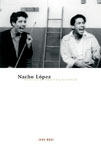 Nacho Lopez, Mexican Photographer
John Mraz
University of Minnesota Press, 2003 Reveals the career of an influential but under-appreciated photojournalist Photographer Nacho López was Mexico’s Eugene Smith, fusing social commitment with searing imagery to dramatize the plight of the helpless, the poor, and the marginalized in the pages of glossy illustrated magazines. Even today, López’s photographs forcefully belie the picturesque exoticism that is invariably presented as the essence of Mexico. In Nacho López, Mexican Photographer, John Mraz offers the first full-length study in English of this influential photojournalist and provides a close visual analysis of more than fifty of López’s most important photographs. Mraz first sets López’s work in the historical and cultural context of the authoritarian presidentialism that characterized Mexican politics in the 1950s, the cult of wealth and celebrity promoted by Mexico’s professional photographers, and the government’s attempts to modernize and industrialize Mexico at almost any cost. Mraz skillfully explores the implications of López's imagery in this setting: the extent to which his photographs might constitute further victimization of his downtrodden subjects, the relationship between them and the middle-class readers of the magazines for which López worked, and the success with which his photographs challenged Mexico's economic and political structures. Mraz contrasts the photos López took with those that were selected by his editors for publication. He also compares López’s images with his theories about documentary photography, and considers López’s photographs alongside the work of Robert Capa, Dorothea Lange, Henri Cartier-Bresson, and Sebastião Salgado. López’s imagery is further analyzed in relation to the Mexican Golden Age cinema inspired by Sergei Eisenstein, the pioneering digital imagery of Pedro Meyer, and the work of Manuel Álvarez Bravo, who Mraz provocatively argues was the first Mexican photographer to take an anti-picturesque stance. The definitive English-language assessment of Nacho López’s career, this volume also explores such broader topics as the nature of the photographic essay and the role of the media in effecting social change.
Nadia
Christine Evans
University of Iowa Press, 2023 Nadia moves between the competing perspectives of two survivors of the 1990s Balkan Wars who have escaped to London, only to discover that the war has followed them there. Nadia is a young refugee who just wants to forget the past—until Iggy starts temping at her London office. Afraid he may be a sniper from the war she fled, Nadia starts seeing threats everywhere, alongside unsettling visions of her lost girlfriend, Sanja. As her volatile connection with Iggy unravels, Nadia is forced to face the ethically shaky choices she made to escape the war, her survivor guilt, and her disavowed queer sexuality.
Christine Evans's novel takes us to the recent past of a war that broke apart a European country and that presciently foreshadowed the rise of ethno-nationalism in the West. Tense, suspenseful, and mordantly funny, Nadia tracks the complex ways in which a past marked by political violence can shadow and disrupt the present.
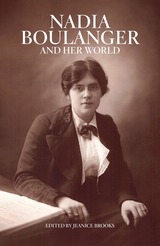 Nadia Boulanger and Her World
Edited by Jeanice Brooks
University of Chicago Press, 2020 Nadia Boulanger (1887–1979) was arguably one of the most iconic figures in twentieth-century music, and certainly among the most prominent musicians of her time. For many composers— especially Americans from Aaron Copland to Philip Glass—studying with Boulanger in Paris or Fontainebleau was a formative moment in a creative career.
Composer, performer, conductor, impresario, and charismatic and inspirational teacher, Boulanger engaged in a vast array of activities in a variety of media, from private composition lessons and lecture-recitals to radio broadcasts, recordings, and public performances. But how to define and account for Boulanger’s impact on the music world is still unclear. Nadia Boulanger and Her World takes us from a time in the late nineteenth century, when many careers in music were almost entirely closed to women, to the moment in the late twentieth century when those careers were becoming a reality. Contributors consider Boulanger’s work in the worlds of composition, musical analysis, and pedagogy and explore the geographies of transatlantic and international exchange and disruption within which her career unfolded. Ultimately, this volume takes its title as a topic for exploration—asking what worlds Boulanger belonged to, and in what sense we can consider any of them to be “hers.”
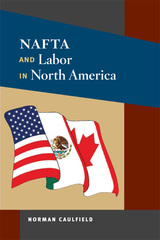 NAFTA and Labor in North America
Norman Caulfield
University of Illinois Press, 2010 As companies increasingly look to the global market for capital, cheaper commodities and labor, and lower production costs, the impact on Mexican and American workers and labor unions is significant. National boundaries and the laws of governments that regulate social relations between laborers and management are less relevant in the era of globalization, rendering ineffective the traditional union strategies of pressuring the state for reform. Focusing especially on the effects of the North American Free Trade Agreement and the North American Agreement on Labor Cooperation (the first international labor agreement linked to an international trade agreement), Norman Caulfield notes the waning political influence of trade unions and their disunity and divergence on crucial issues such as labor migration and workers' rights. Comparing the labor movement's fortunes in the 1970s with its current weakened condition, Caulfield notes the parallel decline in the United States' hegemonic influence in an increasingly globalized economy. As a result, organized labor has been transformed from organizations that once pressured management and the state for worker concessions to organizations that now request that workers concede wages, pensions, and health benefits to remain competitive in the global marketplace.
 Nahmanides in Medieval Catalonia: History, Community, and Messianism
Nina Caputo
University of Notre Dame Press, 2007
In this detailed study, Nina Caputo examines conceptions of history and messianic redemption in the writings of the Catalonian rabbi and brilliant Talmudic scholar Nahmanides (1195–1270). An early exponent of kabbalah, Nahmanides was also a shrewd intermediary between the Jewish communities and the royal administration of Aragon. Most intellectual histories focus on Nahmanides in the fairly insular context of Jewish community dynamics, but this volume explores the largely unexamined history of encounters between Jewish and Christian interpretations of history and redemption, as well as the significant role played by Jews in the expansion of the Crown of Aragon during the thirteenth century. Caputo explains Nahmanides' distinctive understanding of the shape and meaning of historical time and change and reveals how his discourse frequently confronted Christian views of history and scripture, sometimes embracing Christians forms, but at other times directly refuting them.
Nina Caputo's book is the first to situate Nahmanides in the full intellectual and religious context of thirteenth-century Catalonia. It makes an important contribution to the fields of Jewish studies as well as medieval and early modern history.
“Nahmanides in Medieval Catalonia is a compelling illustration of meticulous scholarly attention, of subtle historical consciousness, rigorous rhetorical and literary sensibility, and true, wide-ranging synthetic ability—it uniquely draws from the entire corpus of Nahmanides' work in order to reframe conflicts and disputes, once again, as fertile and positive exchanges.” —Gil Anidjar, Columbia University
“Caputo has written a brilliant monograph on one of the most fascinating minds of the High Middle Ages. By aligning the intellectual and communal activities of Nahmanides within the context of both Jewish and medieval Spanish vernacular texts she brings academic rigor and interdisciplinary scholarship to throw new light on both communities at a critical moment in their development. Each chapter reveals the subtle ways that Nahmanides constructed intellectual and social frameworks for Jews to preserve their unique identity while sharing cultural and aesthetic norms of the Christian society that surrounded them.” —Michael A. Signer, Abrams Professor of Jewish Thought and Culture, University of Notre Dame
“This book offers a meticulous and thoughtful reading of the themes of history, prophecy, and progress in Nahmanides' exegetical, theological, and polemical works. It joins a growing body of scholarship that emphasizes the extent to which even tense and hostile Jewish-Christian confrontations were predicated upon shared cultural and intellectual approaches. It is sure to interest and engage scholars in the fields of Judaic studies, Iberian history, and biblical studies.” —Sara Lipton, Stony Brook University
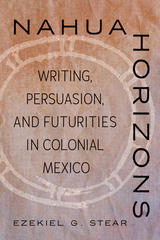 Nahua Horizons: Writing, Persuasion, and Futurities in Colonial Mexico
Ezekiel G. Stear
University of Arizona Press, 2025 Nahua Horizons: Writing, Persuasion, and Futurities in Colonial Mexico investigates how Nahuas conceptualized their futures in the early colonial period. Scholar Ezekiel G. Stear delves deeply into canonical texts such as the Florentine Codex and the Crónica mexicayotl as well as understudied texts such as the Lienzo de Quauhquechollan, the Tira de Tepechpan, and the Anales de Juan Bautista. The study does more than describe how Nahuas conceived of their own futures: it also shows their specific plans for moving into the coming years. The book examines how Nahua writers in Central Mexico and other Mesoamerican voices in colonial Spanish America played an active, decisive role in shaping culture, using writing to persuade their communities to mold their own destinies, even amid colonial upheaval. This work opens up new directions for research and teaching, shifting inquiry from how Nahuas preserved cultural continuity to how they envisioned their roles as pathfinders toward times to come. Nahua Horizons challenges the notion that the Spanish erased Nahua culture. The book emphasizes the ways people kept sovereignty over the futures they envisioned for themselves and their communities. Stear’s bold new approach follows the paths that Nahuas forged ahead into unknown times.
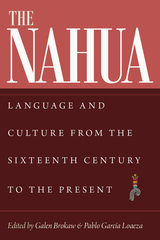 The Nahua: Language and Culture from the 16th Century to the Present
Galen Brokaw
University Press of Colorado, 2024 Revealing the resiliency of Nahua culture and language while highlighting the adaptations and changes they have undergone over the centuries, The Nahua demonstrates that Nahuatl remained a vibrant and central language well after European contact and into the twenty-first century, and its characteristic features can provide insight into nuanced aspects of Nahua culture and history.
During the colonial period, Nahuatl became a means of empowerment, oppression, and indoctrination. In modern times, Nahuatl continues to serve as an ideological lightning rod for both the Mexican government and Indigenous communities. Contributors to this volume focus on Nahua intellectual production from the sixteenth century to the present; contact and the negotiation of meaning; adaptations of Christian lore that show how representations of creation, hell, and the Passion of Christ reflected Nahua perceptions and understandings; Nahua cultural expressions, including poetry, healing rituals, and even running; language and geography; Nahuatl place-names; and the transformation of Nahuatl speakers from antiquity to the present.
Showcasing how Nahuatl’s cultural resilience permanently shaped the region’s social geography, The Nahua engages the field’s interest in the nonhomogenous character of the language, with regional and subregional dialects and pronunciations that reflect the history of pre-Columbian migrations and modern-era influences. Bridging the study of Nahuatl as a “historical” Indigenous language tradition with the study of modern-day speakers and their experiences, this work is of significance to students, scholars, and speakers of the languages as well as those studying colonial New Spain, Indigenous resilience, or Indigenous linguistics.
Nahuat Myth and Social Structure
By James M. Taggart
University of Texas Press, 1997 First published in 1983, Nahuat Myth and Social Structure brings together an important collection of modern-day Aztec Indian folktales and vividly demonstrates how these tales have been shaped by the social structure of the communities in which they are told.
 Nahum Goldman: His Missions to the Gentile
Raphael Patai
University of Alabama Press, 1980 The first exploration of Nahum Goldmann and his extraordinary life
Nahum Goldmann (1895-1982) was a major Zionist figure for the last half-century and the chief architect of the pact pledging West Germany to pay reparations to Israel and to individual Jews for acts committed during the Nazi regime. He was co-founder of the Eschkol Publishing House in Berlin and was co-publisher of the Encyclopedia Judaica, the only major Jewish encyclopedia published in Germany.
Patai’s study is the first to explore this brilliant, often irritating, and enormously successful Jewish politician and diplomat. Goldmann represented no government, yet he effected important international change. The book discusses Goldmann’s involvement with the partition controversy which led to the establishment of Israel, West German reparation payments amounting to over $36 billion, and a series of attempts to meet with Egyptian President Nasser in hopes of bringing peace to the Middle East.
Naija Marxisms: Revolutionary Thought in Nigeria
Adam Mayer
Pluto Press, 2016 Since the 1940s, Marxist thought has developed considerably in Nigeria. Long gone are the days when Marxism meant imported pamphlets and a rootless foreign ideology. The history of “Naija” or Nigerian Marxism is also that of the country’s labor movement, its feminist movement, its social thought, and its political economy. Drawn from three years of research in Nigeria and elsewhere, Naija Marxisms breaks new ground in tracing the historical trajectories of leftist movements since the 1940s. Adam Mayer explores the international context of Nigerian Marxism and provides core chapters on key thinkers including Mokwugo Okoye, Ikenna Nzimiro, and Eskor Toyo, among many others.
The Nail in the Tree: Essays on Art, Violence, and Childhood
Carol Ann Davis
Tupelo Press, 2020 The Nail in the Tree meditates on crucial subjects in devastating circumstances, exploring how childhood can be violent and generative, how trauma integrates in art and daily life, and what the artist’s role is. In this part memoir, part art-historical treatise, Carol Ann Davis narrates her experience of raising two sons in Sandy Hook, Connecticut, on the day of and during the aftermath of the shooting there. She describes revelations her children come to in the weeks that follow, quietly echoes the words of a principal on that day, and recounts painful series of texts and calls to further and further distant family members. She writes in beautiful, devastating, poetic language.
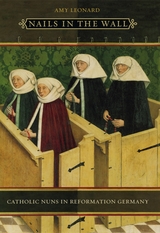 Nails in the Wall: Catholic Nuns in Reformation Germany
Amy Leonard
University of Chicago Press, 2005 During the Protestant Reformation, Martin Luther instituted new ideologies addressing gender, marriage, chastity, and religious life that threatened Catholic monasticism. Yet many living in cloistered religious communities, particularly women, refused to accept these new terms and were successful in their opposition to the new Protestant culture.
Focusing primarily on a group of Dominican nuns in Strasbourg, Germany, Amy Leonard's Nails in the Wall outlines the century-long battle between these nuns and the Protestant city council. With savvy strategies that employed charm, wealth, and political and social connections, the nuns were able to sustain their Catholic practices. Leonard's in-depth archival research uncovers letters about and records of the nuns' struggle to maintain their religious beliefs and way of life in the face of Protestant reforms. She tells the story of how they worked privately to keep Catholicism alive-continuing to pray in Latin, smuggling in priests to celebrate Mass, and secretly professing scores of novices to ensure the continued survival of their convents. This fascinating and heartening study shows that, far from passively allowing the Protestants to dismantle their belief system, the women of the Strasbourg convents were active participants in the battle over their vocation and independence.
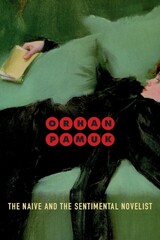 The Naive and the Sentimental Novelist
Orhan Pamuk
Harvard University Press, 2010 What happens within us when we read a novel? And how does a novel create its unique effects, so distinct from those of a painting, a film, or a poem? In this inspired, thoughtful, deeply personal book, Orhan Pamuk takes us into the worlds of the writer and the reader, revealing their intimate connections.
Pamuk draws on Friedrich Schiller’s famous distinction between “naive” poets—who write spontaneously, serenely, unselfconsciously—and “sentimental” poets: those who are reflective, emotional, questioning, and alive to the artifice of the written word. Harking back to the beloved novels of his youth and ranging through the work of such writers as Tolstoy, Dostoevsky, Stendhal, Flaubert, Proust, Mann, and Naipaul, he explores the oscillation between the naive and the reflective, and the search for an equilibrium, that lie at the center of the novelist’s craft. He ponders the novel’s visual and sensual power—its ability to conjure landscapes so vivid they can make the here-and-now fade away. In the course of this exploration, he considers the elements of character, plot, time, and setting that compose the “sweet illusion” of the fictional world.
Anyone who has known the pleasure of becoming immersed in a novel will enjoy, and learn from, this perceptive book by one of the modern masters of the art.
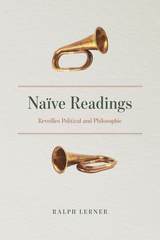 Naïve Readings: Reveilles Political and Philosophic
Ralph Lerner
University of Chicago Press, 2016 One sure fact of humanity is that we all cherish our opinions and will often strongly resist efforts by others to change them. Philosophers and politicians have long understood this, and whenever they have sought to get us to think differently they have often resorted to forms of camouflage that slip their unsettling thoughts into our psyche without raising alarm. In this fascinating examination of a range of writers and thinkers, Ralph Lerner offers a new method of reading that detects this camouflage and offers a way toward deeper understandings of some of history’s most important—and most concealed—messages.
Lerner analyzes an astonishing diversity of writers, including Francis Bacon, Benjamin Franklin, Edward Gibbon, Judah Halevi, Thomas Jefferson, Abraham Lincoln, Moses Maimonides, and Alexis de Tocqueville. He shows that by reading their words slowly and naïvely, with wide-open eyes and special attention for moments of writing that become self-conscious, impassioned, or idiosyncratic, we can begin to see a pattern that illuminates a thinker’s intent, new messages purposively executed through indirect means. Through these experimental readings, Lerner shows, we can see a deep commonality across writers from disparate times and situations, one that finds them artfully challenging others to reject passivity and fatalism and start thinking afresh.
 Nakae Ushikichi in China: The Mourning of Spirit
Joshua A. Fogel
Harvard University Press, 1989 In 1914, Nakeae Ushikichi (1889-1942), gifted son of the famous Nakae Chōmin (1847-1901) and graduate of Tokyo University's Faculty of Law, left behind the opportunities open to him in Japan and went to China. He worked briefly for the South Manchurian Railway and then in the Yüan Shih-k'ai government, but a personal crisis in 1919 turned him suddenly to a life of rigorous scholarship and social criticism. He spent most of his adult life in Peking, published little, deeply influenced a few key compatriots, and became a posthumous hero to a generation of postwar Japanese intellectuals.
In the first full-length study in English of the life and thought of Nakae Ushikichi, Joshua A. Fogel tells the strange story of this cocky, indolent carouser who became a disciplined scholar and passionate advocate of the worth of all humanity. Fogel examines Nakae's Sinological work in the context of his wide reading in German philosophy, Western historiography, and classical Chinese sources. He also translates Nakae's wartime diary.
 Nakagami, Japan: Buraku and the Writing of Ethnicity
Anne McKnight
University of Minnesota Press, 2010 How do you write yourself into a literature that doesn’t know you exist? This was the conundrum confronted by Nakagami Kenji (1946–1992), who counted himself among the buraku-min, Japan’s largest minority. His answer brought the histories and rhetorical traditions of buraku writing into the high culture of Japanese literature for the first time and helped establish him as the most canonical writer born in postwar Japan.
In Nakagami, Japan, Anne McKnight shows how the writer’s exploration of buraku led to a unique blend of fiction and ethnography—which amounted to nothing less than a reimagining of modern Japanese literature. McKnight develops a parallax view of Nakagami’s achievement, allowing us to see him much as he saw himself, as a writer whose accomplishments traversed both buraku literary arts and high literary culture in Japan.
As she considers the ways in which Nakagami and other twentieth-century writers used ethnography to shape Japanese literature, McKnight reveals how ideas about language also imagined a transfigured relation to mainstream culture and politics. Her analysis of the resulting “rhetorical activism” lays bare Nakagami’s unique blending of literature and ethnography within the context of twentieth-century ideas about race, ethnicity, and citizenship—in Japan, but also on an international scale.
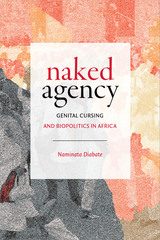 Naked Agency: Genital Cursing and Biopolitics in Africa
Naminata Diabate
Duke University Press, 2020 Across Africa, mature women have for decades mobilized the power of their nakedness in political protest to shame and punish male adversaries. This insurrectionary nakedness, often called genital cursing, owes its cultural potency to the religious belief that spirits residing in women's bodies can be unleashed to cause misfortune in their targets, including impotence, disease, and death. In Naked Agency, Naminata Diabate analyzes these collective female naked protests in Africa and beyond to broaden understandings of agency and vulnerability. Drawing on myriad cultural texts from social media and film to journalism and fiction, Diabate uncovers how women create spaces of resistance during socio-political duress, including such events as the 2011 protests by Ivoirian women in Côte d’Ivoire and Paris as well as women's disrobing in Soweto to prevent the destruction of their homes. Through the concept of naked agency, Diabate explores fluctuating narratives of power and victimhood to challenge simplistic accounts of African women's helplessness and to show how they exercise political power in the biopolitical era.
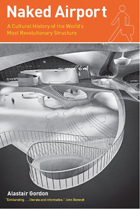 Naked Airport: A Cultural History of the World's Most Revolutionary Structure
Alastair Gordon
University of Chicago Press, 2008 Although airports are now best known for interminable waits at check-in counters, liquid restrictions for carry-on luggage, and humiliating shoe-removal rituals at security, they were once the backdrops for jet-setters who strutted, martinis in hand, through curvilinear terminals designed by Eero Saarinen. In the critically acclaimed Naked Airport, Alastair Gordon traces the cultural history of this defining institution from its origins in the muddy fields of flying machines to its frontline position in the struggle against international terrorism.
From global politics to action movies to the daily commute, Gordon shows how the airport has changed our sense of time, distance, and style, and ultimately the way cities are built and business is done. He introduces the people who shaped and were shaped by this place of sudden transition: pilots like Charles Lindbergh, architects like Le Corbusier, and political figures like Fiorello LaGuardia and Adolf Hitler. Naked Airport is a profoundly original history of a long-neglected yet central component of modern life.
“This charming history documents why airports have always been such intriguing places. Gordon wittily deconstructs air terminal architecture. . . . Here is a book with more than enough quirky details to last a long layover.”—People
“[A] splendid cultural history.”—Atlantic Monthly
“Gordon, an architecture and design critic, tells his story well, bringing to life some of the main characters and highlighting some of the important issues concerning urbanism and airports.”—Michael Roth, San Francisco Chronicle
“Gordon provides a truly compelling account of how airports had over the course of three-quarters of a century become the locus of not only modern dreams but postmodern nightmares as well. Don’t leave home without it.”—Terence Riley, director of the Miami Art Museum
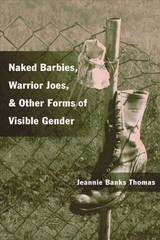 Naked Barbies, Warrior Joes, and Other Forms of Visible Gender
Jeannie Banks Thomas
University of Illinois Press, 2003 In this folkloric examination of mass-produced material culture in the United States, Jeannie Banks Thomas examines the gendered sculptural forms that are among the most visible, including Barbie, Ken, and G.I. Joe dolls; yard figures (gnomes, geese, and flamingos); and cemetery statuary (angels, sports-related images, figures of the Virgin Mary, soldiers, and politicians).
Images of females are often emphasized or sexualized, frequently through nudity or partial nudity, whereas those of the male body are not only clothed but also armored in the trappings of action and aggression. Thomas locates these various objects of folk art within a discussion of the post–women's movement discourse on gender.
In addition to the items themselves, Thomas explores the stories and behaviors they generate, including legends of the supernatural about cemetery statues, oral narratives of yard artists and accounts of pranks involving yard art, narratives about children's play with Barbie, Ken, and G.I. Joe, and the electronic folklore (or "e-lore") about Barbie that circulates on the Internet.
NAKED BEFORE GOD: UNCOVERING THE BODY IN ANGLO-SAXON ENGLAND
BENJAMIN C. WITHERS
West Virginia University Press, 2003 At different times and in different places, the human form has been regarded in different ways. The Ancient Greeks thought it was the most admirable subject for art, whereas early Christians often viewed it as lascivious in our post-lapsarian state. With illustrations taken from manuscripts, statuary and literary, this is a fascinating collection of essays with much that will be new to scholars and general readers alike.
 The Naked Blogger of Cairo: Creative Insurgency in the Arab World
Marwan M. Kraidy
Harvard University Press, 2016 A Times Higher Education Book of the Year
Uprisings spread like wildfire across the Arab world from 2010 to 2012, fueled by a desire for popular sovereignty. In Tunisia, Egypt, Syria, and elsewhere, protesters flooded the streets and the media, voicing dissent through slogans, graffiti, puppetry, videos, and satire that called for the overthrow of dictators and the regimes that sustained them. Investigating what drives people to risk everything to express themselves in rebellious art, The Naked Blogger of Cairo uncovers the creative insurgency at the heart of the Arab uprisings.
“A deep dive into the cultural politics of the Arab uprisings…Kraidy’s sharp insights and rich descriptions of a new Arab generation’s irrepressible creative urges will amply reward the effort. Reading Kraidy’s accounts of the politically charted cultural gambits of wired Arab youth rekindles some of the seemingly lost spirit of the early days of the Arab uprisings and offers hope for the future.”
—Marc Lynch, Washington Post
“The Naked Blogger of Cairo is a superb and important work not just for scholars but for anyone who cares about the relationships between art, the body, and revolution.”
—Hans Rollman, PopMatters
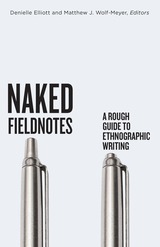 Naked Fieldnotes: A Rough Guide to Ethnographic Writing
Denielle Elliott
University of Minnesota Press, 2024 Creative and diverse approaches to ethnographic knowledge production and writing
Ethnographic research has long been cloaked in mystery around what fieldwork is really like for researchers, how they collect data, and how it is analyzed within the social sciences. Naked Fieldnotes, a unique compendium of actual fieldnotes from contemporary ethnographic researchers from various modalities and research traditions, unpacks how this research works, its challenges and its possibilities. The volume pairs fieldnotes based on observations, interviews, drawings, photographs, soundscapes, and other contemporary modes of recording research encounters with short, reflective essays, offering rich examples of how fieldnotes are composed and shaped by research experiences. These essays unlock the experience of conducting qualitative research in the social sciences, providing clear examples of the benefits and difficulties of ethnographic research and how it differs from other forms of writing such as reporting and travelogue. By granting access to these personal archives, Naked Fieldnotes unsettles taboos about the privacy of ethnographic writing and gives scholars a diverse, multimodal approach to conceptualizing and doing ethnographic fieldwork. Contributors: Courtney Addison, Te Herenga Waka—Victoria U of Wellington; Patricia Alvarez Astacio, Brandeis U; Sareeta Amrute, The New School; Barbara Andersen, Massey U Auckland, New Zealand; Adia Benton, Northwestern U; Letizia Bonanno, U of Kent; Alexandrine Boudreault-Fournier, U of Victoria; Michael Cepek, U of Texas at San Antonio; Michelle Charette, York U; Tomás Criado, Humboldt-U of Berlin; John Dale, George Mason U; Elsa Fan, Webster U; Kelly Fayard, U of Denver; Michele Friedner, U of Chicago; Susan Frohlick, U of British Columbia, Okanagan, Syilx Territory; Angela Garcia, Stanford U; Danielle Gendron, U of British Columbia; Mascha Gugganig, Technical U Munich; Natalia Gutkowski, Hebrew U of Jerusalem; T. S. Harvey, Vanderbilt U; Saida Hodžić, Cornell U; K. G. Hutchins, Oberlin College; Basit Kareem Iqbal, McMaster U; Emma Kowal, Deakin U in Melbourne; Mathangi Krishnamurthy, IIT Madras; Shyam Kunwar; Margaret MacDonald, York U in Toronto; Stephanie McCallum, U Nacional de San Martín and U de San Andrés, Argentina; Diana Ojeda, Cider, U de los Andes in Bogotá, Colombia; Valerie Olson, U of California, Irvine; Patrick Mbullo Owuor, Northwestern U; Stacy Leigh Pigg, Fraser U; Jason Pine, Purchase College, State U of New York; Chiara Pussetti, U of Lisbon; Tom Rice, U of Exeter; Leslie A. Robertson, U of British Columbia, Vancouver; Yana Stainova, McMaster U; Richard Vokes, U of Western Australia; Russell Westhaver, Saint Mary’s U in Nova Scotia; Paul White, U of Nevada, Reno.
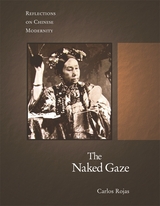 The Naked Gaze: Reflections on Chinese Modernity
Carlos Rojas
Harvard University Press, 2008 This is a study of visuality in early modern and modern China. Its focus, however, is not so much on imagery per se but rather on how vision itself has been conceived, imagined, and deployed in a variety of discursive contexts. Of particular interest is how these discourses of vision have been used to articulate issues of gender and desire, and specifically processes of gendered subject formation. Through detailed readings of narrative works by eight authors of the nineteenth and twentieth centuries—ranging from the canonical to the popular to the esoteric—the study identifies three distinct constellations of visual concerns corresponding to the late imperial, mid-twentieth century, and contemporary periods, respectively. At the same time, however, it argues that those historical periodizations themselves do not reflect a smooth, unidirectional temporal movement; rather, they are the result of a complex process of retrospection and anticipatory projection. The goal of this volume is to use a focus on tropes of visuality and gender to reflect on shifting understandings of the significance of Chineseness, modernity, and Chinese modernity.
 Naked in the Woods: My Unexpected Years in a Hippie Commune
Margaret Grundstein
Oregon State University Press, 2015 In 1970, Margaret Grundstein abandoned her graduate degree at Yale and followed her husband, an Indonesian prince and community activist, to a commune in the backwoods of Oregon. Together with ten friends and an ever-changing mix of strangers, they began to build their vision of utopia.
Naked in the Woods chronicles Grundstein’s shift from reluctant hippie to committed utopian—sacrificing phones, electricity, and running water to live on 160 acres of remote forest with nothing but a drafty cabin and each other. Grundstein, (whose husband left, seduced by “freer love”) faced tough choices. Could she make it as a single woman in man’s country? Did she still want to? How committed was she to her new life? Although she reveled in the shared transcendence of communal life deep in the natural world, disillusionment slowly eroded the dream. Brotherhood frayed when food became scarce. Rifts formed over land ownership. Dogma and reality clashed.
Many people, baby boomers and millennials alike, have romantic notions about the 1960s and 70s. Grundstein’s vivid account offers an unflinching, authentic portrait of this iconic and often misreported time in American history. Accompanied by a collection of distinctive photographs she took at the time, Naked in the Woods draws readers into a period of convulsive social change and raises timeless questions: how far must we venture to find the meaning we seek, and is it ever far out enough to escape our ingrained human nature?
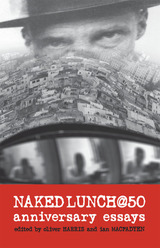 Naked Lunch @ 50: Anniversary Essays
Edited by Oliver Harris and Ian MacFadyen
Southern Illinois University Press, 2009 Naked Lunch was banned, castigated, and recognized as a work of genius on its first publication in 1959, and fifty years later it has lost nothing of its power to astonish, shock, and inspire. A lacerating satire, an exorcism of demons, a grotesque cabinet of horrors, it is the Black Book of the Beat Generation, the forerunner of the psychedelic counterculture, and a progenitor of postmodernism and the digital age. A work of excoriating laughter, linguistic derangement, and transcendent beauty, it remains both influential and inimitable.
This is the first book devoted in its entirety to William Burroughs’ masterpiece, bringing together an international array of scholars, artists, musicians, and academics from many fields to explore the origins, writing, reception, and complex meanings of Naked Lunch. Tracking the legendary book from Texas and Mexico to New York, Tangier, and Paris, Naked Lunch@50 significantly advances our understanding and appreciation of this most elusive and uncanny of texts. Contributors: Contributors: Keith Albarn Eric Andersen Gail-Nina Anderson Théophile Aries Jed Birmingham Shaun de Waal Richard Doyle Loren Glass Oliver Harris Kurt Hemmer Allen Hibbard Rob Holton Andrew Hussey Rob Johnson Jean-Jacques Lebel Ian MacFadyen Polina Mackay Jonas Mekas Barry Miles R. B. Morris Timothy S. Murphy Jurgen Ploog Davis Schneiderman Jennie Skerl DJ Spooky Philip Taaffe
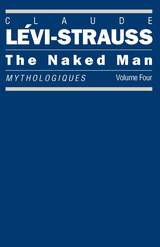 The Naked Man: Mythologiques, Volume 4
Claude Lévi-Strauss
University of Chicago Press, 1990 "The Naked Man is the fourth and final volume [of Mythologiques], written by the most influential and probably the most controversial anthropologist of our time. . . . Myths from North and South America are set side by side to show their transformations: in passing from person to person and place to place, a myth can change its content and yet retain its structural principles. . . . Apart from the complicated transformations discovered and the fascinating constructions placed on these, the stories themselves provide a feast."—Betty Abel, Contemporary Review
"Lévi-Strauss uses the structural method he developed to analyze and 'decode' the mythology of native North Americans, focusing on the area west of the Rockies. . . . [The author] takes the opportunity to refute arguments against his method; his chapter 'Finale' is a defense of structural analysis as well as the closing statement of this four-volume opus which started with an 'Ouverture' in The Raw and the Cooked."—Library Journal
"The culmination of one of the major intellectual feats of our time."—Paul Stuewe, Quill and Quire
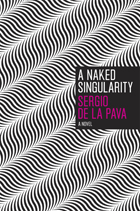 A Naked Singularity: A Novel
Sergio De La Pava
University of Chicago Press, 2012 *ONE OF THE WALL STREET JOURNAL'S TEN BEST BOOKS OF THE YEAR*
The mind-bending, brilliant, often hilarious PEN Award-winning classic novel of justice, the law, and the brutal gap between the two.
A Naked Singularity tells the story of Casi, a child of Colombian immigrants who lives in Brooklyn and works in Manhattan as a public defender--one who, tellingly has never lost a trial. Never. In the book, we watch what happens when his sense of justice and even his sense of self begin to crack--and how his world then slowly devolves. It’s a huge, ambitious novel clearly in the vein of DeLillo, Foster Wallace, Pynchon, and even Melville, and it's told in a distinct, frequently hilarious voice, with a striking human empathy at its center. Its panoramic reach takes readers through crime and courts, immigrant families and urban blight, media savagery and media satire, scatology and boxing, and even a breathless heist worthy of any crime novel. If InfiniteJest stuck a pin in the map of mid-90s culture and drew our trajectory from there, A Naked Singularity does the same for the feeling of surfeit, brokenness, and exhaustion that permeates our civic and cultural life today. In the opening sentence of William Gaddis’s A Frolic of His Own, a character sneers, "Justice? You get justice in the next world. In this world, you get the law." A Naked Singularity reveals the extent of that gap, and lands firmly on the side of those who are forever getting the law.
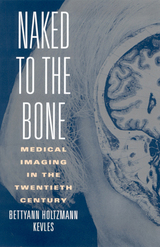 Naked to the Bone: Medical Imaging in the Twentieth Century
Kevles, Bettyann Holtzman
Rutgers University Press, 1996 X-rays, fluoroscopy, ultrasound, CT, MRI, and PET scans--medical imaging has become a familiar part of modern health care today. A century ago, however, the idea of looking inside the living body seemed absurd. Wilhelm Roentgen's X-ray image of his wife's shadowy hand--with her wedding band "floating" around a white bone--convinced doctors to rush the new tool into use for diagnosis and treatment. By the 1920s, the technology was a commonplace wonder: army recruits had routinely lined up for chest X-rays during World War I, and children delighted in seeing the bones of their feet in the green glow of shoestore fluoroscopes. By the late 1960s, the computer and television were linked to produce medical images that were as startling as Roentgen's original X-rays. Computerized tomography (CT) and magnetic resonance imaging (MR) made it possible to picture soft tissues invisible to ordinary X-rays. Ultrasound allowed expectant parents to see their unborn children. Positron emission tomography (PET) enabled neuroscientists to map the brain. In this lively history of medical imaging, the first to cover the full scope of the field from X-rays to MR-assistant surgery, Bettyann Kevles explores the consequences of these developments for medicine and society. Through lucid prose, vivid anecdotes, and more than seventy striking illustrations, she shows how medical imaging has transformed the practice of medicine--from pediatrics to dentistry, neurosurgery to geriatrics, gynecology to oncology. Despite their formidable power to reveal the inner secrets of the body, no form of medical imaging can claim to be the product of a technological imperative. As Kevles points out, few of these costly inventions made it easily to the marketplace, and all are vulnerable to the changing economics of the health-care system. In the early years of X-rays, many doctors, technicians, and patients died from overexposure to the invisible radiation. Although we may still find delayed repercussions from these newer technologies, a different kind of danger may lie in our conviction that an early diagnosis is equivalent to a cure. Beyond medicine, Kevles describes how X-rays and the newer technologies have become part of the texture of modern life and culture. They helped undermine Victorian sexual sensibilities, gave courts new forensic tools, provided plots for novels and movies, and offered artists from Picasso to Warhol new ways to depict the human form. Naked to the Bone offers readers an unparalled picture of a key technology of the twentieth century.
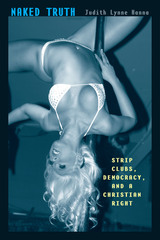 Naked Truth: Strip Clubs, Democracy, and a Christian Right
By Judith Lynne Hanna
University of Texas Press, 2012 Across America, strip clubs have come under attack by a politically aggressive segment of the Christian Right. Using plausible-sounding but factually untrue arguments about the harmful effects of strip clubs on their communities, the Christian Right has stoked public outrage and incited local and state governments to impose onerous restrictions on the clubs with the intent of dismantling the exotic dance industry. But an even larger agenda is at work, according to Judith Lynne Hanna. In Naked Truth, she builds a convincing case that the attack on exotic dance is part of the activist Christian Right’s “grand design” to supplant constitutional democracy in America with a Bible-based theocracy. Hanna takes readers onstage, backstage, and into the community and courts to reveal the conflicts, charges, and realities that are playing out at the intersection of erotic fantasy, religion, politics, and law. She explains why exotic dance is a legitimate form of artistic communication and debunks the many myths and untruths that the Christian Right uses to fight strip clubs. Hanna also demonstrates that while the fight happens at the local level, it is part of a national campaign to regulate sexuality and punish those who do not adhere to Scripture-based moral values. Ultimately, she argues, the naked truth is that the separation of church and state is under siege and our civil liberties—free speech, women’s rights, and free enterprise—are at stake.
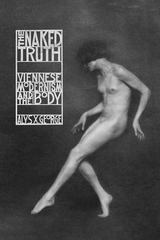 The Naked Truth: Viennese Modernism and the Body
Alys X. George
University of Chicago Press, 2020 Uncovers the interplay of the physical and the aesthetic that shaped Viennese modernism and offers a new interpretation of this moment in the history of the West.
Viennese modernism is often described in terms of a fin-de-siècle fascination with the psyche. But this stereotype of the movement as essentially cerebral overlooks a rich cultural history of the body. The Naked Truth, an interdisciplinary tour de force, addresses this lacuna, fundamentally recasting the visual, literary, and performative cultures of Viennese modernism through an innovative focus on the corporeal.
Alys X. George explores the modernist focus on the flesh by turning our attention to the second Vienna medical school, which revolutionized the field of anatomy in the 1800s. As she traces the results of this materialist influence across a broad range of cultural forms—exhibitions, literature, portraiture, dance, film, and more—George brings into dialogue a diverse group of historical protagonists, from canonical figures such as Egon Schiele, Arthur Schnitzler, Joseph Roth, and Hugo von Hofmannsthal to long-overlooked ones, including author and doctor Marie Pappenheim, journalist Else Feldmann, and dancers Grete Wiesenthal, Gertrud Bodenwieser, and Hilde Holger. She deftly blends analyses of popular and “high” culture, laying to rest the notion that Viennese modernism was an exclusively male movement. The Naked Truth uncovers the complex interplay of the physical and the aesthetic that shaped modernism and offers a striking new interpretation of this fascinating moment in the history of the West.
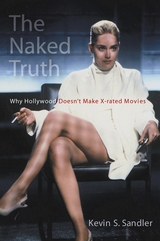 The Naked Truth: Why Hollywood Doesn't Make X-rated Movies
Sandler, Kevin S
Rutgers University Press, 2007 From parents and teachers to politicians and policymakers, there is a din of voices participating in the debate over how young people are affected by violence, strong language, and explicit sexual activity in films. The Motion Picture Association of America (MPAA) responded to this concern in 1968 when it introduced a classification and rating system based on the now well-known labels: "G," "PG," PG-13," "R," and "X." For some, these simple tags are an efficient way to protect children from viewing undesirable content. But do the MPAA ratings only protect children? In The Naked Truth, Kevin S. Sandler argues that perhaps even more than viewers, ratings protect the Hollywood film industry. One prime indicator of this is the collective abandonment of the NC-17 rating in 1990 by the major distributors of the MPAA and the main exhibitors of the National Association of Theatre Owners. By categorizing all films released by Hollywood and destined for mainstream theaters into R ratings (or lower), the industry ensures that its products are perceived as "responsible entertainment"—films accessible by all audiences and acceptable to Hollywood's various critics and detractors.
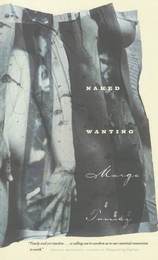 Naked Wanting
Margo Tamez
University of Arizona Press, 2003 Come, step outside your human skin for just a little while.
Margo Tamez’s voice is that of the cicada and the cricket, the raven and the crane. In this volume of poetry, she shows us that the earth is an erotic current linking all beings, a vibrant network of birth, death, and rebirth. A sacred intertwining from which we as humans have become disconnected. Tamez shares the perspective of other creatures in images that remind us of Nature's beauty and fragility. An invocation of birds: “Sudden hum / wings touching / wings in swift turn / hush / a fast red out of the flux.” An appreciation for the delicacy of insects, for spiderwebs “like a hundred needle-thin tubes of blown glass.”
Here too are reflections on childbirth and children—and on miscarriage, when damage inflicted on the environment by herbicides comes back to haunt all of us in our skin and bones, our very wombs. Warning of “the chemical cocktail seeping into the air ducts,” she brings the voice of someone who has experienced firsthand what happens when our land and water are compromised. For Tamez, earth, food, and family are the essentials of life, and we ignore them at our own peril. “If a person / does not admit the peril . . . that becomes a dangerous / form of existence.”
Written with the wisdom of one who knows and loves the land, her lyrical meditations speak to the naked wanting in us all.
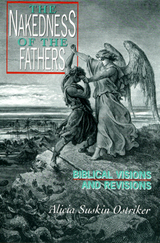 The Nakedness of the Fathers: Biblical Visions and Revisions
Ostriker, Alicia Suskin
Rutgers University Press, 1997 Like much twentieth-century feminist writing today, this book crosses the boundaries of genre. Biblical interpretation combines with fantasy, autobiography, and poetry. Politics joins with eroticism. Irreverence coexists with a yearning for the sacred. Scholarship contends with heresy. Most excitingly, the author continues and extends the tradition of arguing with God that commences in the Bible itself and continues now, as it has for centuries, to animate Jewish writing. The difference here is that the voice that debates with God is a woman's.
In her introduction, "Entering the Tents, " Ostriker defines the need to struggle against a tradition in which women have been silenced and disempowered - and to recover the female power buried beneath the surface of the biblical texts. In "The Garden, " she reinterprets the mythically complex stories of Creation. Then she considers the stories of "The Fathers, " from Abraham and Isaac to Moses, David, and Solomon - and their wives, mothers, and sisters. In "The Return of the Mothers, " she begins with a radical new interpretation of the book of Esther, includes a meditation on the silenced wife of Job and the idea of justice, and concludes with a fable on the death of God and a prayer to the Shekhinah, the feminine aspect of God. Ostriker refuses to dismiss the Bible as meaningless to women. Instead, in this angry, eloquent, visionary book, she attempts to recover what is genuinely sacred in these sacred texts.
 Name and Image: An Essay on Walter Benjamin
Gianni Carchia
Seagull Books, 2024 An insightful study of Walter Benjamin, one of the most important philosophers of the twentieth century, by the Italian philosopher Gianni Carchia.
Name and Image crystalizes Gianni Carchia’s lifelong pursuit of the infinite philosophical object in the method and thought of one of the most important philosophers of the twentieth century: Walter Benjamin. This intellectual biography touches upon the philosophy of language, historiography, aesthetics, temporality, and transcendental philosophy.
The book has the singular distinction of being both Gianni Carchia’s first and last work. In the spring of 1999, shortly before the resurgence of the disease that would lead to his death, Carchia began revising the graduate thesis he had defended at the University of Turin in 1971 with the title Truth and Language in the Young Walter Benjamin. At age twenty-four, the young scholar already demonstrated the incisive, axiomatic style of a master. The final version, retitled Name and Image, would become his testament. With a remarkable inversion, beginning and end seem to conjoin here in an authentically philosophical act, as though all the motifs of Carchia’s late thought—the conception of philosophy as event and witness, critique of method, and messianic finality—resonated together for the first time in this youthful text. The physiognomy of Benjamin that opens the work is the self-portrait of a figure who stands out ever more as one of the most just voices in twentieth-century Italian philosophy.
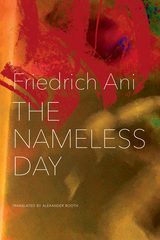 The Nameless Day
Friedrich Ani
Seagull Books, 2018 Now in paperback, the thrilling, psychological tale of a twenty-year-old cold case and the detective committed to solving it.
After years on the job, police detective Jakob Franck has retired. Finally, the dead—with all their mysteries—will no longer have any claim on him.
Or so he thinks. On a cold autumn afternoon, a case he thought he’d long put behind him returns to his life—and turns it upside down. The Nameless Day tells the story of that twenty-year-old case, which began with Franck carrying the news of the suicide of a seventeen-year-old girl to her mother, and holding her for seven hours as, in her grief, she said not a single word. Now her father has appeared, swearing to Franck that his daughter was murdered. Can Franck follow the cold trail of evidence two decades later to see whether he’s telling the truth? Could he live with himself if he didn’t?
A psychological crime novel certain to thrill fans of Henning Mankell and Jo Nesbo, The Nameless Day is a masterpiece, a tightly plotted story of contemporary alienation, loss, and violence.
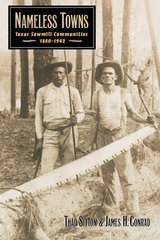 Nameless Towns: Texas Sawmill Communities, 1880-1942
By Thad Sitton and James H. Conrad
University of Texas Press, 1998 Winner, T. H. Fehrenbach Award, Texas Historical Commission Sawmill communities were once the thriving centers of East Texas life. Many sprang up almost overnight in a pine forest clearing, and many disappeared just as quickly after the company "cut out" its last trees. But during their heyday, these company towns made Texas the nation's third-largest lumber producer and created a colorful way of life that lingers in the memories of the remaining former residents and their children and grandchildren. Drawing on oral history, company records, and other archival sources, Sitton and Conrad recreate the lifeways of the sawmill communities. They describe the companies that ran the mills and the different kinds of jobs involved in logging and milling. They depict the usually rough-hewn towns, with their central mill, unpainted houses, company store, and schools, churches, and community centers. And they characterize the lives of the people, from the hard, awesomely dangerous mill work to the dances, picnics, and other recreations that offered welcome diversions.
The Names
N. Scott Momaday
University of Arizona Press, 1996 Of all of the works of N. Scott Momaday,The Names may be the most personal. A memoir of his boyhood in Oklahoma and the Southwest, it is also described by Momaday as "an act of the imagination. When I turn my mind to my early life, it is the imaginative part of it that comes first and irresistibly into reach, and of that part I take hold." Complete with family photos, The Names is a book that will captivate readers who wish to experience the Native American way of life.
Names Above Houses
Oliver de la Paz
Southern Illinois University Press, 2001 In Names above Houses, Oliver de la Pazuses both prose and verse poems to create the magical realm of Fidelito Recto—a boy who wants to fly—and his family of Filipino immigrants. Fidelito’s mother, Maria Elena, tries to keep her son grounded while struggling with her own moorings. Meanwhile, Domingo, Fidelito's fisherman father, is always at sea, even when among them. From the archipelago of the Philippines to San Francisco, horizontal and vertical movements shape moments of displacement and belonging for this marginalized family. Fidelito approaches life with a sense of wonder, finding magic in the mundane and becoming increasingly uncertain whether he is in the sky or whether his feet are planted firmly on the ground.
Names and Substance in the Australian Subsection System
C. G. von Brandenstein
University of Chicago Press, 1982 In this volume, which has been hailed as a major breakthrough in understanding the meaning of the elaborate kinship systems currently existing in Australian Aboriginal societies, C. G. von Brandenstein argues that such systems refer to an archaic theory of "world order" common to all these societies. This controversial conclusion is based on native testimony and on a sophisticated linguistic analysis of a vast quantity of data collected by the author and others.
Though the author has restricted the results of his research to Aboriginal Australia, his methodological approach is generalizable. Hence this work will be of importance to specialists in many areas.
The Names of Birds
Daniel Wolff
Four Way Books, 2015 A field guide to perception, The Name of Birds is about how we see the “natural world.” That is, how we approach what isn’t us and name what we see. It also offers detailed observations of common North American birds.
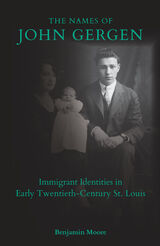 The Names of John Gergen: Immigrant Identities in Early Twentieth-Century St. Louis
Benjamin Moore
University of Missouri Press, 2020 Rescued from the dumpster of a boarded-up house, the yellowing scraps of a young migrant’s schoolwork provided Benjamin Moore with the jumping-off point for this study of migration, memory, and identity. Centering on the compelling story of its eponymous subject, The Names of John Gergen examines the converging governmental and institutional forces that affected the lives of migrants in the industrial neighborhoods of South St. Louis in the early twentieth century. These migrants were Banat Swabians from Torontál County in southern Hungary—they were Catholic, agrarian, and ethnically German.
Between 1900 and 1920, the St. Louis neighborhoods occupied by migrants were sites of efforts by civic authorities and social reformers to counter the perceived threat of foreignness by attempting to Americanize foreign-born residents. At the same time, these neighborhoods saw the strengthening of Banat Swabians’ ethnic identities. Historically, scholars and laypeople have understood migrants in terms of their aspirations and transformations, especially their transformations into Americans. The experiences of John Gergen and his kin, however, suggest that identity at the level of the individual was both more fragmented and more fluid than twentieth-century historians have recognized, subject to a variety of forces that often pulled migrants in multiple directions.
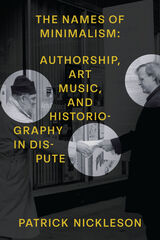 The Names of Minimalism: Authorship, Art Music, and Historiography in Dispute
Patrick Nickleson
University of Michigan Press, 2023 Minimalism stands as the key representative of 1960s radicalism in art music histories—but always as a failed project. In The Names of Minimalism, Patrick Nickleson holds in tension collaborative composers in the period of their collaboration, as well as the musicological policing of authorship in the wake of their eventual disputes. Through examinations of the droning of the Theatre of Eternal Music, Reich’s Pendulum Music, Glass’s work for multiple organs, the austere performances of punk and no wave bands, and Rhys Chatham and Glenn Branca’s works for massed electric guitars, Nickleson argues for authorship as always impure, buzzing, and indistinct.
Expanding the place of Jacques Rancière’s philosophy within musicology, Nickleson draws attention to disciplinary practices of guarding compositional authority against artists who set out to undermine it. The book reimagines the canonic artists and works of minimalism as “(early) minimalism,” to show that art music histories refuse to take seriously challenges to conventional authorship as a means of defending the very category “art music.” Ultimately, Nickleson asks where we end up if we imagine the early minimalist project—artists forming bands to perform their own music, rejecting the score in favor of recording, making extensive use of magnetic type as compositional and archival medium, hosting performances in lofts and art galleries rather than concert halls—not as a utopian moment within a 1960s counterculture doomed to fail, but as the beginning of a process with a long and influential afterlife.
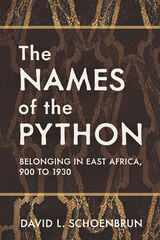 The Names of the Python: Belonging in East Africa, 900 to 1930
David L. Schoenbrun
University of Wisconsin Press, 2023 Systems of belonging, including ethnicity, are not static, automatic, or free of contest. Historical contexts shape the ways which we are included in or excluded from specific classifications. Building on an amazing array of sources, David L. Schoenbrun examines groupwork—the imaginative labor that people do to constitute themselves as communities—in an iconic and influential region in East Africa. His study traces the roots of nationhood in the Ganda state over the course of a millennia, demonstrating that the earliest clans were based not on political identity or language but on shared investments, knowledges, and practices.
Grounded in Schoenbrun’s skillful mastery of historical linguistics and vernacular texts, The Names of the Python supplements and redirects current debates about ethnicity in ex-colonial Africa and beyond. This timely volume carefully distinguishes past from present and shows the many possibilities that still exist for the creative cultural imagination.
Namibia Under South African Rule: Mobility and Containment, 1915–46
Patricia Hayes
Ohio University Press, 1998 The peoples of Namibia have been on the move throughout history. The South Africans in 1915 took over from the Germans in trying to fit Namibia into a colonial landscape. This book is about the clashes and stresses which resulted from the first three decades of South African colonial rule. Namibia under South African Rule is a major contribution to Namibian historiography, exploring, in particular, many new themes in twentieth-century Namibian history. Here is exciting new work from a host of scholars and writers on a heretofore under-researched subject.
Namibia's Fisheries: Ecological, Economic, and Social Aspects
Edited by Ussif Rashid Sumaila, Stein Ivar Steinshamn, Morten D. Skogen, and Dav
Eburon Academic Publishers, 2004 As we search urgently for a strategy of sustainable natural resource management, an international debate is brewing over destructive modern fishery methods. Namibia's Fisheries is a timely contribution to this discussion as it examines Namibia’s Benguela upwelling system, an area that supports traditional and modern forms of fishery. This volume analyzes the Namibian experience in fishery management, featuring essays by researchers, Namibian fishery managers, and international specialists that cover a range of ecological and social issues. Namibia's Fisheries will be a valuable resource for researchers, conservationists, and students of fishery management.
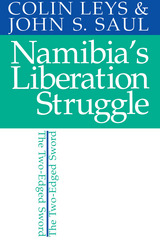 Namibia’s Liberation Struggle: The Two-Edged Sword
Colin Leys
Ohio University Press, 1994 It took twenty-three years of armed struggle before Namibia could gain its independence from South Africa in March 1990. Swapo’s victory was remarkable in the face of an overwhelmingly superior enemy. How this came about, and at what cost, is the subject of this outstanding study that is based on unpublished documents and extensive interviews with a large range of the key activists in the struggle.
The story that emerges is one of endurance and heroism in face of atrocious brutality on the part of the colonialists. But it reveals that it was also one of painful compromises imposed by the conditions of the struggle and the subordination of internal democracy within the liberation movement to the single goal of military and diplomatic victory.
The study will be of keen interest to everyone concerned with southern Africa. Students of armed liberation struggle generally will find much to challenge received wisdom. The sheer human interest of the interviews makes the book attractive to a wide readership.
 Naming and Necessity
Saul A. Kripke
Harvard University Press, 1980 If there is such a thing as essential reading in metaphysics or in philosophy of language, this is it.
Ever since the publication of its original version, Naming and Necessity has had great and increasing influence. It redirected philosophical attention to neglected questions of natural and metaphysical necessity and to the connections between these and theories of reference, in particular of naming, and of identity. From a critique of the dominant tendency to assimilate names to descriptions and more generally to treat their reference as a function of their Fregean sense, surprisingly deep and widespread consequences may be drawn. The largely discredited distinction between accidental and essential properties, both of individual things (including people) and of kinds of things, is revived. So is a consequent view of science as what seeks out the essences of natural kinds. Traditional objections to such views are dealt with by sharpening distinctions between epistemic and metaphysical necessity; in particular by the startling admission of necessary a posteriori truths. From these, in particular from identity statements using rigid designators whether of things or of kinds, further remarkable consequences are drawn for the natures of things, of people, and of kinds; strong objections follow, for example to identity versions of materialism as a theory of the mind.
This seminal work, to which today's thriving essentialist metaphysics largely owes its impetus, is here published with a substantial new Preface by the author.
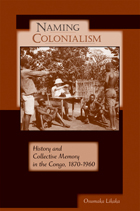 Naming Colonialism: History and Collective Memory in the Congo, 1870–1960
Osumaka Likaka
University of Wisconsin Press, 2009 What’s in a name? As Osumaka Likaka argues in this illuminating study, the names that Congolese villagers gave to European colonizers reveal much about how Africans experienced and reacted to colonialism. The arrival of explorers, missionaries, administrators, and company agents allowed Africans to observe Westerners’ physical appearances, behavior, and cultural practices at close range—often resulting in subtle yet trenchant critiques. By naming Europeans, Africans turned a universal practice into a local mnemonic system, recording and preserving the village’s understanding of colonialism in the form of pithy verbal expressions that were easy to remember and transmit across localities, regions, and generations.
Methodologically innovative, Naming Colonialism advances a new approach that shows how a cultural process—the naming of Europeans—can provide a point of entry into economic and social histories. Drawing on archival documents and oral interviews, Likaka encounters and analyzes a welter of coded fragments. The vivid epithets Congolese gave to rubber company agents—“the home burner,” “Leopard,” “Beat, beat,” “The hippopotamus-hide whip”—clearly conveyed the violence that underpinned colonial extractive economies. Other names were subtler, hinting at derogatory meaning by way of riddles, metaphors, or symbols to which the Europeans were oblivious. Africans thus emerge from this study as autonomous actors whose capacity to observe, categorize, and evaluate reverses our usual optic, providing a critical window on Central African colonialism in its local and regional dimensions.
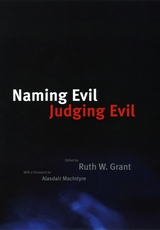 Naming Evil, Judging Evil
Edited by Ruth W. Grant
University of Chicago Press, 2006 Is it more dangerous to call something evil or not to? This fundamental question deeply divides those who fear that the term oversimplifies grave problems and those who worry that, to effectively address such issues as terrorism and genocide, we must first acknowledge them as evil. Recognizing that the way we approach this dilemma can significantly affect both the harm we suffer and the suffering we inflict, a distinguished group of contributors engages in the debate with this series of timely and original essays.
Drawing on Western conceptions of evil from the Middle Ages to the present, these pieces demonstrate that, while it may not be possible to definitively settle moral questions, we are still able—and in fact are obligated—to make moral arguments and judgments. Using a wide variety of approaches, the authors raise tough questions: Why is so much evil perpetrated in the name of good? Could evil ever be eradicated? How can liberal democratic politics help us strike a balance between the need to pass judgment and the need to remain tolerant? Their insightful answers exemplify how the sometimes rarefied worlds of political theory, philosophy, theology, and history can illuminate pressing contemporary concerns.
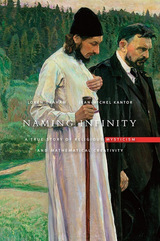 Naming Infinity: A True Story of Religious Mysticism and Mathematical Creativity
Loren Graham and Jean-Michel Kantor
Harvard University Press, 2009 In 1913, Russian imperial marines stormed an Orthodox monastery at Mt. Athos, Greece, to haul off monks engaged in a dangerously heretical practice known as Name Worshipping. Exiled to remote Russian outposts, the monks and their mystical movement went underground. Ultimately, they came across Russian intellectuals who embraced Name Worshipping—and who would achieve one of the biggest mathematical breakthroughs of the twentieth century, going beyond recent French achievements.
Loren Graham and Jean-Michel Kantor take us on an exciting mathematical mystery tour as they unravel a bizarre tale of political struggles, psychological crises, sexual complexities, and ethical dilemmas. At the core of this book is the contest between French and Russian mathematicians who sought new answers to one of the oldest puzzles in math: the nature of infinity. The French school chased rationalist solutions. The Russian mathematicians, notably Dmitri Egorov and Nikolai Luzin—who founded the famous Moscow School of Mathematics—were inspired by mystical insights attained during Name Worshipping. Their religious practice appears to have opened to them visions into the infinite—and led to the founding of descriptive set theory.
The men and women of the leading French and Russian mathematical schools are central characters in this absorbing tale that could not be told until now. Naming Infinity is a poignant human interest story that raises provocative questions about science and religion, intuition and creativity.
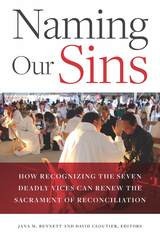 Naming Our Sins: How Recognizing the Seven Deadly Vices can Renew the Sacrament of Reconciliation
Jana Bennett
Catholic University of America Press, 2019 What would it take to renew our ability to name our sins in a meaningful and pertinent way? Naming sins is a particularly important task for Catholic moral theology, but it is one that often falls back into a paradigm of simple violations of rules. While laws and commandments are essential, Vatican II’s universal call to holiness and the revival of virtue ethics require moving further. Yet in part because moral theologians today tend to be lay people, not priests, there has been a de-emphasis on the confession of sins. Contemporary questions like poverty, racism, and abortion are usually connected to questions about sin in some way, but they are disconnected from the idea of naming specific sins in the sacrament of penance. Lay moral theologians raise these issues in a way that makes clear their implications for a parish social justice committee (or the voting booth), but not their implications for the naming of sins in the sacrament of reconciliation. Naming Our Sins proposes to re-make that connection: the moral theologian’s task of helping people name individual sins needs to be restored, though in ways distinctive from dominant pre-Vatican II notions.
In this volume, editors Jana Bennett and David Cloutier gather some of the best of the current generation of moral theologians in order to reflect on the classic tradition of the vices. It is crucial to the Christian understanding of sin that we recognize (a) we bear at least some responsibilities for injuries, and (b) God wants us to participate in the process of healing and conversion. Neither the sin itself nor the healing simply come from somewhere else; the task of naming sins enlists us as mature, growing disciples.
Each chapter takes on a different classical vice, describing the vice, exploring its dimensions in contemporary experience, and moving the reader toward naming specific sins that arise from the vice. The concluding chapters from Catholic priests explore two basic dimensions of the sacrament of penance: liturgical and communal.
 Naming Racism, Confronting Anti-Blackness: Mexican American Transnational Racialization and Coalition Building
Bianca Sofia Rubalcava
Rutgers University Press, 2026 What happens when we move beyond a Black-and-white understanding of racism? This provocative book challenges conventional narratives by exploring how Mexican Americans navigate the U.S. racial hierarchy—not simply as victims of white supremacy, but as complex participants in systems of racial oppression. Tracing the construction of race from colonial regimes to the present, author Bianca Sofia Rubalcava argues that non-Black people of color, particularly Mexican Americans, often negotiate their racial position by distancing themselves from Blackness. Through legal history, social movement archives, and survey data, this work reveals how anti-Blackness has persisted across borders and generations, from the pursuit of legal whiteness to enduring family biases around interracial relationships. Ultimately, the book offers a powerful critique of how anti-Black ideologies hinder cross-racial solidarity and perpetuate marginalization. A bold and necessary intervention, this study pushes the Latinx community—and all readers—to confront complicity and reimagine racial justice in more inclusive and transformative ways.
Naming the Dawn
Abdourahman A. Waberi
Seagull Books, 2018 The poems in this new volume by Abdourahman A. Waberi are introspective and inquisitive, reflecting a deep spiritual bond—with words, with the history of Islam and its great poets, with the landscapes those poets walked, among which Waberi grew up. The sage yearns here for the simplicity of each individual moment to somehow become eternal, for the histories and people that are part of him—his mother, his wife, his unborn child, the sacred texts that ground his being—to come together harmoniously within him, and to emerge through his words. Lyrical and personal, but with powerful historical and cultural resonances, these poems are the work of a master at the height of his powers.
 Naming the Local: Medicine, Language, and Identity in Korea since the Fifteenth Century
Soyoung Suh
Harvard University Press, 2017 Naming the Local uncovers how Koreans domesticated foreign medical novelties on their own terms, while simultaneously modifying the Korea-specific expressions of illness and wellness to make them accessible to the wider network of scholars and audiences.
Due to Korea’s geopolitical position and the intrinsic tension of medicine’s efforts to balance the local and the universal, Soyung Suh argues that Koreans’ attempts to officially document indigenous categories in a particular linguistic form required constant negotiation of their own conceptual boundaries against the Chinese, Japanese, and American authorities that had largely shaped the medical knowledge grid. The birth, decline, and afterlife of five terminologies—materia medica, the geography of the medical tradition, the body, medical commodities, and illness—illuminate an irresolvable dualism at the heart of the Korean endeavor to name the indigenous attributes of medicine.
By tracing Korean-educated agents’ efforts to articulate the vernacular nomenclature of medicine over time, this book examines the limitations and possibilities of creating a mode of “Koreanness” in medicine—and the Korean manifestation of cultural and national identities.
 Naming the Wind
Steven Rood
Omnidawn, 2022 Poems that navigate the complexities of human relationships, personal ethics, and religious tradition.
Wind moves through this collection, opening the poems to the dying beauty of the natural world, to the weathers inside the psyche and without, and to the connections between a family and between the speaker his mentor, the great poet Jack Gilbert. The collection navigates the intimacies of human relationships with others, the challenges of working as a lawyer trying to maintain integrity as others fall prey to corporate greed, and the complexity of holding a Jewish identity while being awake to tradition’s hold on the mind and its cost. Steven Rood offers a powerful account of how to be a human in dynamic relationships while also holding respect for the non-human beings that comprise most of the life on our planet.
Rood employs structures and forms that directly relate to the content of the poems themselves. Spontaneous breaks and starts reflect the writer’s turns of mind, offering readers insight into the meaning and measure of the work.
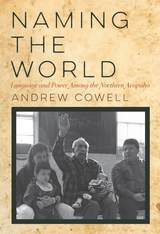 Naming the World: Language and Power Among the Northern Arapaho
Andrew Cowell
University of Arizona Press, 2018 Naming the World examines language shift among the Northern Arapaho of the Wind River Reservation, Wyoming, and the community’s diverse responses as it seeks social continuity. Andrew Cowell argues that, rather than a single “Arapaho culture,” we find five distinctive communities of practice on the reservation, each with differing perspectives on social and more-than-human power and the human relationships that enact power.
As the Arapaho people resist Euro-American assimilation or domination, the Arapaho language and the idea that the language is sacred are key rallying points—but also key points of contestation. Cowell finds that while many at Wind River see the language as crucial for maintaining access to more-than-human power, others primarily view the language in terms of peer-oriented identities as Arapaho, Indian, or non-White. These different views lead to quite different language usage and attitudes in relation to place naming, personal naming, cultural metaphors, new word formation, and the understudied practice of folk etymology.
Cowell presents data from conversations and other natural discourse to show the diversity of everyday speech and attitudes, and he links these data to broader debates at Wind River and globally about the future organization of indigenous societies and the nature of Arapaho and indigenous identity.
Naming What We Know, Classroom Edition: Threshold Concepts of Writing Studies
Linda Adler-Kassner
Utah State University Press, 2016 Naming What We Know, Classroom Edition examines the core principles of knowledge in the discipline of writing studies, using the lens of “threshold concepts”—concepts that are critical for epistemological participation in a discipline. This edition focuses on the working definitions of thirty-seven threshold concepts that run throughout the research, teaching, assessment, and public work in writing studies. Developed from the highly regarded original edition in response to grassroots demand from teachers in writing programs around the United States and written by some of the field’s most active researchers and teachers, the classroom edition is clear and accessible for an audience of even first-year writing students.
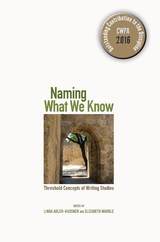 Naming What We Know: Threshold Concepts of Writing Studies
Linda Adler-Kassner
Utah State University Press, 2015 Naming What We Know examines the core principles of knowledge in the discipline of writing studies using the lens of “threshold concepts”—concepts that are critical for epistemological participation in a discipline. The first part of the book defines and describes thirty-seven threshold concepts of the discipline in entries written by some of the field’s most active researchers and teachers, all of whom participated in a collaborative wiki discussion guided by the editors. These entries are clear and accessible, written for an audience of writing scholars, students, and colleagues in other disciplines and policy makers outside the academy. Contributors describe the conceptual background of the field and the principles that run throughout practice, whether in research, teaching, assessment, or public work around writing. Chapters in the second part of the book describe the benefits and challenges of using threshold concepts in specific sites—first-year writing programs, WAC/WID programs, writing centers, writing majors—and for professional development to present this framework in action.
Naming What We Know opens a dialogue about the concepts that writing scholars and teachers agree are critical and about why those concepts should and do matter to people outside the field.
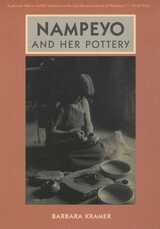 Nampeyo and Her Pottery
Barbara Kramer
University of Arizona Press, 1996 At the beginning of the twentieth century, Hopi-Tewa potter Nampeyo revitalized Hopi pottery by creating a contemporary style inspired by prehistoric ceramics. Nampeyo (ca. 1860-1942) made clay pots at a time when her people had begun using manufactured vessels, and her skill helped convert pottery-making from a utilitarian process to an art form. The only potter known by name from that era, her work was unsigned and widely collected. Travel brochures on the Southwest featured her work, and in 1905 and 1907 she was a potter in residence at Grand Canyon National Park's Hopi House. This first biography of the influential artist is a meticulously researched account of Nampeyo's life and times. Barbara Kramer draws on historical documents and comments by family members not only to reconstruct Nampeyo's life but also to create a composite description of her pottery-making process, from gathering clay through coiling, painting, and firing. The book also depicts changes brought about on the Hopi reservation by outsiders and the response of American society to Native American arts.
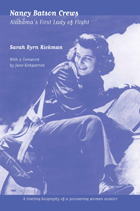 Nancy Batson Crews: Alabama's First Lady of Flight
Sarah Byrn Rickman
University of Alabama Press, 2009 A riveting oral history/biography of a pioneering woman aviator.
This is the story of an uncommon woman--high school cheerleader, campus queen, airplane pilot, wife, mother, politician, business-woman--who epitomizes the struggles and freedoms of women in 20th-century America, as they first began to believe they could live full lives and demanded to do so. World War II offered women the opportunity to contribute to the work of the country, and Nancy Batson Crews was one woman who made the most of her privileged beginnings and youthful talents and opportunities.
In love with flying from the time she first saw Charles Lindbergh in Birmingham, (October 1927), Crews began her aviation career in 1939 as one of only five young women chosen for Civilian Pilot Training at the University of Alabama. Later, Crews became the 20th woman of 28 to qualify as an "Original" Women's Auxiliary Ferrying Squadron (WAFS) pilot, employed during World War II shuttling P-38, P-47, and P-51 high-performance aircrafts from factory to staging areas and to and from maintenance and training sites. Before the war was over, 1,102 American women would qualify to fly Army airplanes. Many of these female pilots were forced out of aviation after the war as males returning from combat theater assignments took over their roles. But Crews continued to fly, from gliders to turbojets to J-3 Cubs, in a postwar career that began in California and then resumed in Alabama.
The author was a freelance journalist looking to write about the WASP (Women Airforce Service Pilots) when she met an elderly, but still vital, Nancy Batson Crews. The former aviatrix held a reunion of the surviving nine WAFS for an interview with them and Crews, recording hours of her own testimony and remembrance before Crews's death from cancer in 2001. After helping lead the fight in the '70s for WASP to win veteran status, it was fitting that Nancy Batson Crews was buried with full military honors.
Nancy Drew and Company: Culture, Gender, and Girls’ Series
Edited by Sherrie A. Inness
University of Wisconsin Press, 1997 This intriguing anthology brings together a broad range of critical essays on girls’ series fiction from established scholars such as Chamberlain, Johnson, and Romalov, along with emerging scholars Katrine Poe, Maureen Reed, and Deborah Siegel. Topics include: Anne of Green Gables, the Isabel Carleton series, early twentieth-century girls’ automobile series, girls’ scouting novels, 1910–1935, Cherry Ames in World War II, Nancy Drew, and Judy Bolton.
 Nancy Hanks, An Intimate Portrait: The Creation of a National Commitment to the Arts
Michael Straight
Duke University Press, 1988 Nancy Hanks, Chairman of the National Endowment for the Arts (NEA) from 1969 to 1977, turned this fledgling organization into a major instrument for government support of the arts—accomplishing thereby a virtual revolution in the public arts policy of the United States. She died of cancer on January 7, 1983; later that year, at the request of Congress, President Ronald Reagan designated the building complex at Pennsylvania Avenue and 11th Street (the "Old Post Office") in Washington, D.C., as the Nancy Hanks Center. This biography captures the spirit and the flavor of Ms. Hanks's remarkable life, above all during the eight years in which she led the Endowment. Tracing her childhood in Florida and North Carolina through her achievements as a student leader at Duke University, Straight makes clear her conscious effort to find a path with more scope than the usual marriage-and-a-family when expected of Southern women. Nancy Hanks went to Washington and found a job with the Office of War Mobilization. She later worked with Nelson Rockefeller, who became governor of New York, a Republican party luminary, and vice president under Gerald Ford, in addition to being an heir to one of America's greatest fortunes. Her relationship with Rockefeller was crucial to her personal life, and his conception of government and its role and a lasting influence on her career. Straight examines Nancy Hanks's leadership of the NEA and takes particular note of the intense debate over the role of government in fostering American artistic expression, an issue with roots running back through the New Deal to the early history of the United States. Nancy Hanks took a strong and activist role in the formulation and administration of a national arts policy, and her accomplishments have left an indelible mark on public support for arts in the United States. Straight, who worked closely with Ms. Hanks and admired her despite frequent policy disagreements, deals honestly with both the successes and failures of her efforts. His biography imparts a sense of the reasons why her many friends felt such loyalty to this complex and gifted woman.
Nanoantennas and Plasmonics: Modelling, design and fabrication
Douglas H. Werner
The Institution of Engineering and Technology, 2020 This book presents cutting-edge research advances in the rapidly growing areas of nanoantennas and plasmonics as well as their related enabling technologies and applications. It provides a comprehensive treatment of the field on subjects ranging from fundamental theoretical principles and new technological developments, to state-of-the-art device design, as well as examples encompassing a wide range of related sub-areas. The content of the book also covers highly-directive nanoantennas, all-dielectric and tuneable/reconfigurable devices, metasurface optical components, and other related topics.
Nanoart: The Immateriality of Art
Paul Thomas
Intellect Books, 2013 Examining art that intersects with science and seeks to make visible what cannot ordinarily be seen with the naked eye, provides thorough insight into new understandings of materiality and life. It includes an extensive overview of the history of nanoart from the work of Umberto Boccioni right up to present-day artists. The author looks specifically at art inspired by nanotechnological research made possible by the Scanning Tunneling Microscope and Atomic Force Microscope in the 1980s, as well as the development of other instruments of nanotechnological experimentation. Nanoart is a sustained consideration of this fascinating artistic approach that challenge how we see and understand our world.
 Nanobiosensors for Personalized and Onsite Biomedical Diagnosis
Pranjal Chandra
The Institution of Engineering and Technology, 2016 Nanobiosensors have been successful for in vitro as well as in vivo detection of several biomolecules and it is expected that this technology will revolutionize point-of-care and personalized diagnostics, and will be extremely applicable for early disease detection and therapeutic applications. This book describes the emerging nanobiosensor technologies which are geared towards onsite clinical applications and those which can be used as a personalised diagnostic device. Biosensor technologies and materials covered include electrochemical biosensors; implantable microbiosensors; microfluidic technology; surface plasmon resonance-based technologies; optical and fibre-optic sensors; lateral flow biosensors; lab on a chip; nanomaterials based (graphene, nanoparticles, nanocomposites, and other carbon nanomaterial) sensors; metallic nanobiosensors; wearable and doppler-based non-contact vital signs biosensors; and technologies for smartphone based disease diagnosis. Clinical applications of these technologies covered in this book include detection of various protein biomarkers, small molecules, cancer and bacterial cells; detection of foodborne pathogens; generation and optimisation of antibodies for biosensor applications; microRNAs and their applications in diagnosis for osteoarthritis; detection of circulating tumor cells; online heartbeat monitoring; analysis of drugs in body fluids; sensing of nucleic acids; and monitoring oxidative stress.
Nano-CMOS and Post-CMOS Electronics: Circuits and design, Volume 2
Saraju P. Mohanty
The Institution of Engineering and Technology, 2016 The demand for ever smaller and portable electronic devices has driven metal oxide semiconductor-based (CMOS) technology to its physical limit with the smallest possible feature sizes. This presents various size-related problems such as high power leakage, low-reliability, and thermal effects, and is a limit on further miniaturization. To enable even smaller electronics, various nanodevices including carbon nanotube transistors, graphene transistors, tunnel transistors and memristors (collectively called post-CMOS devices) are emerging that could replace the traditional and ubiquitous silicon transistor. This book explores these nanoelectronics at the circuit and systems levels including modelling and design approaches and issues.
Nano-CMOS and Post-CMOS Electronics: Devices and modelling, Volume 1
Saraju P. Mohanty
The Institution of Engineering and Technology, 2016 The demand for ever smaller and portable electronic devices has driven metal oxide semiconductor-based (CMOS) technology to its physical limit with the smallest possible feature sizes. This presents various size-related problems such as high power leakage, low-reliability, and thermal effects, and is a limit on further miniaturization. To enable even smaller electronics, various nanodevices including carbon nanotube transistors, graphene transistors, tunnel transistors and memristors (collectively called post-CMOS devices) are emerging that could replace the traditional and ubiquitous silicon transistor. This book explores these nanoelectronics at the device level including modelling and design.
 NanoCulture: Implications of the New Technoscience
Edited by N. Katherine Hayles
Intellect Books, 2004 "Nano" denotes a billionth; a nanometer is a billionth of a meter. New instrumentation and techniques have for the first time made possible materials research and engineering at this level, the scale of individual molecules and atoms.
Extraordinary visions of material abundance, unprecedented materials, and powerful engineering capabilities have marked the arrival of nanotechnology, as well as dystopian scenarios of self-replicating devices running amok and causing global catastrophe. Largely a future possibility rather than present actuality, nanotechnology has become a potent cultural signifier.
NanoCulture explores the ways in which nanotechnology interacts with, and itself becomes, a cultural construction. Topics include the co-construction of nanoscience and science fiction; the influence of risk assessment and nanotechnology on the shapes of narratives; intersections between nanoscience as a writing practice and experimental literature at the limits of fabrication; the Alice-in-Wonderland metaphor for nanotechnology; and the effects of mediation on nanotechnology and electronic literature.
NanoCulture is produced in collaboration with the nano art exhibit at the Los Angeles County Museum of Art (December 2003-September 2004), created by an interdisciplinary team led by media artist Victoria Vesna and nanoscientist James Gimzewski. NanoCulture is richly illustrated with images from the nano exhibit, which also provides the basis for an ethnographic analysis of collaborative process and an exploration of changing concepts of museum space.
The dynamic uniting these diverse perspectives is boundary crossing: between art, science, and literature; cultural imaginaries, scientific facts, and technological possibilities; actual. virtual, and hybrid spaces; the science of fictions and the fictions of science; and utopian dreams, material constraints, and dystopian nightmares.
The first book-length study focus on cultural implications of nanotechnology, NanoCulture breaks new ground in showing the importance of the new technoscience to contemporary culture and of culture to the development, interpretation, and future of this technoscience.
Nano-Electromagnetic Communication at Terahertz and Optical Frequencies: Principles and Applications
Akram Alomainy
The Institution of Engineering and Technology, 2020 Recent advancements in carbon and molecular electronics have opened the door to a new generation of electronic nanoscale components. This book outlines the basic principles of electromagnetic-based communication at this nanoscale using terahertz and optical frequencies with a focus on theoretical principles and applications. It answers the questions: How can nano-devices communicate with each other by applying electromagnetic techniques? Do conventional communication and networking schemes and principles still apply? How feasible is it to deploy such networks with various applications?
 Nanofibres in Drug Delivery
Gareth R. Williams, Bahijja T. Raimi-Abraham, and C. J. Luo
University College London, 2018 In recent years, there has been an explosion of interest in the production of nanoscale fibers for drug delivery and tissue engineering. Nanofibres in Drug Delivery aims to outline to new researchers in the field the utility of nanofibers in drug delivery, and to explain to them how to prepare fibers in the laboratory. The book begins with a brief discussion of the main concepts in pharmaceutical science. The authors then introduce the key techniques that can be used for fiber production and explain briefly the theory behind them. They discuss the experimental implementation of fiber production, starting with the simplest possible set-up and then moving on to consider more complex arrangements. As they do so, they offer advice from their own experience of fiber production, and use examples from current literature to show how each particular type of fibers can be applied to drug delivery. They also consider how fiber production could be moved beyond the research laboratory into industry, discussing regulatory and scale-up aspects.
Nanogrids and Picogrids and their Integration with Electric Vehicles
Surajit Chattopadhyay
The Institution of Engineering and Technology, 2022 Nanogrids are small energy grids, powered by various generators often including photovoltaics. For example, a nanogrid might supply a village in a rural area and allow that village to trade its surplus energy. A picogrid is a still smaller energy grid. IRENA defines nanogrids as systems handling up to 5 kW of power while picogrids handle up to 1 kW.
Nano-Scaled Semiconductor Devices: Physics, modelling, characterisation, and societal impact
Edmundo A. Gutiérrez-D
The Institution of Engineering and Technology, 2016 The rapid evolution of integrated circuit technology has brought with it many new materials and processing steps at the nano-scale which boost the electrical performance of devices, resulting in faster and more functionally-complex electronics. However, working at this reduced scale can bring second order effects that degrade efficiency and reliability.
Nanotechnologies
Michel Wautelet
The Institution of Engineering and Technology, 2009 How can single atoms be manipulated? Are the laws of physics still valid at the nanostructure scale? How could nanotechnologies help cure disease? What are the application fields of nanotechnologies and what ethical issues do they raise? These questions and many others are answered in this clearly presented, fascinating book.
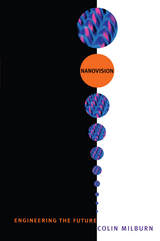 Nanovision: Engineering the Future
Colin Milburn
Duke University Press, 2008 The dawning era of nanotechnology promises to transform life as we know it. Visionary scientists are engineering materials and devices at the molecular scale that will forever alter the way we think about our technologies, our societies, our bodies, and even reality itself. Colin Milburn argues that the rise of nanotechnology involves a way of seeing that he calls “nanovision.” Trekking across the technoscapes and the dreamscapes of nanotechnology, he elaborates a theory of nanovision, demonstrating that nanotechnology has depended throughout its history on a symbiotic relationship with science fiction. Nanotechnology’s scientific theories, laboratory instruments, and research programs are inextricable from speculative visions, hyperbolic rhetoric, and fictional narratives. Milburn illuminates the practices of nanotechnology by examining an enormous range of cultural artifacts, including scientific research articles, engineering textbooks, laboratory images, popular science writings, novels, comic books, and blockbuster films. In so doing, he reveals connections between the technologies of visualization that have helped inaugurate nano research, such as the scanning tunneling microscope, and the prescient writings of Robert A. Heinlein, James Blish, and Theodore Sturgeon. He delves into fictive and scientific representations of “gray goo,” the nightmare scenario in which autonomous nanobots rise up in rebellion and wreak havoc on the world. He shows that nanoscience and “splatterpunk” novels share a violent aesthetic of disintegration: the biological body is breached and torn asunder only to be refabricated as an assemblage of self-organizing machines. Whether in high-tech laboratories or science fiction stories, nanovision deconstructs the human subject and galvanizes the invention of a posthuman future.
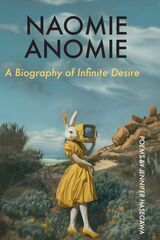 NAOMIE ANOMIE: A Biography of Infinite Desire
Jennifer Hasegawa
Omnidawn, 2025 A surreal story in verse that follows a woman facing the outbreak of the COVID-19 pandemic alongside ecological crisis and crumbling social norms.
Jennifer Hasegawa’s NAOMIE ANOMIE: A Biography of Infinite Desire, is an experimental poetic take on biography, growing increasingly surreal as it follows the truths behind its unreliable narrator through paradoxes rendered in luxurious detail. This book is a portrait of a flawed life, a call for attention to the looming ecological crisis, and a lyrical experiment in truth-telling.
Feeling ever-increasing existential strain leading up to the COVID-19 pandemic and culminating in her decision to no longer venture outside of her apartment, Naomie is not surprised to find her name is an anagram for anomie, a term for the breakdown of social norms. In these pages is a meticulous account of everything that went wrong in Naomie’s five decades of life. We find retellings of a life’s most significant moments—not because they are sources of pride, but because they stand as the only decipherable moments of humanity amid a world of static. This story in verse acts as a survival guide, romance novel, liberation handbook, pulp thriller, and jokebook for those who will live through ongoing plagues, environmental change, total AI integration, water wars, and cyberattacks and who will come out the other side ready to restart.
The Naomikong Point Site and the Dimensions of Laurel in the Lake Superior Region
Donald E. Janzen
University of Michigan Press, 1968 This work presents a description and interpretation of the archaeological material from the Naomikong Point site in Michigan’s Upper Peninsula. Author Donald E. Janzen discusses the site, which he assigns to the Laurel culture, in terms of its relationship to other northern Middle Woodland sites.
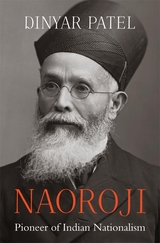 Naoroji: Pioneer of Indian Nationalism
Dinyar Patel
Harvard University Press, 2020 Winner of the 2021 Kamaladevi Chattopadhyay–NIF Book Prize
The definitive biography of Dadabhai Naoroji, the nineteenth-century activist who founded the Indian National Congress, was the first British MP of Indian origin, and inspired Gandhi and Nehru.
Mahatma Gandhi called Dadabhai Naoroji the “father of the nation,” a title that today is reserved for Gandhi himself. Dinyar Patel examines the extraordinary life of this foundational figure in India’s modern political history, a devastating critic of British colonialism who served in Parliament as the first-ever Indian MP, forged ties with anti-imperialists around the world, and established self-rule or swaraj as India’s objective.
Naoroji’s political career evolved in three distinct phases. He began as the activist who formulated the “drain of wealth” theory, which held the British Raj responsible for India’s crippling poverty and devastating famines. His ideas upended conventional wisdom holding that colonialism was beneficial for Indian subjects and put a generation of imperial officials on the defensive. Next, he attempted to influence the British Parliament to institute political reforms. He immersed himself in British politics, forging links with socialists, Irish home rulers, suffragists, and critics of empire. With these allies, Naoroji clinched his landmark election to the House of Commons in 1892, an event noticed by colonial subjects around the world. Finally, in his twilight years he grew disillusioned with parliamentary politics and became more radical. He strengthened his ties with British and European socialists, reached out to American anti-imperialists and Progressives, and fully enunciated his demand for swaraj. Only self-rule, he declared, could remedy the economic ills brought about by British control in India.
Naoroji is the first comprehensive study of the most significant Indian nationalist leader before Gandhi.
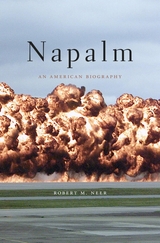 Napalm: An American Biography
Robert M. Neer
Harvard University Press, 2013 Napalm, incendiary gel that sticks to skin and burns to the bone, came into the world on Valentine’s Day 1942 at a secret Harvard war research laboratory. On March 9, 1945, it created an inferno that killed over 87,500 people in Tokyo—more than died in the atomic explosions at Hiroshima or Nagasaki. It went on to incinerate sixty-four of Japan’s largest cities. The Bomb got the press, but napalm did the work.
After World War II, the incendiary held the line against communism in Greece and Korea—Napalm Day led the 1950 counter-attack from Inchon—and fought elsewhere under many flags. Americans generally applauded, until the Vietnam War. Today, napalm lives on as a pariah: a symbol of American cruelty and the misguided use of power, according to anti-war protesters in the 1960s and popular culture from Apocalypse Now to the punk band Napalm Death and British street artist Banksy. Its use by Serbia in 1994 and by the United States in Iraq in 2003 drew condemnation. United Nations delegates judged deployment against concentrations of civilians a war crime in 1980. After thirty-one years, America joined the global consensus, in 2011.
Robert Neer has written the first history of napalm, from its inaugural test on the Harvard College soccer field, to a Marine Corps plan to attack Japan with millions of bats armed with tiny napalm time bombs, to the reflections of Phan Thi Kim Phuc, a girl who knew firsthand about its power and its morality.
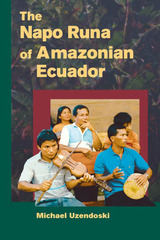 The Napo Runa of Amazonian Ecuador
Michael Uzendoski
University of Illinois Press, 2005 Michael Uzendoski's theoretically informed work analyzes value from the perspective of the Napo Runa people of the Amazonian Ecuador. Based upon historical and archival research, as well as the author's years of fieldwork in indigenous communities, The Napo Runa of Amazonian Ecuadorpresents theoretical issues of value, poetics, and kinship as linked to the author's intersubjective experiences in Napo Runa culture. Drawing on insights from the theory of gift and value, Uzendoski argues that Napo Runa culture personifies value by transforming things into people through a process of subordinating them to human relationships. While many traditional exchange models treat the production of things as inconsequential, the Napo Runa understand production to involve a relationship with natural beings (plants, animals, and spirits of the forest) that they believe share spiritual substance, or samai. Value is the outcome of a complicated poetics of transformation by which things and persons are woven into kinship forms that define daily social and ritual life.
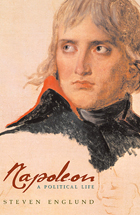 Napoleon: A Political Life
Steven Englund
Harvard University Press, 2004 Winner of the J. Russell Major Prize, American Historical Association
Best Book on the First Empire by a Foreigner, Napoleon Foundation
“Englund has written a most distinguished book recounting Bonaparte’s life with clarity and ease…This magnificent book tells us much that we did not know and gives us a great deal to think about.”—Douglas Johnson, Los Angeles Times Book Review
“Englund, in his lively biography…seeks less to rehabilitate Napoleon’s reputation and legacy than to provide readers with a fuller view of the man and his actions.”—Paula Friedman, New York Times
“Napoleon: A Political Life is a veritable tour de force: the general reader will enjoy it immensely, and learn a great deal from it. But the book also has much to offer historians of modern France.”—Sudhir Hazareesingh, Times Literary Supplement
“Englund’s incisive forays into political theory don’t diminish the force of his narrative, which impressively conveys the epochal changes confronting both France and Europe…A strikingly argued biography.”—Matthew Price, Washington Post
This sophisticated and masterful biography brings new and remarkable analysis to the study of modern history’s most famous general and statesman. As Englund charts Napoleon’s dramatic rise and fall—from his Corsican boyhood, his French education, his astonishing military victories and no less astonishing acts of reform as First Consul (1799–1804) to his controversial record as Emperor and, finally, to his exile and death—he explores the unprecedented power Napoleon maintains over the popular imagination.
 Napoleon and de Gaulle: Heroes and History
Patrice Gueniffey
Harvard University Press, 2020 An Australian Book Review Best Book of the Year
One of France’s most famous historians compares two exemplars of political and military leadership to make the unfashionable case that individuals, for better and worse, matter in history.
Historians have taught us that the past is not just a tale of heroes and wars. The anonymous millions matter and are active agents of change. But in democratizing history, we have lost track of the outsized role that individual will and charisma can play in shaping the world, especially in moments of extreme tumult. Patrice Gueniffey provides a compelling reminder in this powerful dual biography of two transformative leaders, Napoleon Bonaparte and Charles de Gaulle.
Both became national figures at times of crisis and war. They were hailed as saviors and were eager to embrace the label. They were also animated by quests for personal and national greatness, by the desire to raise France above itself and lead it on a mission to enlighten the world. Both united an embattled nation, returned it to dignity, and left a permanent political legacy—in Napoleon’s case, a form of administration and a body of civil law; in de Gaulle’s case, new political institutions. Gueniffey compares Napoleon’s and de Gaulle’s journeys to power; their methods; their ideas and writings, notably about war; and their postmortem reputations. He also contrasts their weaknesses: Napoleon’s limitless ambitions and appetite for war and de Gaulle’s capacity for cruelty, manifested most clearly in Algeria.
They were men of genuine talent and achievement, with flaws almost as pronounced as their strengths. As many nations, not least France, struggle to find their soul in a rapidly changing world, Gueniffey shows us what a difference an extraordinary leader can make.
 Napoleonic Friendship: Military Fraternity, Intimacy, and Sexuality in Nineteenth-Century France
Brian Joseph Martin
University of New Hampshire Press, 2011 Winner of the Laurence Wylie Prize in French Cultural Studies
One of the first books on “Gays in the Military” published following the historic repeal of “Don’t Ask Don’t Tell” in 2011, Napoleonic Friendship examines the history of male intimacy in the French military, from Napoleon to the First World War. Echoing the historical record of gay soldiers in the United States, Napoleonic Friendship is the first book-length study on the origin of queer soldiers in modern France. Based on extensive archival research in France, the book traces the development of affectionate friendships in the French Army from 1789 to 1916. Following the French Revolution, radical military reforms created conditions for new physical and emotional intimacy between soldiers, establishing a model of fraternal affection during the Revolutionary and Napoleonic Wars that would persist amid the ravages of the Franco-Prussian War and World War I. Through readings of Napoleonic military memoirs (and other non-fiction archival material) and French military fiction (from Hugo and Balzac to Zola and Proust), Martin examines a broad range of emotional and erotic relationships, from combat buddies to soldier lovers. He argues that the French Revolution’s emphasis on military fraternity evolved into an unprecedented sense of camaraderie in the armies of Napoleon. For many soldiers, the hardships of combat led to intimate friendships. For some, the homosociality of military life inspired mutual affection, lifelong commitment, and homoerotic desire.
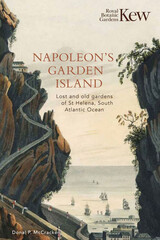 Napoleon’s Garden Island: Lost and Old Gardens of St Helena, South Atlantic Ocean
Donal P. McCracken
Royal Botanic Gardens, Kew, 2022 Napoleon’s Garden Island reveals the amazing botanical history of one remote Atlantic island.
Though the South Atlantic island of St. Helena is best known as the site of Napoleon’s exile following his final defeat in 1815, this remote locale also has a rich gardening heritage and a population of highly diverse flora, both exotic and endemic. This is due to St. Helena’s history as a stopover for the vast East India Company fleets on their way to Europe, whose cargo holds carried not only spices but also plants from China, Malaysia, and India. As a result, St. Helena became a botanical hub and the island’s private plantation houses cultivated a number of extraordinarily varied gardens.
Illustrated throughout with drawings, maps, and archival materials, Napoleon’s Garden Island looks to St. Helena’s past and future alike. McCracken explores the island’s native and introduced flora, ultimately appealing for the establishment of a new permanent garden to showcase this singular botanical blend. Turning away from the military matters that characterize most other books about St. Helena’s history, Napoleon’s Garden Island highights how a dazzling assortment of plants have thrived thousands of miles from their nearest neighbors.
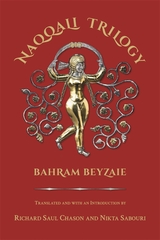 Naqqali Trilogy: Azhdahak, Arash, Testament of Bondar Bidakhsh
Bahram Beyzaie
Harvard University Press Widely regarded as the Shakespeare of Persia, Bahram Beyzaie—playwright, director, screenwriter, and scholar—has made the greatest contribution to modern Persian drama of any individual artist, yet he remains largely unknown to the English-speaking world. In this volume, Richard Saul Chason and Nikta Sabouri have translated for the first time into English Beyzaie’s complete Naqqali Trilogy, one of the dramatist’s greatest masterpieces and a pinnacle work of twentieth-century world drama.
Blending modes of traditional Iranian storytelling and mythological ritual with contemporary dramatic philosophy and technique, the Naqqali Trilogy is a cycle of three works of mythological revisionism. It celebrates a renaissance of Persian cultural tradition while reframing ancient tales into a modern psychodrama of outcasts and oppression in a land of tyranny and injustice. This volume also includes a detailed introduction that provides background information on Beyzaie, the mythological basis of the plays, the nature of the plays in performance, and on the plays’ distinctive employ of the Persian language and the replication of the dramatic prose poetry into an English equivalent.
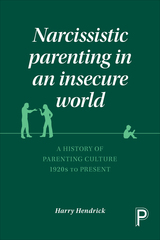 Narcissistic Parenting in an Insecure World: A History of Parenting Culture 1920 to Present
Harry Hendrick
Bristol University Press, 2016 In this provocative history of parenting, Harry Hendrick analyzes the social and economic reasons behind parenting trends. He shows how broader social changes, including neoliberalism, feminism, the collapse of the social-democratic ideal, and the “new behaviorism,” have led to the rise of the anxious and narcissistic parent. The book charts the shift from the liberal and progressive parenting styles of the 1940s through the ’70s to the more behavioral, punitive, and managerial methods of childrearing today, made popular by so-called experts like Gina Ford and Supernanny Jo Frost and—in the United Kingdom—by New Labour parent education programs. This trend, Hendrick argues, is symptomatic of the sour, mean-spirited, and vindictive social norms found throughout society today. It undermines the better instincts of parents and, therefore, damages parent-child relationships. Instead, he proposes, parents should focus on understanding and helping their children as they do the hard work of growing up.
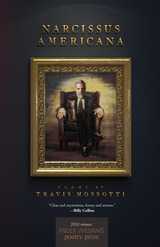 Narcissus Americana: Poems
Travis Mossotti
University of Arkansas Press, 2018 Winner, 2018 Miller Williams Poetry Prize Narcissus Americana sings and scraps and wrestles its way across various landscapes—abandoned quarries, art museums, lavish homes, and tar pits—in a quest to attain a more complex vision of what it means to be upwardly mobile. These poems question the usefulness of wealth and ownership as markers of success. Taking wine fridges and fake flowers as emblems of capitalism’s failure to assuage human loneliness, the speakers in these poems find joy in shared meals and glasses of wine, and use moments of mutual attention to challenge notions of class in America. Intimacy is on display in “Cruising Altitude,” where the speaker finds a sublime communion between two disparate worldviews during an in-flight conversation with his father: I ask if his certainty about humanity’s course gives
his life some kind of purpose. He doesn’t sleep well.
I know this. I quote Yeats. He quotes scripture.
Light balances on the wing and casts its yellow spell. . . . Sharply written, and with an eye for form, these poems engage with heavy inquiry but also know better than to take themselves too seriously, making it possible for, say, dungeons to share space with donuts, as in the poem “Rancho La Brea.” Mossotti’s timely book invites the reader to traverse America, and see the nation anew, on a journey marked simultaneously by critical scrutiny and deep affection.
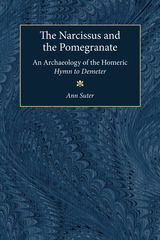 The Narcissus and the Pomegranate: An Archaeology of the Homeric Hymn to Demeter
Ann Suter
University of Michigan Press, 2002 Offering a new understanding of the Hymn to Demeter, Ann Suter provides an analysis of methodological approaches, reconciling the seemingly disparate pieces of the complex narrative of the hymn. Examining evidence from other versions of the hymn's myths, as well as from Greek religion, linguistics, and archaeology, she lends a new understanding to the relationships among the hymn's personages--Persephone, Demeter, Hades, and Zeus--as they developed and crystallized, providing a new chronology for the cults of Demeter and Persephone at Eleusis.
The author analyzes the traditional language of the hymn and Persephone's retelling of her story to Demeter, arguing that the hymn involves an earlier tale of Demeter and Persephone that predates the seventh century. Suter uses anthropological applications to illustrate that the story of Persephone's abduction does not reflect a female initiation rite into adulthood, as has been argued, but rather an hieros gamos. These methodologies point to the conclusion that Persephone was once a powerful goddess in her own right, independent of Hades and of Demeter as well. To test the accuracy of these possibilities, the book next examines evidence from outside the hymn. Other versions of the two myths in the hymn support the idea that these myths--Persephone's abduction and Demeter's nursing of Demophoön--were once separate and were late combined to create a new story. Evidence from the chief archaeological sites, from vase painting and other artistic forms is provided to enhance the argument. Thus the evidence from outside the hymn supports the conclusions of the textual analyses, giving surprising substantiation that the hymn itself commemorates the early days of the worship of the goddesses as a mother/daughter pair.
This book will be of particular interest to scholars of religious history, art history, archaeology, and literature. It is also accessible to the general reader interested in Greek literature, myths, and religion.
Ann Suter is Associate Professor of Classical Studies, University of Rhode Island.
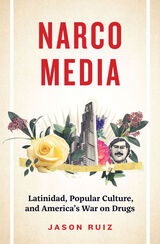 Narcomedia: Latinidad, Popular Culture, and America's War on Drugs
Jason Ruiz
University of Texas Press, 2023 2024 Honorable Mention — The Victor Villaseñor Best Latino Focused Nonfiction Book Award – English, Empowering Latino Futures’ International Latino Book Awards
Exploring representations of Latinx people from Scarface to Narcos, this book examines how pop culture has framed Latin America as the villain in America’s long and ineffectual War on Drugs. If there is an enemy in the War on Drugs, it is people of color. That is the lesson of forty years of cultural production in the United States. Popular culture, from Scarface and Miami Vice to Narcos and Better Call Saul, has continually positioned Latinos as an alien people who threaten the US body politic with drugs. Jason Ruiz explores the creation and endurance of this trope, its effects on Latin Americans and Latinx people, and its role in the cultural politics of the War on Drugs. Even as the focus of drug anxiety has shifted over the years from cocaine to crack and from methamphetamines to opioids, and even as significant strides have been made in representational politics in many areas of pop culture, Latinx people remain an unshakeable fixture in stories narrating the production, distribution, and sale of narcotics. Narcomedia argues that such representations of Latinx people, regardless of the intentions of their creators, are best understood as a cultural front in the War on Drugs. Latinos and Latin Americans are not actually America’s drug problem, yet many Americans think otherwise—and that is in no small part because popular culture has largely refused to imagine the drug trade any other way.
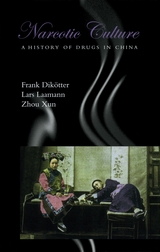 Narcotic Culture: A History of Drugs in China
Frank Dikötter, Lars Laamann, and Zhou Xun
University of Chicago Press, 2004 To this day, the perception persists that China was a civilization defeated by imperialist Britain's most desirable trade commodity, opium—a drug that turned the Chinese into cadaverous addicts in the iron grip of dependence. Britain, in an effort to reverse the damage caused by opium addiction, launched its own version of the "war on drugs," which lasted roughly sixty years, from 1880 to World War II and the beginning of Chinese communism. But, as Narcotic Culture brilliantly shows, the real scandal in Chinese history was not the expansion of the drug trade by Britain in the early nineteenth century, but rather the failure of the British to grasp the consequences of prohibition.
In a stunning historical reversal, Frank Dikötter, Lars Laamann, and Zhou Xun tell this different story of the relationship between opium and the Chinese. They reveal that opium actually had few harmful effects on either health or longevity; in fact, it was prepared and appreciated in highly complex rituals with inbuilt constraints preventing excessive use. Opium was even used as a medicinal panacea in China before the availability of aspirin and penicillin. But as a result of the British effort to eradicate opium, the Chinese turned from the relatively benign use of that drug to heroin, morphine, cocaine, and countless other psychoactive substances. Narcotic Culture provides abundant evidence that the transition from a tolerated opium culture to a system of prohibition produced a "cure" that was far worse than the disease.
Delving into a history of drugs and their abuses, Narcotic Culture is part revisionist history of imperial and twentieth-century Britain and part sobering portrait of the dangers of prohibition.
The Nariokotome Homo erectus Skeleton
Alan Walker
Harvard University Press, 1993 On the slopes of the Nariokotome sand river in Kenya, sifting through sediments more than a million years old, Kamoya Kimeu uncovered a small piece of a skull. Piece followed piece—facial bones, teeth, vertebrae—and little by little paleontologists put together the most complete early hominid ever discovered, a Homo erectus skeleton christened the Nariokotome boy. This phenomenal find, a milestone in the history of paleoanthropology, is fully documented in this remarkable book. Beautifully illustrated and richly descriptive, The Nariokotome Homo erectus Skeleton takes us into the field and the laboratory, and into the far reaches of prehistory, to show us what the fossilized remains of a young boy can tell us about our beginnings.
Narrating Democracy in Myanmar: The Struggle Between Activists, Democratic Leaders and Aid Workers
Tamas Wells
Amsterdam University Press, 2021 This book analyses what Myanmar’s struggle for democracy has signified to Burmese activists and democratic leaders, and to their international allies. In doing so, it explores how understanding contested meanings of democracy helps make sense of the country’s tortuous path since Aung San Suu Kyi’s National League for Democracy won historic elections in 2015. Using Burmese and English language sources, Narrating Democracy in Myanmar reveals how the country’s ongoing struggles for democracy exist not only in opposition to Burmese military elites, but also within networks of local activists and democratic leaders, and international aid workers.
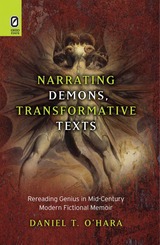 Narrating Demons, Transformative Texts: Rereading Genius in Mid-Century Modern Fictional Memoir
Daniel T. O’Hara
Ohio State University Press, 2012 Narrating Demons, Transformative Texts: Rereading Genius in Mid-Century Modern Fictional Memoir, by Daniel T. O’Hara, acknowledges that the modern conception of literary genius is probably most lucidly expressed in the criticism of Lionel Trilling. But O’Hara also demonstrates that certain important and widely read mid-century modern fictional memoirs subversively return to an earlier conception that emphasizes the demonic nature of genius, a conception that is associated with the occult and the visionary and embraces the vision of evil articulated in earlier literature. O’Hara argues that Thomas Mann’s Doctor Faustus (1947), Vladimir Nabokov’s Lolita (1955), and William Burroughs’s Naked Lunch (1959) all demonstrate an imagining of genius in art and in life that stands in stark and total opposition to the emerging post–World War II age of conformity. These influential works show that genius is inherently a dangerous reality, albeit a creative one. Despite its most transcendent appearances, the full immanence of this conception of demonic genius condemns the modern world to a Last Judgment that is every bit as severe as any envisioned in the Western religious traditions.
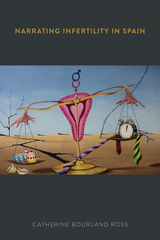 Narrating Infertility in Spain
Catherine Bourland Ross
Bucknell University Press, 2026 The drop in Spanish birth rates in 1998 to their lowest level of 1.1 births per woman was accompanied by a boom in publishing about motherhood. New narrative forms, ranging from blogs to diaries to comics, expressed women’s experiences, including ambivalence about motherhood in the face of societal pressures. Narrating Infertility in Spain, the first study of infertility in post-2008 female-authored texts, analyzes discussions of adoption, assisted reproduction, egg and sperm donation, and the decision not to have children due to economic or social instability. By examining the work of writers and vocal activists Silvia Nanclares, Raquel Sánchez-Silva, Samanta Villar, Laura Freixas, and Diana López Varela, Ross situates infertility in Spain within the cultural context of the Great Recession, while considering it as a business, a crisis, a stigma, and a class issue, and offering broader understandings of contemporary fertility challenges in Spain and beyond.
Published by Bucknell University Press. Distributed worldwide by Rutgers University Press.
Narrating Jane: Telling the Story of an Early African American Mormon Woman
Quincy D. Newell
Utah State University Press, 2016 In volume 21 of the Arrington Lecture Series, Quincy Newell studies the life of Jane Elizabeth Manning James, an African American, born in 1822, who converted to Mormonism in 1843. The narrative of Jane's life has to date been told in versions that favored official LDS positions on race and gender at the time of their telling. Newell's study here brings contemporary historical scholarship and critical distance to bear on the facts and the meanings of Jane M. James's experience. The Arrington Lecture series, established by one of the twentieth-century West's most distinguished historians, Leonard Arrington, has become a leading forum for prominent historians to address topics related to Mormon history. Utah State University hosts the Leonard J. Arrington Mormon History Lecture Series through the Merrill-Cazier Library Special Collections and Archives department.
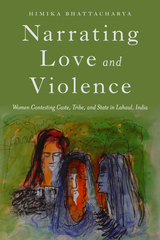 Narrating Love and Violence: Women Contesting Caste, Tribe, and State in Lahaul, India
Bhattacharya, Himika
Rutgers University Press, 2017 Narrating Love and Violence is an ethnographic exploration of women’s stories from the Himalayan valley of Lahaul, in the region of Himachal Pradesh, India, focusing on how both, love and violence emerge (or function) at the intersection of gender, tribe, caste, and the state in India. Himika Bhattacharya privileges the everyday lives of women marginalized by caste and tribe to show how state and community discourses about gendered violence serve as proxy for caste in India, thus not only upholding these social hierarchies, but also enabling violence.
The women in this book tell their stories through love, articulated as rejection, redefinition and reproduction of notions of violence and solidarity. Himika Bhattacharya centers the women’s narratives as a site of knowledge—beyond love and beyond violence. This book shows how women on the margins of tribe and caste know both, love and violence, as agents wishing to re-shape discourses of caste, tribe and community.
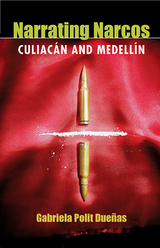 Narrating Narcos: Culiacán and Medellín
Gabriela Polit Dueñas
University of Pittsburgh Press, 2013 Narrating Narcos presents a probing examination of the prominent role of narcotics trafficking in contemporary Latin American cultural production. In her study, Gabriela Polit Dueñas juxtaposes two infamous narco regions, Culiacán, Mexico, and Medellín, Colombia, to demonstrate the powerful forces of violence, corruption, and avarice and their influence over locally based cultural texts.
Polit Dueñas provides a theoretical basis for her methods, citing the work of Walter Benjamin, Pierre Bourdieu, and other cultural analysts. She supplements this with extensive ethnographic fieldwork, interviewing artists and writers, their confidants, relatives, and others, and documents their responses to the portrayal of narco culture. Polit Dueñas offers close readings of the characters, language, and milieu of popular works of literature and the visual arts and relates their ethical and thematic undercurrents to real life experiences. In both regions, there are few individuals who have not been personally affected by the narcotics trade. Each region has witnessed corrupt state, police, and paramilitary actors in league with drug capos. Both have a legacy of murder.
Polit Dueñas documents how narco culture developed at different times historically in the two regions. In Mexico, drugs have been cultivated and trafficked for over a century, while in Colombia the cocaine trade is a relatively recent development. In Culiacán, characters in narco narratives are often modeled after the serrano (highlander), a romanticized historic figure and sometime thief who nobly defied a corrupt state and its laws. In Medellín, the oft-portrayed sicario (assassin) is a recent creation, an individual recruited by drug lords from poverty stricken shantytowns who would have little economic opportunity otherwise. As Polit Dueñas shows, each character occupies a different place in the psyche of the local populace.
Narrating Narcos offers a unique melding of archival and ground-level research combined with textual analysis. Here, the relationship of writer, subject, and audience becomes clearly evident, and our understanding of the cultural bonds of Latin American drug trafficking is greatly enhanced. As such, this book will be an important resource for students and scholars of Latin American literature, history, culture, and contemporary issues.
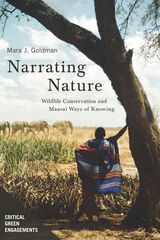 Narrating Nature: Wildlife Conservation and Maasai Ways of Knowing
Mara J. Goldman
University of Arizona Press, 2020 The current environmental crises demand that we revisit dominant approaches for understanding nature-society relations. Narrating Nature brings together various ways of knowing nature from differently situated Maasai and conservation practitioners and scientists into lively debate. It speaks to the growing movement within the academy and beyond on decolonizing knowledge about and relationships with nature, and debates within the social sciences on how to work across epistemologies and ontologies. It also speaks to a growing need within conservation studies to find ways to manage nature with people.
This book employs different storytelling practices, including a traditional Maasai oral meeting—the enkiguena—to decenter conventional scientific ways of communicating about, knowing, and managing nature. Author Mara J. Goldman draws on more than two decades of deep ethnographic and ecological engagements in the semi-arid rangelands of East Africa—in landscapes inhabited by pastoral and agropastoral Maasai people and heavily utilized by wildlife. These iconic landscapes have continuously been subjected to boundary drawing practices by outsiders, separating out places for people (villages) from places for nature (protected areas). Narrating Nature follows the resulting boundary crossings that regularly occur—of people, wildlife, and knowledge—to expose them not as transgressions but as opportunities to complicate the categories themselves and create ontological openings for knowing and being with nature otherwise.
Narrating Nature opens up dialogue that counters traditional conservation narratives by providing space for local Maasai inhabitants to share their ways of knowing and being with nature. It moves beyond standard community conservation narratives that see local people as beneficiaries or contributors to conservation, to demonstrate how they are essential knowledgeable members of the conservation landscape itself.
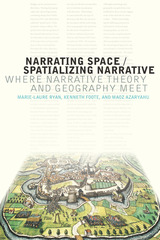 Narrating Space / Spatializing Narrative: Where Narrative Theory and Geography Meet
Marie-Laure Ryan, Kenneth Foote, and Maoz Azaryahu
Ohio State University Press, 2016 Narrating Space / Spatializing Narrative: Where Narrative Theory and Geography Meet by Marie-Laure Ryan, Kenneth Foote, and Maoz Azaryahu offers a groundbreaking approach to understanding how space works in narrative and narrative theory and how narratives work in real space. Thus far, space has traditionally been viewed by narratologists as a backdrop to plot. This study argues that space serves important but under-explored narrative roles: It can be a focus of attention, a bearer of symbolic meaning, an object of emotional investment, a means of strategic planning, a principle of organization, and a supporting medium.
Space intersects with narrative in two principal ways: ‘‘Narrating space’’ considers space as an object of representation, while ‘‘spatializing narrative’’ approaches space as the environment in which narrative is physically deployed. The inscription of narrative in real space is illustrated by such forms as technology-supported locative narratives, street names, and historical/heritage site and museum displays. While narratologists are best equipped to deal with the narration of space, geographers can make significant contributions to narratology by drawing attention to the spatialization of narrative. By bringing these two approaches together—and thereby building a bridge between narratology and geography—Narrating Space / Spatializing Narrative yields both a deepened understanding of human spatial experience and greater insight into narrative theory and poetic forms.
Narrating the Catastrophe: An Artist's Dialogue with Deleuze and Ricoeur
Jac Saorsa
Intellect Books, 2011 An extraordinary collaboration between contemporary art and critical discourse, Narrating the Catastrophe guides readers through unfamiliar textual landscapes where “being” is defined as an act rather than a form. Drawing on Paul Ricoeur’s notion of intersubjective narrative identity as well as the catastrophe theory of Gilles Deleuze, Jac Saorsa establishes an alternative perspective from which to interpret and engage with the world around us. A highly original—and visually appealing—take on a high-profile issue in contemporary critical debate, this book will appeal to all those interested in visual arts and philosophy.
 Narrating the City: Mediated Representations of Architecture, Urban Forms and Social Life
Edited by Aysegül Akçay Kavakoglu, Türkan Nihan Haciömeroglu, and Lisa Landrum
Intellect Books, 2020 An analysis of the ways film and media create topographies of cities, architecture, and metropolitan experiences.
Narrating the City examines how film and related visual media offer insights and commentary on the city as both a constructed object and a lived social experience. It brings together filmmakers, architects, digital artists, designers, and media journalists who critically read, reinterpret, and create narratives of the city. Analyzing a variety of international films and placing them in dialogue with video art, photographic narratives, and emerging digital image-based technologies, the authors explore the expanding range of “mediated” narratives of contemporary architecture and urban culture from both a media and a sociological standpoint.
The authors explore how moving-image narratives can create cinematic topographies, presenting familiar cities and modes of seeing in unfamiliar ways. The authors then turn to the new age of digital image making and consumption, revealing new techniques of representation, mediation, and augmentation of sensorial reality for city dwellers. The book’s emphasis on narrative also offers insights into critical societal issues including cultural identity, diversity, memory, and spatial politics, as they are both informed by and represented in various media.
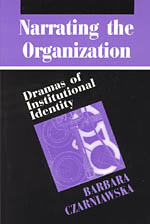 Narrating the Organization: Dramas of Institutional Identity
Barbara Czarniawska
University of Chicago Press, 1997 The most common social phenomenon of Western societies is the organization, yet those
involved in real-world managing are not always willing to reveal the intricacies of their
everyday muddles. Barbara Czarniawska argues that in order to understand these uncharted
territories, we need to gather local and concrete stories about organizational life and subject
them to abstract and metaphorical interpretation.
Using a narrative approach unique to organizational studies, Czarniawska employs literary
devices to uncover the hidden workings of organizations. She applies cultural metaphors to
public administration in Sweden to demonstrate, for example, how the dynamics of a
screenplay can illuminate the budget disputes of an organization. She shows how the
interpretive description of organizational worlds works as a distinct genre of social analysis,
and her investigations ultimately disclose the paradoxical nature of organizational life: we follow
routines in order to change, and decentralize in order to control. By confronting such
paradoxes, we bring crisis to existing institutions and enable them to change.
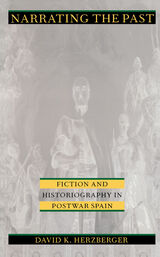 Narrating the Past: Fiction and Historiography in Postwar Spain
David K. Herzberger
Duke University Press, 1995 The relationship between fiction and historiography in Francoist Spain (1939–1975) is a contentious one. The intricacies of this relationship, in which fiction works to subvert the regime’s authority to write the past, are the focus of David K. Herzberger’s book.
The narrative and rhetorical strategies of historical discourse figure in both the fiction and historiography of postwar Spain. Herzberger analyzes these strategies, identifying the structures and vocabularies they use to frame the past and endow it with particular meanings. He shows how Francoist historians sought to affirm the historical necessity of Franco by linking the regime to a heroic and Christian past, while several types of postwar fiction—such as social realism, the novel of memory, and postmodern novels—created a voice of opposition to this practice. Focusing on the concept of writing history that these opposing strategies convey, Herzberger discloses the layering of truth and meaning that lies at the heart of postwar Spanish narrative from the early 1940s to the fall of Franco. His study clearly reveals how the novel in postwar Spain became a crucial form of dissent from the past as it was conceived and used by the State.
Making a decisive intervention in the debate about the ways in which narration determines both the meaning and truth of history and fiction, Narrating the Past will be of special interest to students and scholars of the politics, history, and literature of twentieth-century Spain.
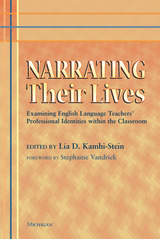 Narrating Their Lives: Examining English Language Teachers' Professional Identities within the Classroom
Edited by Lia Kamhi-Stein
University of Michigan Press, 2013 “…a groundbreaking book that will…engage, inform, and connect with present and future teachers and teacher educators.” ---Stephanie Vandrick, Foreword to Narrating Their Lives The field of TESOL has called attention to the ways that the issues of race and ethnicity, language status and power, and cultural background affect second language learners’ identities and, to some degree, those of teachers. In Narrating Their Lives, Kamhi-Stein examines the process of identity construction of classroom teachers so as to make connections between their personal and professional identities and their instructional practices. To do that, she has selected six autobiographical narratives from teachers who were once part of her TESL 570 (Educational Sociolinguistics) class in the MA TESOL program at California State University, Los Angeles. These six narratives cover a surprisingly wide range of identity issues but also touch on broader instructional themes that are part of teacher education programs. Because of the reflective nature of the narratives—with the teachers using their stories to better understand how their experiences shape what they do in the classroom—this volume includes provocative chapter-opening and reflective chapter-closing questions. An informative discussion of the autobiographical narrative assignment and the TESL 570 course (including supplemental course readings and assessment criteria) is also included.
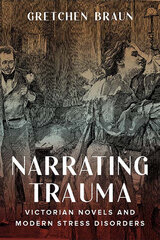 Narrating Trauma: Victorian Novels and Modern Stress Disorders
Gretchen Braun
Ohio State University Press, 2022 Neurasthenia, rail shock, hysteria. In Narrating Trauma, Gretchen Braun traces the nineteenth-century prehistory of those mental and physical responses that we now classify as post-traumatic stress and explores their influence on the Victorian novel. Engaging dialogues between both present-day and nineteenth-century mental science and literature, Braun examines novels that show the development of the mental dysfunction known as nervous disorder, positing that it was understood not as a failure of reason but instead as an organically based, crippling disjunction between the individual mind and its social context—with sufferers inhabiting spaces between sanity and madness. Spanning from the early Victorian period to the fin de siècle and encompassing realist, Gothic, sentimental, and sensation fiction, Narrating Trauma studies trauma across works of fiction by Charlotte Brontë, Emily Jolly, Wilkie Collins, George Eliot, Charles Dickens, and Thomas Hardy. In doing so, Braun brings both nineteenth-century science and current theories of trauma to bear on the narrative patterns that develop around mentally disordered women and men feminized by nervous disorder, creating a framework for novelistic critique of modern lifestyles, stressors, and institutions.
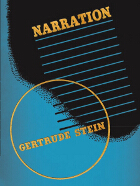 Narration: Four Lectures
Gertrude Stein
University of Chicago Press, 2010 Newly famous in the wake of the publication of her groundbreaking Autobiography of Alice B. Toklas, Gertrude Stein delivered her Narration lectures to packed audiences at the University of Chicago in 1935. Stein had not been back to her home country since departing for France in 1903, and her remarks reflect on the changes in American culture after thirty years abroad. In Stein’s trademark experimental prose, Narration reveals the legendary writer’s thoughts about the energy and mobility of the American people, the effect of modernism on literary form, the nature of history and its recording, and the inventiveness of the English language—in particular, its American variant. Stein also discusses her ambivalence toward her own literary fame as well as the destabilizing effect that notoriety had on her daily life. Restored to print for a new generation of readers to discover, these vital lectures will delight students and scholars of modernism and twentieth-century literature. “Narration is a treasure waiting to be rediscovered and to be pirated by jolly marauders of sparkling texts.”—Catharine Stimpson, NYU
 Narration in the Fiction Film
David Bordwell
University of Wisconsin Press, 1985 Most films tell tales, but what does that involve? How do motion pictures tease us into building what we all agree to call stories? In this study, David Bordwell offers the first comprehensive account of how movies use fundamental principles of narrative representation, unique features of the film medium, and diverse story-telling patterns to construct their fictional narratives. The result is a pioneering, far-reaching work which will change the way we perceive narrative film—and which every serious film scholar, student or fan will welcome.
“This book is of crucial importance to film specialists. I cannot think that any film teacher/scholar would miss reading this work.”—Don Fredricksen, Cornell University
“David Bordwell’s Narration in the Fiction Film is a major contribution to film studies and to narrative theory. The work, I predict, will be widely read, praised, debated, and damned. Brodwell’s originality lies not so much in demonstrating the deficiencies of other theories, which he does very convincingly, but in the scope and design of his project, against which there is no competition of comparable intellectual weight.”—Jerry Carlson, DePaul University
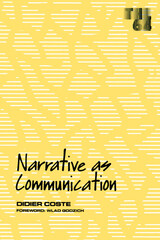 Narrative As Communication
Didier Coste
University of Minnesota Press, 1989 Narrative as Communication is the first major treatise on narrative and narrative theory to make use of all the analytic tools developed in the twenty years. Intended as an up-to-date introduction, it carefully defines narrative discourse, distinguishing it from other discourses, and analyzes what it entails by referring to numerous examples spanning a wide range of media and literary works. At the same time, it orients narrative theory in the current debates surrounding the “New Historicism” and postmodern ideology, showing that theories of narrative are necessarily central to any understanding of history. Not restricted to any single genre, Coste’s text emphasizes the production of narrative meaning in diverse contexts: The Epic of Gilgamesh, a John Ford film classic, French American, and Spanish new fiction, Dante, Shakespeare, the pastoral, the fairy tale, The Communist Manifesto, Prescott’s History of the Conquest of Peru, a painting by Gustave Moreau. Coste thoroughly and critically examines the usual concepts of voice, character, point of view and narrative syntax, and he develops radical revisions in the notion of fictionality, character, narrative economy and the function of narrative meaning itself. The book is a remarkable synthesis that will likely become a reference for future studies in narratology.
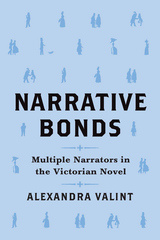 Narrative Bonds: Multiple Narrators in the Victorian Novel
Alexandra Valint
Ohio State University Press, 2021 While narrative fracturing, multiplicity, and experimentalism are commonly associated with modernist and postmodern texts, they have largely been understudied in Victorian literature. Narrative Bonds: Multiple Narrators in the Victorian Novel focuses on the centrality of these elements and address the proliferation of multiple narrators in Victorian novels. In Narrative Bonds, Alexandra Valint explores the ways in which the Victorian multi-narrator form moves toward the unity of vision across characters and provides inclusivity in an era of expanding democratic rights and a growing middle class. Integrating narrative theory, gothic theory, and disability studies with analyses of works by Charles Dickens, Robert Louis Stevenson, Wilkie Collins, Emily Brontë, and Bram Stoker, this comprehensive and illuminating study illustrates the significance and impact of the multi-narrator structure in Victorian novels.
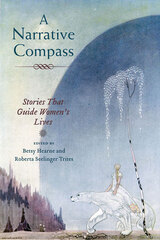 A Narrative Compass: Stories that Guide Women's Lives
Edited by Betsy Hearne and Roberta Seelinger Trites
University of Illinois Press, 2008 Each of us has a narrative compass, a story that has guided our lifework. In this extraordinary collection, women scholars from a variety of disciplines identify and examine the stories that have inspired them, haunted them, and shaped their research, from Little House on the Prairie to Little Women, from the fairy tales of Hans Christian Andersen and Alice's Adventures in Wonderland to Nancy Drew, Mary Jane, and even the Chinese memoir Jottings from the Transcendant's Abode at Mt. Youtai. Telling the "story of her story" leads each of the essayists to insights about her own approach to studying narratives and to a deeper, often surprising, understanding of the power of imagination. Contributors are Deyonne Bryant, Minjie Chen, Cindy L. Christiansen, Beverly Lyon Clark, Karen Coats, Wendy Doniger, Bonnie Glass-Coffin, Betsy Hearne, Joanna Hearne, Ann Hendricks, Rania Huntington, Christine Jenkins, Kimberly Lau, Pamela Riney-Kehrberg, Maria Tatar, Ebony Elizabeth Thomas, Roberta Seelinger Trites, Claudia Quintero Ulloa, and Ofelia Zepeda.
Narrative Concepts in the Study of Eighteenth-Century Literature
Edited by Liisa Steinby and Aino Mäkikalli
Amsterdam University Press, 2017 This collection of essays studies the encounter between allegedly ahistorical concepts of narrative and eighteenth-century literature from across Europe. At issue is the question of whether the theoretical concepts underpinning narratology are, despite their appearance of ahistorical generality, actually derived from the historical study of a particular period and type of literature. The essays take on aspects of eighteenth-century texts such as plot, genre, character, perspective, temporality, and more, coming at them from both a narratological and a historical perspective.
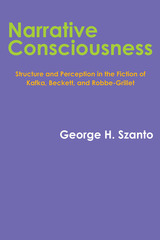 Narrative Consciousness: Structure and Perception in the Fiction of Kafka, Beckett, and Robbe-Grillet
By George H. Szanto
University of Texas Press, 1972 Comparatively little critical attention has been devoted to narrative technique in modern fiction, and formal analysis of the work of Kafka, Beckett, and Robbe-Grillet in particular has for the most part been limited to short studies in journals, many of these in languages other than English. The criticism written in English has dealt primarily with theme with metaphysics and myth and ignored structure and style. Yet it is structure and style that offer the reader a way into the often bewildering and disturbing fictional worlds these three writers present. The problem confronting writers since the middle of the nineteenth century has been how to cope artistically with an increasingly alienating and mechanized world. As George Szanto sees it, Kafka, Beckett and Robbe-Grillet conclude, by the example of their fictions, that the writer's province is no longer this impossible environment. Instead, the writer must work within the only knowledge available to any one person: the knowledge attained through perceptions. The proper study for a storyteller is thus the search for the unique details, the describable perceptions a person chooses from the outside world and brings into their mind, which in the end define their nature. The shape of the story is determined by the narrating consciousness, that single character through whose awareness the details are filtered. Thus, in a very special sense, the tale and the telling are one. Szanto's meticulous and thoughtful study of the major fiction of Kafka, Beckett, and Robbe-Grillet searches out these details and examines the manner in which each author, through the minds of his characters, has selected and ordered them. His structural approach not only leads the reader directly into the works under scrutiny, but also provides an understanding of the workings of the art itself. In the appendices, the author surveys the different ways in which criticism has treated these three writers. His extensive bibliography provides a valuable research tool.
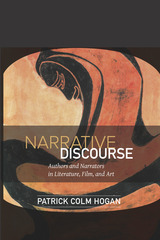 Narrative Discourse: Authors and Narrators in Literature, Film, and Art
Patrick Colm Hogan
Ohio State University Press, 2013 In Narrative Discourse: Authors and Narrators in Literature, Film, and Art, Patrick Colm Hogan reconsiders fundamental issues of authorship and narration in light of recent research in cognitive and affective science. He begins with a detailed overview of the components of narrative discourse, both introducing and reworking key principles. Based on recent studies treating the complexity of human cognition, Hogan presents a new account of implied authorship that solves some notorious problems with that concept. In subsequent chapters Hogan takes the view that implied authorship is both less unified and more unified than is widely recognized. In connection with this notion, he examines how we can make interpretive sense of the inconsistencies of implied authors within works and the continuities of implied authors across works. Turning to narrators, he considers some general principles of readers’ judgments about reliability, emphasizing the emotional element of trust. Following chapters take up the operation of complex forms of narration, including parallel narration, embedded narration, and collective voicing (“we” narration). In the afterword, Hogan sketches some subtleties at the other end of narrative communication, considering implied readers and narratees. In order to give greater scope to the analyses, Hogan develops case studies from painting and film as well as literature, treating art by Rabindranath Tagore; films by David Lynch, Bimal Roy, and Kabir Khan; and literary works by Mirabai, Harriet Beecher Stowe, Ernest Hemingway, William Faulkner, Margaret Atwood, Ngugi wa Thiong’o, and Joseph Diescho.
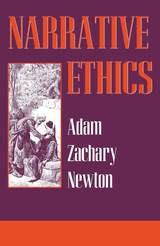 Narrative Ethics
Adam Newton
Harvard University Press, 1995 The ethics of literature, formalists have insisted, resides in the moral quality of a character, a story, perhaps the relation between author and reader. But in the wake of deconstruction and various forms of criticism focusing on difference, the ethical question has been freshly negotiated by literary studies, and to this approach Adam Newton brings a startling new thrust. His book makes a compelling case for understanding narrative as ethics. Assuming an intrinsic and necessary connection between the two, Newton explores the ethical consequences of telling stories and fictionalizing character, and the reciprocal claims binding teller, listener, witness, and reader in the process. He treats these relations as defining properties of prose fiction, of particular import in nineteenth- and twentieth-century texts.
Newton's fresh and nuanced readings cover a wide range of authors and periods, from Charles Dickens to Kazuo Ishiguro and Julian Barnes, from Herman Melville to Richard Wright, from Joseph Conrad and Henry James to Sherwood Anderson and Stephen Crane. An original work of theory as well as a deft critical performance, Narrative Ethics also stakes a claim for itself as moral inquiry. To that end, Newton braids together the ethical-philosophical projects of Emmanuel Levinas, Stanley Cavell, and Mikhail Bakhtin as a kind of chorus for his textual analyses--an elegant bridge between philosophy's ear and literary criticism's voice. His work will generate enormous interest among scholars and students of English and American literature, as well as specialists in narrative and literary theory, hermeneutics, and contemporary philosophy.
 Narrative Experiments: The Discursive Authority of Science and Technology
Gayle L. Ormiston and Raphael Sassower
University of Minnesota Press, 1989 Narrative Experiments was first published in 1989. Minnesota Archive Editions uses digital technology to make long-unavailable books once again accessible, and are published unaltered from the original University of Minnesota Press editions. In Narrative Experiments, Gayle Ormiston and Ralph Sassower bring a refreshing perspective to the domains of inquiry we call "science" and "technology," asserting that traditional definitions (like classical idealism and materialism) fail to suggest the rich and complex cultural/linguistic interplay occurring between them. This context is not merely a background, nor is Ormiston and Sassower's just one more interdisciplinary approach to the subject. Instead, their book argues, science, technology, and the humanities developed in concert with one another, and their reciprocity obliterates all traditional disciplinary boundaries. Ormiston and Sassower build their case by devoting a chapter to each of the four themes emerging from the etymological introduction. First, they look at the role fiction and other literary modes play in developing our attitudes toward science and technology -- how the visions of Bacon, Hobbes, Galileo, Rousseau, Mary Shelley, and Orwell evoke both anxiety and hope. Next, they examine a series of eighteenth-century "fictions" -- the Enlightenment texts of Kant, Rousseau, and Hume -- and the elevated (but ambiguous) status science and technology associated with them. The last two chapters evaluate modes of discursive authority and its dissemination -- classical and modern extralinguistic approaches; the contemporary-linguistic view espoused by Rorty, Quine, and others; and their own avowedly experimental journey through the labyrinths of cultural and linguistic usage.
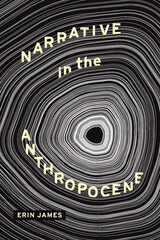 Narrative in the Anthropocene
Erin James
Ohio State University Press, 2022 In Narrative in the Anthropocene, Erin James poses two complementary questions: What can narrative teach us about our current geological epoch, defined and marked by the irrevocable activity of humans on the Earth’s geology and ecosystems? and What can our current geological epoch teach us about narrative? Drawing from a wide range of sources—including Jane Austen’s Mansfield Park, Maria Popova’s collective biography Figuring, Richard McGuire’s graphic novel Here, Indigenous and Afrofuturist speculative fiction, and more—James argues that a richer understanding of the forms and functions of narrative in the Anthropocene provides us with invaluable insight into how stories shape our world. At the same time, she contends that the Anthropocene alters the very nature of narrative. Throughout her exploration of these themes, James lays the groundwork for an “Anthropocene narrative theory,” introducing new modes of reading narrative in the Anthropocene; new categories of narrative time, space, narration, and narrativity; and a new definition of narrative itself as a cognitive and rhetorical tool for purposeful worldbuilding.
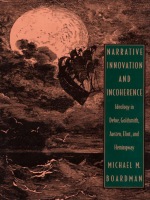 Narrative Innovation and Incoherence: Ideology in Defoe, Goldsmith, Austen, Eliot, and Hemingway
Michael M. Boardman
Duke University Press, 1992 When the impulse toward innovation arises late in a writer's career, it is often accompanied by a sense of urgency, and the result, as Narrative Innovation and Incoherence demonstrates, raises important questions for literary theory. Michael M. Boardman considers this pressing struggle to find a new form as it appears in the later works of Defoe, Goldsmith, Austen, Eliot, and Hemingway. He analyzes how these authors react to new and compelling beliefs for which a previous way of writing is no longer adequate.
Urgent innovations, in this account, can only be understood as unique, individual responses to crises in belief. Taking as a point of departure French theorist Althusser's conviction that ideology is intelligible only through structure, Boardman searches for an explanation of both form and ideology not in Marxist concepts of base and superstructure but in the particular structure of an individual artist's writing career. Narrative ideology here becomes more complex than is generally assumed.
Theoretically informed yet avoiding essentializing explanations of narrative invention, Narrative Innovation and Incoherence offers unexpected insights into the multifaceted relations between form and belief. It will encourage serious students of the novel to reexamine the importance of poetics as a mediating factor in the means of production.
 Narrative Interplay in the Digital Era: Generative AI, Alternate Reality Games, and the Future of Interactive Pedagogy
Edited by Andrew Klobucar
Intellect Books, 2025 How AI, games, and interactive fiction are transforming storytelling, learning, and play.
In Narrative Interplay in the Digital Era, leading scholars and artists explore how digital narratives, alternate reality games, and AI-driven storytelling reshape how we create, experience, and teach interactive fiction. This collection moves beyond traditional analysis and examines the social and artistic dimensions of interactivity, highlighting how narratives unfold dynamically through player engagement and machine collaboration.
Organized into three sections—alternate realities, digital interactive fiction, and the politics of gaming—this book reveals the evolving role of play and interactivity in contemporary education, creative expression, and online culture. Contributors offer insights from inside the creative process, centering the perspectives of game designers and artists to shed light on how interactive stories emerge at the intersection of technology and human imagination.
A practical resource for researchers in game studies, electronic literature, and digital storytelling, this collection also speaks to educators and creators eager to explore how AI and interactivity are redefining the future of narrative.
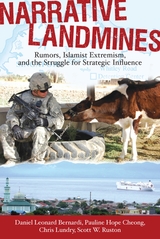 Narrative Landmines: Rumors, Islamist Extremism, and the Struggle for Strategic Influence
Bernardi, Daniel Leonard
Rutgers University Press, 2012 Islamic extremism is the dominant security concern of many contemporary governments, spanning the industrialized West to the developing world. Narrative Landmines explores how rumors fit into and extend narrative systems and ideologies, particularly in the context of terrorism, counter-terrorism, and extremist insurgencies. Its concern is to foster a more sophisticated understanding of how oral and digital cultures work alongside economic, diplomatic, and cultural factors that influence the struggles between states and non-state actors in the proverbial battle of hearts and minds. Beyond face-to-face communication, the authors also address the role of new and social media in the creation and spread of rumors. As narrative forms, rumors are suitable to a wide range of political expression, from citizens, insurgents, and governments alike, and in places as distinct as Singapore, Iraq, and Indonesia—the case studies presented for analysis. The authors make a compelling argument for understanding rumors in these contexts as “narrative IEDs,” low-cost, low-tech weapons that can successfully counter such elaborate and expansive government initiatives as outreach campaigns or strategic communication efforts. While not exactly the same as the advanced technological systems or Improvised Explosive Devices to which they are metaphorically related, narrative IEDs nevertheless operate as weapons that can aid the extremist cause.
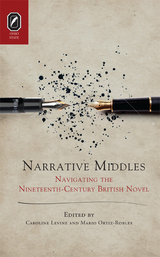 Narrative Middles: Navigating the Nineteenth-Century Novel
Edited by Caroline Levine and Mario Ortiz-Robles
Ohio State University Press, 2011 Narrative theorists have lavished attention on beginnings and endings, but they have too often neglected the middle of narratives. In this groundbreaking collection of essays, Narrative Middles: Navigating the Nineteenth-Century British Novel, nine literary scholars offer innovative approaches to the study of the underrepresented middle of the vast, bulky nineteenth-century multiplot novel. Combining rigorous formal analysis with established sociohistorical methods, these essays seek to account for the various ways in which the novel gave shape to British culture’s powerful obsession with middles. The capacious middle of the nineteenth-century novel provides ample room for intricately woven plots and the development of complex character systems, but it also becomes a medium for capturing, consecrating, and cultivating the middle class and its middling, middlebrow tastes as well as its mediating global role in empire. Narrative Middles explores these fascinating conjunctions in new readings of novels by Jane Austen, William Makepeace Thackeray, Anne Brontë, George Eliot, Charles Dickens, Wilkie Collins, Henry James, and William Morris. Contributors: Amanda Claybaugh, Suzanne Daly, Amanpal Garcha, Amy King, Caroline Levine, Mario Ortiz-Robles, Kent Puckett, Hilary Schor, and Alex Woloch.
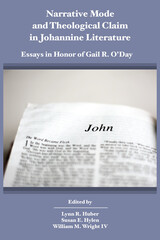 Narrative Mode and Theological Claim in Johannine Literature: Essays in Honor of Gail R. O’Day
Lynn R. Huber
SBL Press, 2021 Exegesis that bears fruit both for the academy and the church
In this collection of essays and sermons on the Gospel of John and Revelation, friends, colleagues, and former students of Gail R. O’Day explore and extend the possibilities raised by her work in her groundbreaking study Revelation in the Fourth Gospel. The essays engage with both historical contextualization and literary analysis to identify the rhetorical features that ancient readers might have apprehended, while the sermons explore how the literary shape of the text can inform preaching through attention to the narrative modes of the text. Contributions from Yoshimi Azuma, Teresa Fry Brown, Patrick Gray, Lynn R. Huber, Susan E. Hylen, Karoline M. Lewis, Thomas G. Long, Veronice Miles, Vernon K. Robbins, Gilberto A. Ruiz, Ted A. Smith, and William M. Wright IV thematize the importance of narrative approaches and the diverse ways they can be employed.
Narrative Mourning: Death and Its Relics in the Eighteenth-Century British Novel
Kathleen M. Oliver
Bucknell University Press, 2020 Narrative Mourning explores death and its relics as they appear within the confines of the eighteenth-century British novel. It argues that the cultural disappearance of the dead/dying body and the introduction of consciousness as humanity’s newfound soul found expression in fictional representations of the relic (object) or relict (person). In the six novels examined in this monograph—Samuel Richardson's Clarissa and Sir Charles Grandison; Sarah Fielding's David Simple and Volume the Last; Henry Mackenzie's The Man of Feeling; and Ann Radcliffe's The Mysteries of Udolpho—the appearance of the relic/relict signals narrative mourning and expresses (often obliquely) changing cultural attitudes toward the dead.
Published by Bucknell University Press. Distributed worldwide by Rutgers University Press.
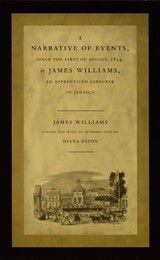 A Narrative of Events, since the First of August, 1834, by James Williams, an Apprenticed Labourer in Jamaica
James Williams
Duke University Press, 2001 This book brings back into print, for the first time since the 1830s, a text that was central to the transatlantic campaign to fully abolish slavery in Britain’s colonies. James Williams, an eighteen-year-old Jamaican “apprentice” (former slave), came to Britain in 1837 at the instigation of the abolitionist Joseph Sturge. The Narrative he produced there, one of very few autobiographical texts by Caribbean slaves or former slaves, became one of the most powerful abolitionist tools for effecting the immediate end to the system of apprenticeship that had replaced slavery.
Describing the hard working conditions on plantations and the harsh treatment of apprentices unjustly incarcerated, Williams argues that apprenticeship actually worsened the conditions of Jamaican ex-slaves: former owners, no longer legally permitted to directly punish their workers, used the Jamaican legal system as a punitive lever against them. Williams’s story documents the collaboration of local magistrates in this practice, wherein apprentices were routinely jailed and beaten for both real and imaginary infractions of the apprenticeship regulations.
In addition to the complete text of Williams’s original Narrative, this fully annotated edition includes nineteenth-century responses to the controversy from the British and Jamaican press, as well as extensive testimony from the Commission of Enquiry that heard evidence regarding the Narrative’s claims. These fascinating and revealing documents constitute the largest extant body of direct testimony by Caribbean slaves or apprentices.
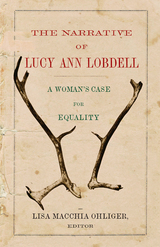 The Narrative of Lucy Ann Lobdell: A Woman's Case for Equality
Lisa Macchia Ohliger
Westholme Publishing, 2024 A Primary Text in the History of Gender in America
Lucy Ann Lobdell’s (1829–1912) extraordinary life was shaped by personal strife and the hardships of survival in upstate New York. Struggling with an abusive, alcoholic husband, a young child, ailing parents, and financial strain, Lucy did what was necessary to support her family. In a rural world defined by hunting, farming, and lumbering, she dressed, labored, and lived in a traditional masculine manner. Her prowess as a rifle shot and fiddle player were known locally, but because of her unconventional, androgynous lifestyle, she became a target of public gossip and ridicule. Educated and eloquent, Lucy penned and published, Lucy Ann Lobdell, the Female Hunter of Delaware and Sullivan Counties, N.Y., in 1855. The narrative provides a unique look at the persecution of a woman whose only “offense” was disregard for contemporary societal norms.
After her husband was killed during the Civil War, she received a widow’s pension. Ostracized and eventually hospitalized in 1880—gender laws of the time imprisoned indigent men, but sent women to mental hospitals—she underwent torturous experimental treatment until she confessed to a self-serving doctor that she was “a man in all that the name implies.” Whether Lucy was a lesbian, cross dresser, or transgender, we don’t know from the historical record, but as Lisa Macchia Ohliger demonstrates in The Narrative of Lucy Ann Lobdell: A Woman’s Case for Equality, Lucy did embody the nascent women’s rights movement. At the same time, and not far from where Lucy lived and went to school, Amelia Bloomer was advocating the right for women to wear pants and was publishing the feminist newspaper, The Lily, while Susan B. Anthony was pushing for land rights and equal pay for women. All of these issues are found in Lucy’s autobiographical account, fully reproduced in this volume. Lucy’s life is an illustration of the historical significance and destructive power of gender in society, and her narrative bears painful witness to the clash between taboo and survival.
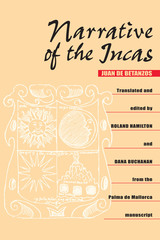 Narrative of the Incas
By Juan de Betanzos
University of Texas Press, 1996 One of the earliest chronicles of the Inca empire was written in the 1550s by Juan de Betanzos. Although scholars have long known of this work, only eighteen chapters were actually available until the 1980s when the remaining sixty-four chapters were discovered in the collection of the Fundación Bartolomé March in Palma de Mallorca, Spain. Narrative of the Incas presents the first complete English translation of the original manuscript of this key document. Although written by a Spaniard, it presents an authentic Inca worldview, drawn from the personal experiences and oral traditions told to Betanzos by his Inca wife, Doña Angelina, and other members of her aristocratic family who lived during the reigns of the last Inca rulers, Huayna Capac Huascar and Atahualpa. Betanzos wrote a history of the Inca empire that focuses on the major rulers and the contributions each one made to the growth of the empire and of Inca culture. Filled with new insights into Inca politics, marriage, laws, the calendar, warfare, and other matters, Narrative of the Incas is essential reading for everyone interested in this ancient civilization.
A Narrative of the Life of David Crockett of the State of Tennessee
David Crockett
University of Tennessee Press, 1987 Davy Crockett has long been revered as an American folk hero. In this facsimile edition of his original 1834 autobiography, Crockett gives readers "a plain, honest, homespun account of my state in life," while editors James Shackford and Stanley Folsmbee author a critical introduction that traces his influence on American cultural memory and tracks his place among folk heroes of the ages.
Narrative of the Life of Frederick Douglass: An American Slave, Written by Himself
Frederick Douglass
Harvard University Press, 2009 No book more vividly explains the horror of American slavery and the emotional impetus behind the antislavery movement than Frederick Douglass’s Narrative. In an introductory essay, Robert B. Stepto reexamines the extraordinary life and achievement of a man who escaped from slavery to become a leading abolitionist and one of our most important writers. The John Harvard Library text reproduces the first edition, published in Boston in 1845.
Narrative of the Life of the Brown Boy and the White Man
Ronaldo Wilson
University of Pittsburgh Press, 2008 WINNER OF THE 2007 CAVE CANEM POETRY PRIZE
Selected by Claudia Rankine
Prose poems that profile the interrelationship of the two central characters, looking deeply into their psyches and thoughts of race, class, and identity.
Narrative of the Persecutions of Agnes Beaumont
Vera J. Camden
Michigan State University Press, 2002 This is a critical edition, based on the Agnes Beaumont manuscripts in the British Library: Beaumont's homely account of the persecutions she endured from her father and suitor because of riding horseback behind the great preacher to a meeting is here presented in its original form. She rejects the traditional doctrine of women's subordination.
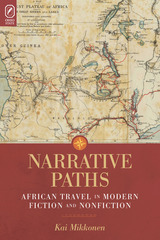 Narrative Paths: African Travel in Modern Fiction and Nonfiction
Kai Mikkonen
Ohio State University Press, 2015 In Narrative Paths: African Travel in Modern Fiction and Nonfiction, Kai Mikkonen argues that early twentieth-century European travel writing, journal keeping, and fiction converged and mutually influenced each other in ways that inform current debates about the fiction–nonfiction distinction. Turning to narratives set in sub-Saharan Africa, Mikkonen identifies five main dimensions of interplay between fiction and nonfiction: the experiential frame of the journey, the redefinition of the language and objective of description, the shared cultural givens and colonial notions concerning sub-Saharan Africa, the theme of narrativisation, and the issue of virtual genres. Narrative Paths reveals the important role that travel played as a frame in these modernist fictions as well as the crucial ways that nonfiction travel narratives appropriated fictional strategies.
Narrative Paths contributes to debates in narratology and rhetorical narrative theory about the fiction–nonfiction distinction. With chapters on a wide range of modernist authors—from Pierre Loti, André Gide, Michel Leiris, and Georges Simenon to Blaise Cendrars, Louis-Ferdinand Céline, Joseph Conrad, Graham Greene, Evelyn Waugh, and Isak Dinesen (Karen Blixen)—Mikkonen’s study also contributes to postcolonial approaches to these authors, examining issues of representation, narrative voice, and authority in narratives about colonial Africa.
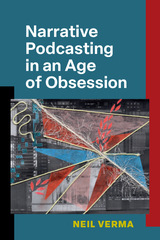 Narrative Podcasting in an Age of Obsession
Neil Verma
University of Michigan Press, 2024 It has been a decade since Serial brought the narrative podcast to the center of popular culture. In that time, there has been an enormous boom in the production of podcasts that tell stories, particularly in the fields of true crime, storytelling, history, and narrative fiction. Now that the initial glow around the medium has begun to fade, it is time to reevaluate the medium’s technological, political, economic, and cultural rise, in particular what types of storytelling accompanied that rise.
Narrative Podcasting in an Age of Obsession is the first book to look back on this prodigious body of material and attempt to make sense of it from a structural, historical, and analytic point of view. Focusing on more than 350 podcasts and other audio works released between Serial and the COVID pandemic, the book explores why so many of these podcasts seem “obsessed with obsession,” why they focus not only on informing listeners but also dramatizing the labor that goes into it, and why fiction podcasts work so hard to prove they are a brand new form, even as they revive features of radio from decades gone by. This work also examines the industry's reckoning with its own implication in systemic racism, misogyny, and other forms of discrimination. Employing innovative new critical techniques for close listening—including pitch tracking software and spectrograms—Narrative Podcasting in an Age of Obsession makes a major contribution to podcast studies and media studies more broadly.
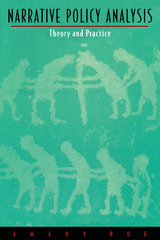 Narrative Policy Analysis: Theory and Practice
Emery Roe
Duke University Press, 1994 Narrative Policy Analysis presents a powerful and original application of contemporary literary theory and policy analysis to many of today’s most urgent public policy issues. Emery Roe demonstrates across a wide array of case studies that structuralist and poststructuralist theories of narrative are exceptionally useful in evaluating difficult policy problems, understanding their implications, and in making effective policy recommendations.
Assuming no prior knowledge of literary theory, Roe introduces the theoretical concepts and terminology from literary analysis through an examination of the budget crises of national governments. With a focus on several particularly intractable issues in the areas of the environment, science, and technology, he then develops the methodology of narrative policy analysis by showing how conflicting policy "stories" often tell a more policy-relevant meta-narrative. He shows the advantage of this approach to reading and analyzing stories by examining the ways in which the views of participants unfold and are told in representative case studies involving the California Medfly crisis, toxic irrigation in the San Joaquin Valley, global warming, animal rights, the controversy over the burial remains of Native Americans, and Third World development strategies.
Presenting a bold innovation in the interdisciplinary methodology of the policy sciences, Narrative Policy Analysis brings the social sciences and humanities together to better address real-world problems of public policy—particularly those issues characterized by extreme uncertainty, complexity, and polarization—which, if not more effectively managed now, will plague us well into the next century.
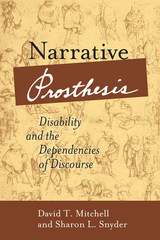 Narrative Prosthesis: Disability and the Dependencies of Discourse
David T. Mitchell and Sharon L. Snyder
University of Michigan Press, 2001 Narrative Prosthesis: Disability and the Dependencies of Discourse develops a narrative theory of the pervasive use of disability as a device of characterization in literature and film. It argues that, while other marginalized identities have suffered cultural exclusion due to a dearth of images reflecting their experience, the marginality of disabled people has occurred in the midst of the perpetual circulation of images of disability in print and visual media. The manuscript's six chapters offer comparative readings of key texts in the history of disability representation, including the tin soldier and lame Oedipus, Montaigne's "infinities of forms" and Nietzsche's "higher men," the performance history of Shakespeare's Richard III, Melville's Captain Ahab, the small town grotesques of Sherwood Anderson's Winesburg, Ohio and Katherine Dunn's self-induced freaks in Geek Love.
David T. Mitchell is Associate Professor of Literature and Cultural Studies, Northern Michigan University. Sharon L. Snyder is Assistant Professor of Film and Literature, Northern Michigan University.
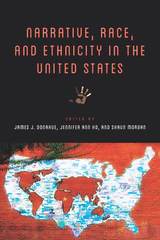 Narrative, Race, and Ethnicity in the United States
Edited by James J. Donahue, Jennifer Ann Ho, and Shaun Morgan
Ohio State University Press, 2017 Narrative, Race, and Ethnicity in the United States, edited by James J. Donahue, Jennifer Ho, and Shaun Morgan, is the first book-length volume of essays devoted to studying the intersection of race/ethnicity and narrative theories. Each chapter offers a sustained engagement with narrative theory and critical race theory as applied to ethnic American literature, exploring the interpretive possibilities of this critical intersection. Taken as a whole, these chapters demonstrate some of the many ways that the formal study of narrative can help us better understand the racial/ethnic tensions of narrative fictions. Similarly, the essays advance the tools of narrative theory by redeploying or redesigning those tools to better account for and articulate the ways that race and ethnicity are formal components of narrative as well as thematic issues.
Recognizing that racial/ethnic issues and tensions are often contextualized geographically, this volume focuses on narratives associated with various racial and ethnic communities in the United States. By engaging with new developments in narrative theory and critical race studies, this volume demonstrates the vitality of using the tools of narratology and critical race theory together to understand how race influences narrative and how narratology illuminates a reading of race in ethnic American literature.
The Narrative Secret of Flannery O'Connor: The Trickster as Interpreter
Ruthann Knechel Johansen
University of Alabama Press, 2009 O’Connor’s endeavor to write engaging narratives,at the same time open up to the divine in the everyday world
“The ‘narrative secret’ of Johansen’s title refers to the strategies that she sees O’Connor using in her effort to communicate a spiritual message to a doubting audience. O’Connor knew from the beginning of her career that writing about the thing that mattered most to her—a person’s relationship in faith with Jesus—and being taken seriously as a writer meant [choosing] a dramatic and difficult way to get her vision across: to write stories that work first and foremost as engaging narratives and at the same time open up to the divine in the everyday world.
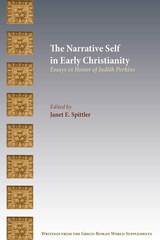 The Narrative Self in Early Christianity: Essays in Honor of Judith Perkins
Janet E. Spittler
SBL Press, 2019 Essays that explore early Christian texts and the broader world in which they were written
This volume of twelve essays celebrates the contributions of classicist Judith Perkins to the study of early Christianity. Drawing on Perkins's insights related to apocryphal texts, representations of pain and suffering, and the creation of meaning, contributors explore the function of Christian narratives that depict pain and suffering, the motivations of the early Christians who composed these stories, and their continuing value to contemporary people. Contributors also examine how narratives work to create meaning in a religious context. These contributions address these issues from a variety of angles through a wide range of texts.
Features:
- Introductions to and treatments of several largely unknown early Christian texts
- Essays by ten women and two men influenced or mentored by Judith Perkins
- Essays on the Deuterocanon, the New Testament, and early Christian relics
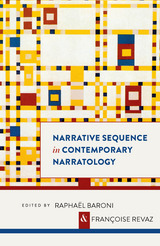 Narrative Sequence in Contemporary Narratology
Edited by Raphaël Baroni and Françoise Revaz
Ohio State University Press, 2016 Since Aristotle, there has been an assumption that narrative is a representation of actions or sequences of events, that this representation aims to elicit emotions, and that well-formed narratives constitute a whole, with a beginning, a middle, and an end. The nature, role, and relative importance of constituent notions like “sequence of events” and “plot” have been discussed repeatedly and, as a result, have become rather slippery. While recent developments in contemporary narrative theory, such as unnatural, transmedial, cognitive, and functionalist narratology, shed new light on these notions, Narrative Sequence in Contemporary Narratology goes beyond specific approaches to narrative, illuminating sequence and plot in all the diversity of their manifestations, forms, and functions.
This volume, edited by Raphaël Baroni and Françoise Revaz, includes contributions from some of the most influential scholars in narrative studies: Alain Boillat, Peter Hühn, Emma Kafalenos, Franco Passalacqua, James Phelan, Federico Pianzola, John Pier, Gerald Prince, Brian Richardson, Marie-Laure Ryan, Eyal Segal, and Michael Toolan. Essays range in focus from musical narrativity and rhetorical narrative theory to comic strips and re-examinations of classical and postclassical narratology. All of the essays contribute fresh understandings of foundational concepts in the field of narratology.
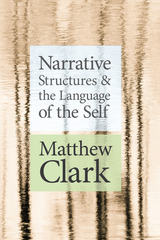 Narrative Structures and the Language of the Self
Matthew Clark
Ohio State University Press, 2010 Narrative Structures and the Language of the Self by Matthew Clark offers a new way of thinking about the interrelation of character and plot. Clark investigates the characters brought together in a narrative, considering them not as random collections but as structured sets that correspond to various manifestations of the self. The shape and structure of these sets can be thought of as narrative geometry, and various geometries imply various theories of the self. Part One, “Philosophical Fables of the Self,” examines narratives such as The Talented Mr. Ripley,A Farewell to Arms,A Separate Peace, and The Master of Ballantrae in order to show successively more complex versions of the self as modeled by Descartes, Hegel, Freud, and Mead. Part Two, “The Case of the Subject,” uses Case Grammar to extend the discussion to additional roles of the self in narratives such as The Waves,The Great Gatsby,Fifth Business, and Howards End as examples of the self as experiencer, the self as observer, the instrumental self, and the locative self. The book ends with an extended analysis of the subject in Hartley’s The Go-Between. Throughout, the discussion is concerned with practical analysis of specific narratives and with the development of an understanding of the self that moves beyond the simple dichotomy of the self and the other, the subject and the object.
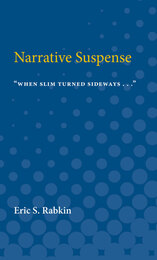 Narrative suspense
Eric S. Rabkin
University of Michigan Press, 1973 "When Slim Turned Sideways . . ."—this is narrative suspense, and if well done propels the reader on into and through a novel, or folktale, or printed play, or epic poem. How does it work? Is it a matter of plot only? Why do some works rivet our attention from the first page, while others obviously do not?These are among the deceptively simple questions taken up in Eric Rabkin's seminal study of narrative suspense. Using the insights afforded by structuralism, linguistics, and modern criticism—and basing his discussion on close readings of many well-known works—Rabkin provides at once an original work in literary theory and a remarkably practical account of how successful narrative establishes and sustains interest on several levels.Suspense, Rabkin shows, is involved not only in the plot of a narrative, but in its thematic development, character development, and style as well. This broad understanding enables the author to develop a coherent theoretical description of suspense, using the terminology of rhetoric. The most startling result of this approach is a schematic representation for literary genres that, though arrived at theoretically, corresponds almost exactly to our intuitive categorization of literary works.Narrative Suspense can be read with ample profit by interested layman and professional critic alike. With wit and intelligence, the book clarifies an oft-perceived phenomenon—the fundamental importance of suspense, broadly defined, in all great works of literature.
Narrative Theory and the Cognitive Sciences
Edited by David Herman
CSLI, 2003 Research on human intelligence has postulated that studying the structure and use of stories can provide important insight into the roots of self and the nature of thinking. In that spirit, this volume focuses on narrative as a crossroads where cognitive and social psychology, linguistics, literary theory, and the recent hybrid called "cognitive narratology" intersect, suggesting new directions for the cognitive sciences. The ideas contained here demonstrate the importance of narrative as a cognitive style, a genre of discourse, and a resource for literary writing and other forms of communication.
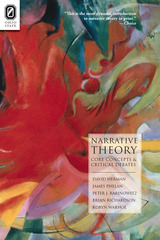 Narrative Theory: Core Concepts and Critical Debates
David Herman
Ohio State University Press, 2012 Narrative Theory: Core Concepts and Critical Debates addresses two frequently asked questions about narrative studies: “what is narrative theory?” and “how do different approaches to narrative relate to each other?” In engaging with these questions, the book demonstrates the diversity and vitality of the field and promotes a broader dialogue about its assumptions, methods, and purposes. In Part One, the co-authors explore the scope and aims of narrative from four distinct perspectives: rhetorical (Phelan and Rabinowitz), feminist (Warhol), mind-oriented (Herman), and unnatural (Richardson). Using case studies (Huckleberry Finn, Persuasion, On Chesil Beach, and Midnight’s Children, respectively), the co-authors explain their different takes on the same core concepts: authors, narrators, narration; plot, time, and progression; space, setting, and perspective; character; reception and the reader; and narrative values. In Part Two, the co-authors respond to one another’s views. As they discuss the relation of the approaches to each other, they highlight significant current debates and map out key developments in the field. Accessibly written, Narrative Theory can serve as the basis for a wide range of courses, even as its incisive presentation of four major approaches and its lively give-and-take about the powers and limitations of each make the book an indispensable resource for specialists.
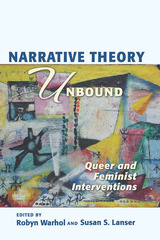 Narrative Theory Unbound: Queer and Feminist Interventions
Edited by Robyn Warhol and Susan S. Lanser
Ohio State University Press, 2015 Under the bold banner of Narrative Theory Unbound: Queer and Feminist Interventions, editors Robyn Warhol and Susan S. Lanser gather a diverse spectrum of queer and feminist challenges to the theory and interpretation of narrative. The first edited collection to bring feminist, queer, and narrative theories into direct conversation with one another, this anthology places gender and sexuality at the center of contemporary theorizing about the production, reception, forms, and functions of narrative texts.
Through twenty-one essays prefaced by a cogent history of the field, Narrative Theory Unbound offers new perspectives on narrative discourse and its constituent elements; on intersectional approaches that recognize race, religion, and national culture as integral to understanding sexuality and gender; on queer temporalities; on cognitive research; and on lifewriting in graphic, print, and digital constellations. Exploring genres ranging from reality TV to fairy tales to classical fiction, contributors explore the thorny, contested relationships between feminist and queer theory, on the one hand, and between feminist/queer theory and contemporary narratologies, on the other. Rather than aiming for cohesiveness or conclusiveness, the collection stages open-ended debates designed to unbind the assumptions that have kept gender and sexuality on the periphery of narrative theory.
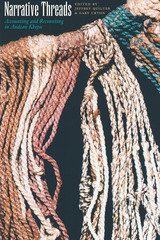 Narrative Threads: Accounting and Recounting in Andean Khipu
Edited by Jeffrey Quilter and Gary Urton
University of Texas Press, 2002 The Inka Empire stretched over much of the length and breadth of the South American Andes, encompassed elaborately planned cities linked by a complex network of roads and messengers, and created astonishing works of architecture and artistry and a compelling mythology—all without the aid of a graphic writing system. Instead, the Inkas' records consisted of devices made of knotted and dyed strings—called khipu—on which they recorded information pertaining to the organization and history of their empire. Despite more than a century of research on these remarkable devices, the khipu remain largely undeciphered. In this benchmark book, twelve international scholars tackle the most vexed question in khipu studies: how did the Inkas record and transmit narrative records by means of knotted strings? The authors approach the problem from a variety of angles. Several essays mine Spanish colonial sources for details about the kinds of narrative encoded in the khipu. Others look at the uses to which khipu were put before and after the Conquest, as well as their current use in some contemporary Andean communities. Still others analyze the formal characteristics of khipu and seek to explain how they encode various kinds of numerical and narrative data.
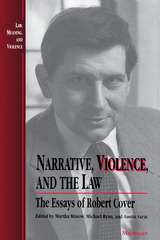 Narrative, Violence, and the Law: The Essays of Robert Cover
Martha Minow, Michael Ryan, and Austin Sarat, Editors
University of Michigan Press, 1995 "Bob Cover was and remains the dominant voice of his generation among legal scholars. These essays, each one magnificent in itself, are, when taken together, even more important. The wisdom they impart is forever." --Guido Calabresi, Dean and Sterling Professor of Law, Yale University
"Robert Cover drew his sources for the authority of law--for its violence, but also for its paideic potential--from the structuring stories that spark our communal imaginations. Literally until the day of his untimely death, his irreplaceably restless spirit was binding itself with the pages of the Midrash, of The Brothers Karamazov, of Billy Budd, Sailor. It is for us now to work also with these--Bob Cover's stories."--Richard Weisberg, Benjamin N. Cardozo Law School, Yeshiva University
"The writings of Robert Cover were usually provocative, sometimes exasperating, but always relevant. In his last years, he concentrated on Jewish sources as well as mystical and Messianic thought. This collection of his articles is a thesaurus of some of his finest writings."--Robert F. Drinan, S.J., Georgetown University Law Center
The late Robert Cover was Professor of Law, Yale Law School. Martha Minow is Professor of Law, Harvard Law School. Michael Ryan is Professor of English, Northeastern University. Austin Sarat is William Nelson Cromwell Professor of Jurisprudence and Political Science and Chair of the Program in Law, Jurisprudence, and Social Thought, Amherst College.
The Narrative Worlds of Paul the Deacon: Between Empires and Identities in Lombard Italy
Christopher Heath
Amsterdam University Press, 2017 Written as the Lombard kingdom was on the cusp of downfall at the hands of the Carolingian empire, the works of Paul the Deacon (c. 720-799) are vital to understanding the history of Italy and Western Europe in the Middle Ages. But until now, scholars have tended to neglect the narrative structure of his texts, which reflect in important ways his personal responses to the events of his time. This study presents fresh interpretations of Paul's Historia Romana, Vita Sancti Gregorii Magni, Gesta Episcopum Mettensium, and Historia Langobardorum by focusing on him as an individual and on his strategies of argumentation, ultimately advancing a new conception of Paul as a dynamic author whose development of multiple lines of thought deserves closer examination.
Narratives from the Crib
Katherine Nelson
Harvard University Press, 1989 THIS EDITION HAS BEEN REPLACED BY A NEWER EDITION.
Narratives from the Crib: With a New Foreword by Emily Oster, the Child in the Crib
Katherine Nelson
Harvard University Press, 2006 This classic psychological case study focuses on one talkative child’s emerging ability to use language, her capacity for understanding, for imagining, and for making inferences and solving problems. In wide-ranging essays, scholars offer multifaceted linguistic and psychological analyses of two-year-old Emily’s bedtime conversations with her parents and pre-sleep monologues, taped over a fifteen-month period. In a foreword written for this new edition, Emily, now an adult, reflects on the experience of having been a research subject without knowing it.
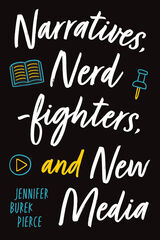 Narratives, Nerdfighters, and New Media
Jennifer Burek Pierce
University of Iowa Press, 2020 For decades, we’ve been warned that video killed the radio star, and, more recently, that social media has replaced reading. Nerdfighteria, a first-of-its-kind online literary community with nearly three million members, challenges these assumptions. It is the brainchild of brothers Hank and John Green, who provide literary themed programming on their website and YouTube channel, including video clips from John, a best-selling author most famous for his young adult book, The Fault in Our Stars. These clips not only give fans personal insights into his works and the writing process writ large, they also provide unique access to the author, inspiring fans to create their own fan art and make connections with one another. In the twenty-first century, reading and watching videos are related activities that allow people to engage with authors and other readers. Whether they turn to The Fault in Our Stars or titles by lesser-known authors, Nerdfighters are readers. Incorporating thousands of testimonials about what they read and why, Jennifer Burek Pierce not only sheds light on this particular online community, she also reveals what it tells us about the changing nature of reading in the digital age. In Nerdfighteria, we find a community who shows us that being online doesn’t mean disinterest in books.
 Narratives of Adversity: Jesuits on the Eastern Peripheries of the Habsburg Realms (1640–1773)
Paul J. Shore
Central European University Press, 2012 Addresses the experience of Jesuit missionaries, teachers and writers along the peripheries of the Habsburg lands, which stretched to Moldavia, Ukraine, Serbia and Wallachia, and which were continually torn with ethnic tensions. The time scale of the study is from the "high tide" of the Society (often labeled "the first multinational corporation") in the fourth decade of the seventeenth century, until its suppression in 1773 by Pope Clement XIV. The book examines several of the communities situated along the periphery and the records that they left behind about their interactions with the local populations. It constructs a vivid picture of Jesuit life on the frontier that is built up in mosaic fashion and livened by compelling anecdotes. The Jesuits of Royal Hungary exercised a baroque expression modeled after the larger western cities of the Habsburg lands, which was a fragile splendor in part defined by the need to defend Catholicism from the hostility of Orthodox, Lutherans, Calvinists, and others.
 Narratives of Debt
Peter Szendy, special issue editor
Duke University Press, 2020 As the problem of debt grows more and more urgent in light of the central role it plays in neoliberal capitalism, scholars have analyzed debt using numerous approaches: historical analysis, legal arguments, psychoanalytic readings, claims for reparations in postcolonial debates, and more. Contributors to this special issue of differences argue that these diverse approaches presuppose a fundamental connection between indebtedness and narrative. They see debt as a promise that refers to the future—deferred repayment that purports to make good on a past deficit—which implies a narrative in a way that other forms of exchange may not. The authors approach this intertwining of debt and narration from the perspectives of continental philosophy, international law, the history of slavery, comparative literature, feminist critique, and more.
Contributors. Arjun Appadurai, Anthony Bogues, Emmanuel Bouju, Silvia Federici, Mikkel Krause Frantzen, Raphaelle Guidée, Odette Lienau, Catherine Malabou, Vincent Message, Laura Odello, Peter Szendy, Frederik Tygstrup
 Narratives of (Dis)Enfranchisement: Reckoning with the History of Libraries and the Black and African American Experience
Tracey Overbey and Amanda L. Folk
American Library Association, 2022 This first Special Report in a two-volume set on Black and African Americans’ experiences in libraries provides an overview of their historical exclusion from libraries and educational institutions in the United States, also exploring the ways in which this legacy is manifest in our contemporary context. A compelling call to action, it will serve as the beginning of many conversations in which librarianship reckons with its racist past to move towards a more equitable future. Still a predominantly white profession, librarianship has a legacy of racial discrimination, and it is essential that we face the ways that race impacts how we meet the needs of diverse user communities. Identifying and acknowledging implicit and learned bias is a necessary step toward transforming not only our professional practice but also our scholarship, assessment, and evaluation practices. From this Special Report, readers will - learn the hidden history of Africa’s contributions to libraries and educational institutions, which are often omitted from K-12, higher education, and library school curricula;
- engage with the racist legacies of libraries as well as contemporary scholarship related to Black and African American users’ experiences with libraries;
- be introduced to frameworks and theories that can help to identify and unpack the role of race in librarianship and in library users’ experiences; and
- garner practical takeaways to bring to their own views and practice of librarianship.
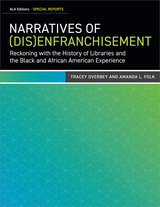 Narratives of (Dis)Engagement: Exploring Black and African American Students’ Experiences in Libraries
Amanda L. Folk and Tracey Overbey
American Library Association, 2022 Librarianship is still a predominantly white profession. It is essential that current practitioners as well as those about to enter the field take an unflinching look at the profession’s legacy of racial discrimination, including the ways in which race might impact service to users such as students in school, public, and academic libraries. Given the prevalence of implicit and explicit bias against Black and African American people, authors Folk and Overbey argue that we must speak to these students directly to hear their stories and thereby understand their experiences. This Special Report shares the findings of a qualitative research study that explored the library experiences of Black and African American undergraduate students both before and during college, grounding it within an equity framework. From this Report readers will - learn details about the study, which focused on the potential role of race in the students’ interactions with library staff, including white staff and staff of color;
- gain insight into Black and African American users’ perceptions of libraries and library staff, attitudes towards reading, frequency of library usage, and the importance of family;
- understand the implications of the study’s findings for our practice and for librarianship more broadly, including our ongoing commitment to diversifying the profession; and
- walk away with recommendations that can be applied to every library and educational context, such as guidance for developing an antiracist organization and more equitable service provision.
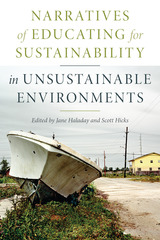 Narratives of Educating for Sustainability in Unsustainable Environments
Jane Haladay
Michigan State University Press, 2017 Through pedagogical narratives, literary analyses, reflective essays, and collaborative dialogues, Narratives of Educating for Sustainability in Unsustainable Environments explores the professional and intellectual tensions of curricula, pedagogies, and personal practices that honor the relationships of interspecies ecologies, reinhabit and reconceive wounded landscapes and wounding institutions, and allow us to reattune ourselves to new yet ancient frameworks for sustainability. For the writers here, fostering sustainability in higher education means focusing on place, creating positive relationships with humans and other beings, and creating administrative structures that will maintain new approaches for the long-term, showing how teaching environmentally is at once intensely site-specific yet powerfully global, deeply personal yet visibly public. Narratives of Educating for Sustainability in Unsustainable Environments confronts the contexts that make environmental pedagogies difficult, the challenges to the well-being of the teacher-scholar, and the corrosive academic structures that compartmentalize knowledge and people. The collection simultaneously offers models for working through and within these challenges to advance understandings and ways of being on local, global, and personal levels that will turn the planetary tide toward effective and shared sustainability.
 Narratives of Exile and Identity: Soviet Deportation Memoirs from the Baltic States
Tomas Balkelis
Central European University Press, 2018 In an innovative effort to situate Baltic testimonies to the Gulag in the broader international context of research on displacement and memory, scholars from the Baltic States, Western Europe, Canada, and the United States seek answers to the following questions: Do different groups of deportees experience deportation differently? How do the accounts of women, children and men differ in their representation? Do various ethnic groups remember the past differently: how do they use historical and cultural paradigms to structure their experience in unique ways? The scholars researched the archives, read testimonies, interviewed former deportees, and examined artifacts of memory produced since the late 1980s, applying crossdisciplinary approaches used at the study of the Holocaust testimonies; the testimonies of women have received a particular emphasis. The essays in the book also examine the issues of transmittance, commemoration and public uses of the memory of deportations in contemporary social, cultural and political contexts of Baltic societies, including the reflection of Gulag legacy in literature, the cinema and museums.
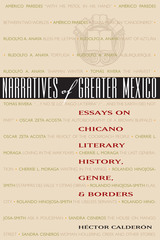 Narratives of Greater Mexico: Essays on Chicano Literary History, Genre, and Borders
By Héctor Calderón
University of Texas Press, 2005 Once relegated to the borders of literature—neither Mexican nor truly American—Chicana/o writers have always been in the vanguard of change, articulating the multicultural ethnicities, shifting identities, border realities, and even postmodern anxieties and hostilities that already characterize the twenty-first century. Indeed, it is Chicana/o writers' very in-between-ness that makes them authentic spokespersons for an America that is becoming increasingly Mexican/Latin American and for a Mexico that is ever more Americanized. In this pioneering study, Héctor Calderón looks at seven Chicana and Chicano writers whose narratives constitute what he terms an American Mexican literature. Drawing on the concept of "Greater Mexican" culture first articulated by Américo Paredes, Calderón explores how the works of Paredes, Rudolfo Anaya, Tomás Rivera, Oscar Zeta Acosta, Cherríe Moraga, Rolando Hinojosa, and Sandra Cisneros derive from Mexican literary traditions and genres that reach all the way back to the colonial era. His readings cover a wide span of time (1892-2001), from the invention of the Spanish Southwest in the nineteenth century to the América Mexicana that is currently emerging on both sides of the border. In addition to his own readings of the works, Calderón also includes the writers' perspectives on their place in American/Mexican literature through excerpts from their personal papers and interviews, correspondence, and e-mail exchanges he conducted with most of them.
Narratives of Joy and Failure in Antiracist Assessment: Exploring Collaborative Writing Assessments
Asao B. Inoue
University Press of Colorado, 2024 When teachers with antiracist goals invite students to share in assessment practices, they open up possibilities to reflect on their own and their students’ politics and subjectivities. The contributors to Narratives of Joy and Failure in Antiracist Assessment share their reflections on their efforts to engage in this collaboration. The chapters in this edited collection consider three central questions: How might writing teachers and students account for their own intersectional embodied subjectivities in collaborative writing assessment practices? What roles do the politics of judgement play in assessment ecologies where students collaborate with the teacher? Broadly speaking, how might writing teachers and students with antiracist goals navigate the complexities and tensions that arise through collaborative writing assessment practices?
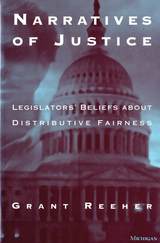 Narratives of Justice: Legislators' Beliefs about Distributive Fairness
Grant Reeher
University of Michigan Press, 1996 Narratives of Justice offers a provocative, contemporary look at the timeless questions of justice and fairness. Using face-to-face interviews, Grant Reeher plumbs the minds of legislators for their beliefs about distributive justice and attempts to discover the ways in which those beliefs influence their behavior. The book calls into question many notions of American political ideology and, in particular, the idea of an "American exceptionalism" regarding views from the political left, and the dominance in the United States of a "liberal tradition." Political philosophers have amassed a large body of work on justice and fairness from a theoretical perspective, but there is comparatively little empirical work on the subject. The work that does exist concentrates on the beliefs of the public. We know very little concerning the beliefs about justice held by political elites. This work offers a window into the beliefs of legislators, a group for which such an inquiry is rarely undertaken. The book is based on a set of extended, in-depth interviews with the members of the Connecticut State Senate as well as a year of close observation of the Senate in action. The interviews averaged four hours in length and covered a variety of topics related to fairness. Through this material, Reeher employs a narrative-based framework to understand the patterns in the senators' interview responses, and develops a typology of the senator's narratives. These narratives vary in both content and form, and as a whole present a surprising range of views. Narratives of Justice will be of interest to those concerned with justice, political ideologies, and political beliefs, as well as state and local politics and, more generally, American politics. Its wide research and thorough documentation make it a useful guide to the literature within and beyond political science concerning beliefs, ideologies, legislative behavior, and qualitative research methods. Grant Reeher is Assistant Professor, Maxwell School of Citizenship and Public Affairs, Department of Political Science, Syracuse University, and currently a Robert Wood Johnson Foundation Scholar in Health Policy Research, University of Michigan.
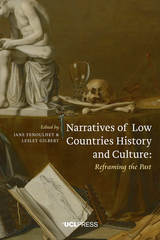 Narratives of Low Countries History and Culture: Reframing the Past
Edited by Jane Fenoulhet and Lesley Gilbert
University College London, 2016 This edited collection explores the ways in which our understanding of the past in Dutch history and culture can be rethought to consider not only how it forms part of the present but how it can relate also to the future. Divided into three parts – The Uses of Myth and History, The Past as Illumination of Cultural Context, and Historiography in Focus – this book seeks to demonstrate the importance of the past by investigating the transmission of culture and its transformations. It reflects on the history of historiography and looks critically at the products of the historiographic process, such as Dutch and Afrikaans literary history. The chapters cover a range of disciplines and approaches: some authors offer a broad view of a particular period, such as Jonathan Israel's contribution on myth and history in the ideological politics of the Dutch Golden Age, while others zoom in on specific genres, texts or historical moments, such as Benjamin Schmidt’s study of the doolhof, a word that today means ‘labyrinth’ but once described a 17th-century educational amusement park. This volume, enlightening and home to multiple paths of enquiry leading in different directions, is an excellent example of what a past-present doolhof might look like.
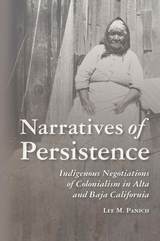 Narratives of Persistence: Indigenous Negotiations of Colonialism in Alta and Baja California
Lee M. Panich
University of Arizona Press, 2020 The Ohlone of the San Francisco Bay area and the Paipai of northern Baja California occupy opposite ends of the spectrum of Native Californian identities. Or so it would appear. While the Ohlone lack popular recognition and official acknowledgement from the United States government, the Paipai occupy a large reserve and celebrate their ongoing cultural traditions throughout Baja California and southern California. Yet the two groups share a similar colonial history: entanglements with early European explorers, labor and enculturation at Spanish missions, and sustained interactions with American and Mexican settler colonialism. Based on fifteen years of archaeological and historical research in the two regions, Narratives of Persistence charts the remarkable persistence of the Ohlone and Paipai alongside a synthesis of Native Californian endurance over the past five centuries. As the case studies demonstrate, Ohlone and Paipai people made intelligent and culturally appropriate choices to cope with the impact of colonialism on their communities, even as they took different pathways to the present day. Lee M. Panich illustrates how changes in Native identity and practice within these colonial contexts were made to best conduct the groups’ lives within shifting sets of colonial constraints. He draws connections between the events and processes of the deeper past and the way the Ohlone and Paipai today understand their own histories and identities, offering a model for how scholars of Indigenous histories may think about the connections between the past and the present.
 Narratives Unbound: Historical studies in post-communist Eastern Europe
Péter Apor
Central European University Press, 2007 The first work that covers the post-Communist development of historical studies in six Eastern European countries: Bulgaria, Czech Republic, Hungary, Poland, Romania, and Slovakia. A uniquely critical and qualitative analysis from a comparative and critical perspective, written by scholars from the region itself. Focusing on the first post-Communist decade, 1989–1999, the book offers a longer-term perspective that includes the immediate 'prehistory' of that momentous decade as well as its 'posthistoire'. The authors capture the spirit of 1989, that heady mix of elation, surprise, determination, and hope: l'ivresse du possible. This was the paradoxical beginning of Eastern European post-Communism: ushered in by 'anti-Utopian' revolutions, and slowly finding its course towards a bureaucratic, imitative, challenging, and anachronistic restoration of a capitalism that had changed almost beyond recognition when it had mutated into the negative double of Communism. Each individual chapter has numerous and detailed notes and references.
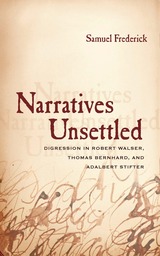 Narratives Unsettled: Digression in Robert Walser, Thomas Bernhard, and Adalbert Stifter
Samuel Frederick
Northwestern University Press, 2012 In Narratives Unsettled, Samuel Frederick proposes a new conception of narrativity that can accommodate unwieldy forms of digression. By way of close readings of three German-language writers from different historical periods, Frederick demonstrates that digression, far from being a non- or anti-narrative interruption, contributes to what makes these writers' works fundamentally narrative. In the process, the author counters several foundational assumptions of classical narratology, including the conviction—rooted in Aristotle—that narrative without plot is logically impossible, and that anything deviating from narrative's teleological imperative is either destructive or insignificant.
Frederick's readings of the narrative experiments, utopian moments, and obsessions with the trivial in works by Walser, Bernhard, and Stifter point to new ways of approaching the ostensibly antinarrative as a productive element of narrativity. As a work that explores the often neglected crossroads of German studies and postclassical narratology, Narratives Unsettled will be of great interest to scholars in both of these fields, as well as to those working on literature and theory in general.
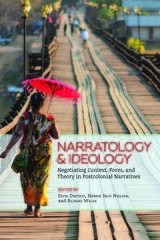 Narratology and Ideology: Negotiating Context, Form, and Theory in Postcolonial Narratives
Divya Dwivedi
Ohio State University Press, 2018 Narratology and Ideology: Negotiating Context, Form, and Theory in Postcolonial Narratives, edited by Divya Dwivedi, Henrik Skov Nielsen, and Richard Walsh, brings together many of the most prominent figures in the interface between narratology and postcolonial criticism. While narrative theory has for some time recognized the importance of context in the analysis of fiction, this recognition has not quickly translated into substantial work in fields like postcolonialism, where situated questions of value and ideology have been brought to the fore. Postcolonial criticism, on the other hand, has often neglected the formal qualities of fiction in preference for ideological thematic interpretations, precisely because of the suspect legacy of formalism. The volume, then, stages a meeting between these two fields, negotiating both narratological and postcolonialist concerns by addressing specific features of narrative form and technique in the ideological analysis of key postcolonial texts.
The thirteen essays in Narratology and Ideology offer compelling readings of individual novels, with a focus upon South Asian literature, that provide a cumulative case study on the value of postcolonial narratology. The essays show not only how narrative theory can be productively applied in service of postcolonial criticism but also how such attention to postcolonial fictions can challenge and refine our theoretical understanding of narrative.
 The Narrators of Barbarian History (A.D. 550-800): Jordanes, Gregory of Tours, Bede, and Paul the Deacon
Walter Goffart
University of Notre Dame Press, 2005 In this substantial work Walter Goffart treats the four writers who provide the principal narrative sources for our early knowledge of the Ostrogoths, Franks, Anglo-Saxons, and Lombards: Jordanes, Gregory of Tours, Bede, and Paul the Deacon. The University of Notre Dame Press is pleased to make this book available for the first time in paperback.
“The title Narrators of Barbarian History speaks to a modern audience in the terms with which it is familiar, but it should not be understood to mean that the authors in question wrote a type of history sharply contrasting in subject to that practiced in earlier centuries. That Jordanes and his peers were concerned with Goths and other ‘barbarians,’ though not an incidental detail, is not the main reason for studying them. The Constantinopolitan perspective of Jordanes overshadows his Gothic theme. Gregory of Tours was primarily concerned with current events rather than with the Franks, and he was intent on portraying the depravity of all men rather than of a subgroup among them. Bede was Northumbrian rather than English and cared more about the Christian face of his compatriots than about their ethnic peculiarities. Paul waited so long to write about his fellow Lombards, applying his pen to other subjects, that he left their history unfinished. Our four authors are less compelling for occasionally addressing themselves to the peoples whom we call Germanic barbarians than they are for being the leading practitioners of narrative history in Latin within the two hundred fifty years that separate Justinian, for whom Jordanes may have worked, from Charlemagne, at whose court Paul the Deacon briefly sojourned.” — from the original introduction
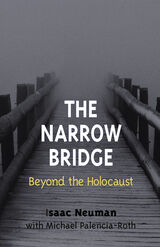 The Narrow Bridge: Beyond the Holocaust
Isaac Neuman, with Michael Palencia-Roth
University of Illinois Press, 2000 As a boy studying Torah, Isaac Neuman learned to seek the spiritual lessons hidden in everyday life. Likewise, in this narrative of occupation and holocaust, he uncovers a core of human decency and spiritual strength that inhumanity, starvation, and even death failed to extinguish. Unlike many Holocaust memoirs that focus on physical suffering and endurance, The Narrow Bridge follows a spiritual journey. Neuman describes the world of Polish Jewry before and during the Holocaust, recreating the strong religious and secular personalities of his childhood and early youth in Zdunska Wola, Poland: the outcast butcher, Haskel Traskalawski; the savvy criminal-turned-entrepreneur Nochem Ellia; the trusted Dr. Lemberg, liaison to the German occupation government; and Neuman's beloved teacher, Reb Mendel. Through their stories, Neuman reveals the workings of a community tested to the limits of faith and human dignity. With his brother Yossel, Neuman was transported to the Poznan area, first to the Yunikowo work camp in May 1941, then on to St. Martin's Cemetery camp, where they removed gold jewelry and fillings from exhumed corpses. A string of concentration camps followed, each more oppressive than the last: Fürstenfelde, Auschwitz, Fünfteichen, Gross Rosen, Mauthausen, Wels, and Ebensee. In the midst of these horrors, the brothers kept their feet on the "narrow bridge" of life by holding to their faith, their memories, and each other. In the end, only Isaac survived. The Narrow Bridge celebrates symbolic victories of faith over brute force. The execution of Zdunska Wola's Jewish spiritual and intellectual leaders is trumped by an act of breathtaking courage and conviction. A secret Passover Seder is cobbled together from hoarded bits of wax, piecemeal prayers, and matzoh baked in delousing ovens. A dying fellow inmate gives Neuman his warm coat as they both lie freezing on the ground. Such rituals of faith and acts of kindness, combined with boyhood memories and a sense of spiritual responsibility, sustained Neuman through the Holocaust and helped him to reconstruct his life after the war. His story is a powerful testimony to an unquenchable faith and a spirit tried by fire.
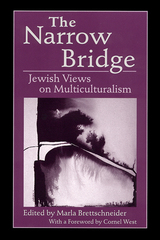 The Narrow Bridge: Jewish Views on Multiculturalism
Brettschneider, Marla
Rutgers University Press, 1996 Multiculturalism in the United States has been tricky for Jews. Remaining outside of the dominant Christian culture yet often excluded from multicultural agendas, Jews walk a precarious line––a narrow bridge––between dominance and marginality. Many Jews, aware of the shaky identity of Jewishness, are deeply involved in all levels of the multiculturalism debate. But there still exists a need for careful, reflective analysis of the importance and dangers of multiculturalism to the Jewish community. What is multiculturalism? What can it be to the Jews? What can the Jewish community learn from and contribute to the current debate? Through a collection of essays by scholars and activists whose writing ranges from the personal to the philosophical, The Narrow Bridge examines multiculturalism within and beyond the Jewish community. How does classism work within the Jewish community? How can synagogues reach out to gays and lesbians? How have tensions between Jews and Blacks developed historically and what can we learn from that history? How can we include Jewish studies in multicultural curricula? This timely collection of provocative articles makes fine use of these and other questions, offering us a look at where Jews have stood, where they now stand, and what they can hope for in the complex arena of multiculturalism.
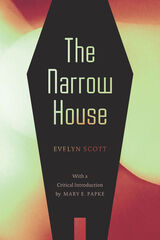 The Narrow House
Mary E. Papke
University of Tennessee Press, 2021 Evelyn Scott’s first novel, The Narrow House, depicts a family stricken by dysfunctional domesticity. Revolving around troubled members of the Farley family, Scott exposes notions of romantic love, longing, and the image of the Southern belle as damaging, unrealistic constructs, all against the backdrop of a seemingly normal middle-class existence that in previous decades had been idealized in Southern writing. Published to high praise when it appeared in 1921, The Narrow House vaulted Scott to literary celebrity in her day.
In this new critical edition, Mary E. Papke contextualizes Scott’s first and possibly best writing effort with an astute introduction that discusses Scott and her contemporaries, the work’s importance to the genre of the novel, and the small but ongoing reclamation of Scott’s place in literary history. Completely updated and formatted for a modern readership, this critical edition of The Narrow House is sure to find its way into classrooms and onto bookshelves.
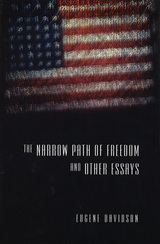 The Narrow Path of Freedom and Other Essays
Eugene Davidson
University of Missouri Press, 2002 Eugene Davidson’s final book, The Narrow Path of Freedom and Other Essays, examines historical instances of man’s inhumanity to man, providing poignant insight that we can profit from as we contemplate an ongoing battle against terrorism. A superb essayist, Davidson here displays an extraordinary range. Long a student of international relations, he writes of the Nuremberg trials after World War II and, as the book’s title indicates, of the narrow path of freedom that the democracies have had to travel during the last half century. The path allowed little stumbling, lest they would fall into the errors that disgraced the dictatorships. Davidson wears his wisdom lightly, delighting a reader with touches of humor and with wry, startlingly appropriate comparisons. A second set of essays examines the idea of history as it has survived into our present time, including what Davidson describes as the “thin coat of higher learning” in a commencement address in which he advises young men and women to listen to dissent and make up their own minds. As Davidson says, “The war of ideas is far from over, and every coming generation will have to bear its own share of the burden in the endless struggle for the survival of freedom.” Last is a group of reminiscent essays. One recounts a friendship with the historian Charles A. Beard, who proposed to the young Davidson that he call him Uncle Charlie. In another Davidson plumbs the personality of a major figure of the Nazi era, Albert Speer. He also discusses the pathetic and perhaps demented Ezra Pound, whose genius as a poet may have been questionable but whose ability to survive was remarkable. The Narrow Path of Freedom and Other Essays is a valuable guide for all who try to keep the idea of freedom alive. The pieces in it are nothing less than a triumph—historical, literary, philosophical. By confronting the idea of history—what the past should mean—Davidson gives us a book that will last well into our already turbulent new century.
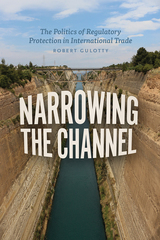 Narrowing the Channel: The Politics of Regulatory Protection in International Trade
Robert Gulotty
University of Chicago Press, 2020 While large, multinational corporations have supported the removal of tariffs, behind the scenes these firms have fought for protection in the form of product regulations, including testing, labeling, and registration requirements. Unlike tariffs, these regulations can raise fixed costs, excluding smaller firms from the market and shifting profits toward global giants.
Narrowing the Channel demonstrates that globalization and globalized firms can paradoxically hinder rather than foster economic cooperation as larger firms seek to protect their markets through often unnecessarily strict product regulations. To illustrate the problem of regulatory protectionism, Robert Gulotty offers an in-depth analysis of contemporary rulemaking in the United States and the European Union in the areas of health, safety, and environmental standards. He shows how large firms seek regulatory schemes that disproportionately disadvantage small firms. When multinationals are embedded in the local economy, governments too have an incentive to use these regulations to shift profits back home. Today, the key challenge to governing global trade is not how much trade occurs but who is allowed to participate, and this book shows that new rules will be needed to allow governments to widen the benefits of global commerce and avoid further inequality and market concentration.
The Narrows
Daniel Tobin
Four Way Books, 2005 Coming of age in Brooklyn's Bay Ridge, these poems explore what it is to be an Irish American Catholic; a dutiful son of hard drinking, sometimes hilarious and sometimes tragic parents; a son of Brooklyn; and, too, deeply rooted to the country of his ancestors, Ireland. Dark, funny, and sometimes troubling, these poems, always accessible, track a life well lived and felt.
The Narrows: A Novel
Ann Petry, introduction by Keith Clark
Northwestern University Press, 2017
When Link Williams, a college-educated twenty-six-year old African American man, falls for Camilla Sheffield, a wealthy married white woman, things will never be the same in the sleepy New England town of Monmouth, Connecticut. Set in the 1950s, this unforgettable classic deftly evokes a tragic love affair and offers a window onto the powerful ways in which class and race intersected in midcentury America.
Nashville, 1900 to 1910
William Waller
Vanderbilt University Press, 1972 Now back in print! The stories of Nashville at the turn of the century in the voices of the people who lived them.
 Nashville Architecture: A Guide to the City
Carroll Van West
University of Tennessee Press, 2015 “This book is one that all residents of Nashville—and visitors, too—are going to want to have on their bookshelves.” —Don H. Doyle, author of Nashville since the 1920s
Since the turn of the eighteenth century, social movements and technological advances have strongly impacted cosmopolitan identity in America. Nashville, in particular, has experienced one transformation after another as change continues to propel history forward. Settlement during the 1700s, war and Reconstruction during the 1800s, and increased immigration, New Deal programs, and the invention of the automobile during the 1900s—these and many other shifts have made Nashville a hub for transportation, trade, and multicultural relations.
Much has changed since the settlements of the late eighteenth century, but modern Nashville is still celebrated for its diversity, commerce, and transportation. The passing of time is etched in the city’s physical identity, juxtaposing the old with the new to demonstrate Nashville’s rich history alongside its transformation into modernity.
In Nashville Architecture: A Guide to the City, Carroll Van West examines over 250 properties in Nashville—including well-known buildings such as the Ryman Auditorium, the Hermitage Hotel, and Jubilee Hall at Fisk, as well as many other lesser known properties that outline the city’s architectural metamorphosis over the course of the past 200 years. From schools and churches to banks and post offices, from apartment and office buildings to plantations and cemeteries, West surveys a wide variety of architectural sites that are found across Nashville and the greater Davidson County area.
Illustrating his examination with over 150 maps and photographs, West provides a comprehensive architectural guide unlike any before it. An invaluable resource for scholars and travelers alike, this book illustrates Nashville’s transformation into the cosmopolitan city that it is today, reminding us that we are surrounded by stories of history and change. It unveils a legacy much deeper than architectural style; it reveals a legacy of evolution, reminding us that architecture examines much more than the concrete properties visible to the eye.
Carroll Van West is Tennessee State Historian and the director of the Center for Historic Preservation at Middle Tennessee State University. He is the author of numerous books about Tennessee, including Tennessee’s Historic Landscapes and A History of Tennessee Arts. He is the editor of the print and online editions of the Tennessee Encyclopedia of History and Culture.
Nashville in the 1890s
William Waller
Vanderbilt University Press, 1970 Derived from first-hand accounts and oral histories collected and stored at Vanderbilt University as well as newspapers and other local history sources, this collection is an invaluable look at the “Gay Nineties” in Nashvillians’ own words.
It is, however, not a complete insight into Nashville in the 1890s. Readers should take note that the book focuses almost exclusively on the experiences and worldviews of white Nashvillians. These stories have incredible value for local historians and anyone interested in Nashville history, but the book’s failure to deal with race—as evidenced by Waller’s belief that “the social order was thought to be providential,” which was clearly not true for Nashville’s Black residents who struggled against the unjust systems designed to oppress them—is a grave shortcoming.
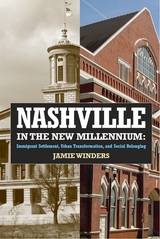 Nashville in the New Millennium: Immigrant Settlement, Urban Transformation, and Social Belonging
Jamie Winders
Russell Sage Foundation, 2013 Beginning in the 1990s, the geography of Latino migration to and within the United States started to shift. Immigrants from Central and South America increasingly bypassed the traditional gateway cities to settle in small cities, towns, and rural areas throughout the nation, particularly in the South. One popular new destination—Nashville, Tennessee—saw its Hispanic population increase by over 400 percent between 1990 and 2000. Nashville, like many other such new immigrant destinations, had little to no history of incorporating immigrants into local life. How did Nashville, as a city and society, respond to immigrant settlement? How did Latino immigrants come to understand their place in Nashville in the midst of this remarkable demographic change? In Nashville in the New Millennium, geographer Jamie Winders offers one of the first extended studies of the cultural, racial, and institutional politics of immigrant incorporation in a new urban destination. Moving from schools to neighborhoods to Nashville’s wider civic institutions, Nashville in the New Millennium details how Nashville’s long-term residents and its new immigrants experienced daily life as it transformed into a multicultural city with a new cosmopolitanism. Using an impressive array of methods, including archival work, interviews, and participant observation, Winders offers a fine-grained analysis of the importance of historical context, collective memories and shared social spaces in the process of immigrant incorporation. Lacking a shared memory of immigrant settlement, Nashville’s long-term residents turned to local history to explain and interpret a new Latino presence. A site where Latino day laborers gathered, for example, became a flashpoint in Nashville’s politics of immigration in part because the area had once been a popular gathering place for area teenagers in the 1960s and 1970s. Teachers also drew from local historical memories, particularly the busing era, to make sense of their newly multicultural student body. They struggled, however, to help immigrant students relate to the region’s complicated racial past, especially during history lessons on the Jim Crow era and the Civil Rights movement. When Winders turns to life in Nashville’s neighborhoods, she finds that many Latino immigrants opted to be quiet in public, partly in response to negative stereotypes of Hispanics across Nashville. Long-term residents, however, viewed this silence as evidence of a failure to adapt to local norms of being neighborly. Filled with voices from both long-term residents and Latino immigrants, Nashville in the New Millennium offers an intimate portrait of the changing geography of immigrant settlement in America. It provides a comprehensive picture of Latino migration’s impact on race relations in the country and is an especially valuable contribution to the study of race and ethnicity in the South.
 Nashville Metro: The Politics of City-County Consolidation
Brett W. Hawkins
Vanderbilt University Press, 2024 As Nashville's governance is under increasing scrutiny by the Tennessee General Assembly, many Nashvillians are struggling to understand what our metropolitan form of government is and why we chose to reorganize our city this way in 1963. Nashville Metro was first published in the aftermath of that decision, and it provides a comprehensive record of what the city understood itself to be doing at the time. How did it happen? When so many less thoroughgoing reforms had failed elsewhere, how could Nashville accomplish a complete city‑county consolidation? Why in Nashville did the voters outside the central city support consolidation, when in area after area it is typically these voters who defeat reform proposals? Why did the consolidation fail in 1958 and succeed in 1962? Nashville Metro was written to answer such questions. One great benefit to Brett W. Hawkins' approach is how he lays out what was conventional wisdom at the time and what was reported in the local papers and balances it against what participants told him directly.
This is a valuable artifact in itself, but the new foreword by Judge David Briley—former Nashville mayor and grandson of the first metro Nashville mayor, Beverly Briley—offers a firsthand account of the realities of metropolitan government sixty years on.
 Nashville Native Orchids: Astonishing Science and Mysterious Folklore
Soraya Cates Parr
Vanderbilt University Press, 2024 Hidden in the greenways, parks, and backyards of Nashville are several varieties of stunning native orchids. The vibrant, three-petaled flower has been revered for centuries for its exoticism and inspirational qualities. But these natural treasures, long part of a rich folk tradition, have been largely forgotten by many Nashvillians. This useful guidebook offers a comprehensive look into the secret lives of Davidson County’s six native orchid species. Alongside vibrant, eye-catching photographs of plant life cycles that provide a straightforward way for readers to quickly identify these varieties, the book offers the fascinating history of these wild wonders as told by author Soraya Cates Parr, a passionate horticulturalist with a knack for explaining the natural world in an accessible way.
More than just a useful guide to Nashville’s flora, Nashville Native Orchids is a reminder of the risk that unbridled urban development can pose to the delicate natural ecosystem. Throughout the book, Parr shows the local effects of climate change on Nashville’s native orchid population and advocates for a more sustainable approach to development. Beyond the environmental dimensions, this book presents an illuminating discussion of the historical significance of orchids and their central role in folkloric traditions.
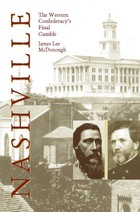 Nashville: The Western Confederacy's Final Gamble
James Lee Mcdonough
University of Tennessee Press, 2004 After Major General William Tecumseh Sherman’s forces ravaged Atlanta in 1864, Ulysses S. Grant urged him to complete the primary mission Grant had given him: to destroy the Confederate Army in Georgia. Attempting to draw the Union army north, General John Bell Hood’s Confederate forces focused their attacks on Sherman’s supply line, the railroad from Chattanooga, and then moved across north Alabama and into Tennessee. As Sherman initially followed Hood’s men to protect the railroad, Hood hoped to lure the Union forces out of the lower South and, perhaps more important, to recapture the long-occupied city of Nashville.
Though Hood managed to cut communication between Sherman and George H. Thomas’s Union forces by placing his troops across the railroads south of the city, Hood’s men were spread over a wide area and much of the Confederate cavalry was in Murfreesboro. Hood’s army was ultimately routed. Union forces pursued the Confederate troops for ten days until they recrossed the Tennessee River. The decimated Army of Tennessee (now numbering only about 15,000) retreated into northern Alabama and eventually Mississippi. Hood requested to be relieved of his command. Less than four months later, the war was over.
Written in a lively and engaging style, Nashville presents new interpretations of the critical issues of the battle. James Lee McDonough sheds light on how the Union army stole past the Confederate forces at Spring Hill and their subsequent clash, which left six Confederate generals dead. He offers insightful analysis of John Bell Hood’s overconfidence in his position and of the leadership and decision-making skills of principal players such as Sherman, George Henry Thomas, John M. Schofield, Hood, and others.
Within the pages of Nashville, McDonough’s subjects, both common soldiers and officers, present their unforgettable stories in their own words. Unlike most earlier studies of the battle of Nashville, McDonough’s account examines the contributions of black Union regiments and gives a detailed account of the battle itself as well as its place in the overall military campaign. Filled with new information from important primary sources and fresh insights, Nashville will become the definitive treatment of a crucial battleground of the Civil War.
James Lee McDonough is retired professor of history from Auburn University. He is the author of numerous books on the Civil War, including Shiloh—In Hell Before Night, Chattanooga—Death Grip on the Confederacy, and War in Kentucky: From Shiloh to Perryville.
|
|



